AILWAY G E



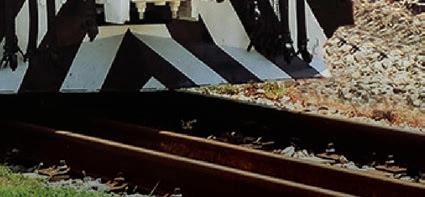
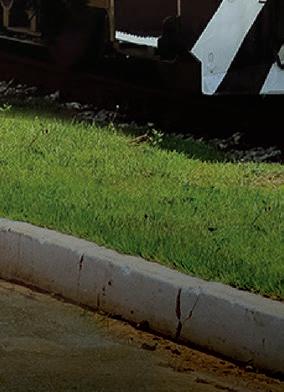
SERVING THE RAILWAY INDUSTRY SINCE 1856
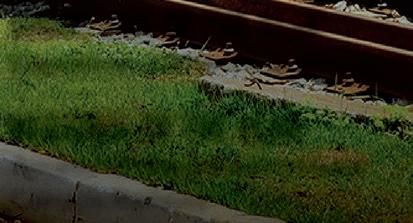
MOTIVE POWER NEXT-GEN

Examining, Evaluating Options

SHORT LINE OF THE YEAR
Napoleon, Defiance & Western
REGIONAL OF THE YEAR
ArcelorMittal Infrastructure
Canada Railway

WWW.RAILWAYAGE.COM
MARCH 2023
WHO SAYS LESS IS MORE? MORE IS MORE.

Marmon On-Site Services means one team, one point of contact, and a custom solution for gate-to-gate on-site and mobile rail services. No company o ers more to make your operations more e cient. We keep your world moving forward.
 Marmon On-Site Services Companies
Marmon On-Site Services Companies
Railway Age, USPS 449-130, is published monthly by the Simmons-Boardman Publishing Corporation, 1809 Capitol Avenue, Omaha, NE 68102. Tel. (212) 620-7200. Vol. 224, No. 3. Subscriptions: Railway Age is sent without obligation to professionals working in the railroad industry in the United States, Canada, and Mexico. However, the publisher reserves the right to limit the number of copies. Subscriptions should be requested on company letterhead. Subscription pricing to others for Print and/or Digital versions: $100.00 per year/$151.00 for two years in the U.S., Canada, and Mexico; $139.00 per year/$197.00 for two years, foreign. Single Copies: $36.00 per copy in the U.S., Canada, and Mexico/$128.00 foreign All subscriptions payable in advance. COPYRIGHT© 2023 Simmons-Boardman Publishing Corporation. All rights reserved. Contents may not be reproduced without permission. For reprint information contact PARS International Corp., 102 W. 38th Street, 6th floor, New York, N.Y. 10018, Tel.: 212-221-9595; Fax: 212-221-9195. Periodicals postage paid at New York, N.Y., and additional mailing offices. Canada Post Cust.#7204564; Agreement #41094515. Bleuchip International, PO Box 25542, London, ON
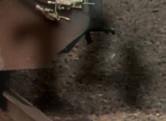

March 2023 // Railway Age 1
railwayage.com
N6C 6B2. Address all subscriptions, change of address forms and correspondence concerning subscriptions to Subscription Dept., Railway Age, PO Box 239 Lincolnshire IL 60069-0239 USA; railwayage@omeda.com; or call +1 (402) 346-4740; FAX +1 (847) 291-4816. Printed at Cummings Printing, Hooksett, N.H. ISSN 0033-8826 (print); 2161-511X (digital). FEATURES 9 14 16 17 41 44 52 56 59 Short Line of the Year Napoleon, Defiance & Western Regional of the Year ArcelorMittal Infrastructure Canada Railway Honorable Mention Aberdeen Carolina & Western Next-Gen Motive Power Examining, Evaluating Options Follow the Megawatt-Hours Hydrogen, Battery, or ... ? Tech Focus – Mechanical Couplers, Cushioning, Draft Gears Passenger Focus Northern California Timeout for Tech Anthropomorphic Materials MxV Rail R&D Wheel/Rail Friction RCFS Testing COMMENTARY 2 64 From the Editor Financial Edge DEPARTMENTS 4 6 7 61 62 62 63 Industry Indicators Industry Outlook Market People Professional Directory Classifieds Advertising Index COVER PHOTO Progress Rail EMD® Joule SD40JR battery-electric. Progress Rail photo March 2023 14 AILWAY
©ArcelorMittal Infrastructure Canada
GE
AILWAY GE
SUBSCRIPTIONS: 1 (402) 346-4740
Politics Pre-empting East Palestine
e interrupt this special report on the National Transportation Safety Board’s ongoing investigation into Norfolk Southern’s Feb. 3, 2023 derailment at East Palestine, Ohio, to clue you in on some same-old, same-old political initiatives from Washington, D.C., where, in a truth vs. fiction battle, fiction almost always gets the spotlight
I’ll begin with what I and many others in this industry see as the basics. The derailment, fire and release of hazardous materials into the environment and its effects on the East Palestine community are serious. The NTSB has determined a probable cause—a freight car wheel bearing burnoff—released its findings in a preliminary report, and should produce a final, detailed report within the next year or so. Until then, there is not enough information to make a final, truthful, fact-filled, research- and science-based decision on what exactly happened, and what the industry needs to do to prevent a future occurence. Norfolk Southern, as I see it, is doing everything it can to help the community recover and move on.
Unfortunately but not unexpectedly, there are those who have grabbed hold of this awful accident and attempted to get ahead of the NTSB. They’ve turned it into a vehicle to advance their own agendas, political or other, spreading, either from lack of knowledge, compromised ethics or both, bad information and exaggerations. The truth, which takes time to ascertain, is getting buried under a pile of political pronouncements and attempts to resurrect old, abandoned proposed regulations—namely, ECP brake requirements for
WHHFTs (high-hazard flammable trains) and minimum crew size legislation that have, in my opinion, little or nothing to do with safety or science. You can take that to the next Capitol Hill hearing.
One example is the “bipartisan” (a seldomheard word) Railway Safety Act of 2023, whose stated purpose is “to enhance safety requirements for trains transporting hazardous materials, and for other purposes.”
Sens. J. D. Vance (R-Ohio), Marco Rubio (R-Fla.), Josh Hawley (R-Mo.), Sherrod Brown (D-Ohio), and Bob Casey and John Fetterman (D-Pa.) introduced this bill. It includes “new safety requirements and procedures for trains carrying hazardous materials like vinyl chloride.” These include advance notice from railroads to state emergency response officials about hazmat-carrying trains, preventing blocked grade crossings, new rules for train size and weight, higher maximum fines for safety violations, addressing wheel bearing failure risk by ramping up detection and inspection, and requiring “well-trained, twoperson crews aboard every train.”
Brown told CNN that the people of East Palestine “don’t want politicians coming in and disrupting things. They want action. They want solutions. That’s what J.D. Vance and I are doing.”
“I ... I ... I”: “Pay attention to what I’m doing for you! Re-elect me in 2024!”
Politics, or a genuine interest in protecting constituents? I’ll go with the former.
This bill will most likely end up right where it belongs: in the round file, dead as a doornail.
EDITORIAL AND EXECUTIVE OFFICES
Simmons-Boardman Publishing Corp. 1809 Capitol Avenue Omaha, NE 68102 (212) 620-7200 www.railwayage.com
ARTHUR J. McGINNIS, Jr. President and Chairman
JONATHAN CHALON Publisher jchalon@sbpub.com
WILLIAM C. VANTUONO Editor-in-Chief wvantuono@sbpub.com
MARYBETH LUCZAK Executive Editor mluczak@sbpub.com
CAROLINA WORRELL Senior Editor cworrell@sbpub.com
DAVID C. LESTER Engineering Editor/Railway Track & Structures Editor-in-Chief dlester@sbpub.com

HEATHER ERVIN
Ports and Intermodal Editor/Marine Log Editor-in-Chief hervin@sbpub.com
Contributing Editors
David Peter Alan, Jim Blaze, Nick Blenkey, Sonia Bot, Peter Diekmeyer, Alfred E. Fazio, Michael Iden, Don Itzkoff, Bruce Kelly, Ron Lindsey, David Nahass, Jason H. Seidl, David Thomas, John Thompson, Frank N. Wilner, Tony Zenga
Art Director: Nicole D’antona
Graphic Designer: Hillary Coleman
Corporate Production Director: Mary Conyers
Production Director: Eduardo Castaner
Marketing Director: Erica Hayes
Conference Director: Michelle Zolkos
Circulation Director: Joann Binz
INTERNATIONAL OFFICES
46 Killigrew Street, Falmouth, Cornwall TR11 3PP, United Kingdom 011-44-1326-313945
International Editors Kevin Smith ks@railjournal.co.uk
David Burroughs dburroughs@railjournal.co.uk
David Briginshaw db@railjournal.co.uk
Robert Preston rp@railjournal.co.uk
articles herein for the flat fee of $2.00 per copy of each article. Payment should be sent directly to CCC. Copying
personal or internal reference use without the express permission of Simmons-Boardman Publishing Corp. is prohibited. Address requests for permission on bulk orders to the Circulation Director.
Railway Age welcomes the submission of unsolicited manuscripts and photographs. However, the publishers will not be responsible for safekeeping or return of such material.
Member of:
Simon Artymiuk sa@railjournal.com
CUSTOMER SERVICE: RAILWAYAGE@OMEDA.COM , OR CALL 1 (402) 346-4740
Reprints: PARS International Corp. 253 West 35th Street 7th Floor New York, NY 10001 212-221-9595; fax 212-221-9195 curt.ciesinski@parsintl.com

2 Railway Age // March 2023 railwayage.com FROM
EDITOR
Railway Age, descended from the American Rail-Road Journal (1832) and the Western Railroad Gazette (1856) and published under its present name since 1876, is indexed by the Business Periodicals Index and the Engineering Index Service. Name registered in U.S. Patent Office and Trade Mark Office in Canada. Now indexed in ABI/Inform. Change of address should reach us six weeks in advance of next issue date. Send both old and new addresses with address label to Subscription Department, Railway Age, PO Box 239, Lincolnshire IL 60069-0239 USA, or call (US, Canada and International) +1 (402) 346-4740, Fax +1 (847) 291-4816, e-mail railwayage@omeda.com. Post Office will not forward copies unless you provide extra postage.
Send changes of address to: Railway Age, PO Box 239,
Photocopy rights: Where necessary, permission is
Center
to
THE
WILLIAM C. VANTUONO Editor-in-Chief
POSTMASTER:
Lincolnshire, IL 60069-0239, USA.
granted by the copyright owner for the libraries and others registered with the Copyright Clearance
(CCC)
photocopy
for other than
The Railway Educational Bureau BOOKS
- Railroad Resources -

Development and Operation of New York's IRT and BMT
by Alfred E. Fazio, P.E.
How would early 20th-Century experts such as William Parsons, Frank Sprague, Fred Lavis and Bion Arnold handled some of today’s challenges facing light rail operation? Read along as Fazio uncovers this premise by exploring the various issues and tactics used when the NYCTA assumed control of the BMT and IRT lines. This book concludes with a series of historical case studies concerning Hudson-Bergen Light Rail’s Bayonne Flyer and “three roads,” BART operations, and the Washington METRO’s capacity challenges. Hardcover, 350 pages.
BKNYIRT $65.95
General Railroader: The Unfiltered Genius and Controversy of Four-Time CEO Hunter Harrison

• BKHUNTER • $27.99*
Diesel-Electric Locmotives • by Walter Simpson
• BKDIESEL • $50.00
Mechanical Department Regulations • (Parts 210, 215, 216, 217, 218, 221, 223, 224, 225, 229, 231, & 232)
• BKMFR • $34.50
Train Wreck: The Forensics of Rail Disasters

• Soft Cover • BKTW • $24.95*
American Steam Locomotives, Design and Development, 1880-1960 • BKASL • $40.00*

The Railroad: What It Is, What It Does5th Edition • BKRRNN • $49.95

Emergency Responder's Guide to Railroad Incidents • BKERGRAIL • $33.00*




Amtrak: Past, Present, Future • by Frank N. Wilner • BKAMTRAK • 37.95 *
Operations Managing Railroad Transportation • BKMRT • 39.95*
Railway Operations and Control - Third Edition • BKROC • $39.95*
Railroad Operations and Railway Signaling
• BKRORS • $28.00
Single Car Air Brake Test Procedures Manual
Updated 2018. Everyone using the Single Car Test Device to check their air brake system will benefit from this manual. Compliant with the latest Code of Air Brake System Tests for Freight Equipment: AAR Standard S-486.
The book is divided into two sections: Test Procedure Flowcharts and Job Aids. The Test Procedures Flowchart section is derived from the current code. The Job Aid section contains inspection, adjustment and testing information for the components found on a freight car. It was derived from procedures supplied by product manufacturers. Softcover, spiral bound. 172 pages.
BKSCTD $42.95
Freight Car
The Double Stack Container Car Manual • BKDOUBLE • $21.95
The Basics of Railroad Wheels • BKWHEEL • $28.95
Guide to Freight Car Couplers and Draft Gear Systems • BKCDG • $74.95
Doorway to Safety With Boxcar Doors • BKBD • $28.95
Freight Cars: Lettering and Marking • BKK2CBK • $28.95
Guide to Freight Car Trucks • BKFCT • $98.95
Locomotive
Guide to Locomotive Mechanical Maintenance - SD & GP Locomotives • BKGLMM • $41.95
Guide Locomotive Electrical Maintenances • BKGLEM • $51.95
Fuel Saving Techniques for Railroads - The Railroader's Guide to Fuel Conservation • BKFUEL2 • $34.95
Guide to North American Diesel Locomotives
• BKGNADL • $27.99*
Reference and Dictionaries
Dictionary of Railway Track Terms • BKRTT • $38.95
Railway Age's Comprehensive Railroad Dictionary - Second Edition • BKRD • $39.95
Your Guide to Railway Signals
 by Frederick J. Aubertin
by Frederick J. Aubertin
Your Guide to Railway Signals is an excellent guide for training signal personnel especially railway cross-function managers, supervisors, and support personnel. High-quality graphics and diagrams have been used throughout this book. Complies with all standards and commonly used practices. includes chapters on Track Circuits, Basic Crossings, Gate Crossings, Microprocessor-Based Crossings, Switch Circuit Controller (SCC) and Electric Locks, Switch Machines, Relay-Based and Processor-Based CTC, and Testing Locking Circuits Soft cover, 370 pages.
BKYGRS $109.95
Track
Basic Principles of Track Maintenance • BKTMB • $140.00
The Art and Science of Rail Grinding • BKGRIND • $159.95
Railway Geotechnics • BKGEOTECH • $200.00*
Transit Development and Operation of New York's IRT and BMT • by Al Fazio • BKNYIRT • $65.95
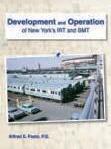
Urban Transit: Operations, Planning, & Economics • by Vukan R. Vuchic • BKUTOPE • $155.00*
Shipping Rates:
Add the following shipping and handling if your merchandise subtotal is:


up (Appropriate charges applied)

visit www.transalert.com
To order, call 1-800-228-9670 or
The Railway Educational Bureau 1809 Capitol Ave., Omaha NE, 68102 (800) 228-9670 I (402) 346-4300 www.RailwayEducationalBureau.com UP TO $10.00 $6.10 $11.00 10.01 - 25.00 10.50 18.25 25.01 - 50.00 14.30 23.85 50.01 - 75.00 16.05 29.75 75.01 -100.00 19.10 38.85 100.01 - 150.00 21.75 50.50 150.01 - 200.00 25.45 67.45 200.01 - 300.00 30.90 83.65 300.01 - 400.00 36.30 100.60 400.01 - 500.00 41.85 117.15 500.01 - 600.00 47.75 133.40 600.01 - 700.00 53.60 153.35 700.01 &
U.S.A. CAN U.S.A. CAN
Industry Indicators
‘U.S. RAIL TRAFFIC STARTED 2023 WITH BOTH DISCOURAGING AND ENCOURAGING ASPECTS’
“On the encouraging side, total U.S. carloads rose 2.2% in January 2023,” the Association of American Railroads commented last month. “January 2022 was the worst January for total carloads in our records that begin in 1988. Still, growth is better than a decline. January 2023 was the best January on record for crushed stone and sand, in part due to growth in frac sand. Automotive traffic, though not yet back to pre-pandemic levels, grew a solid 13.4% in January. Carloads of coal grew 4.6% thanks in part to restocking at power plants, while carloads of petroleum products were up 12.3% and were the highest in 20 months. Grain carloads were the second-highest for a January (behind 2021) since 2011. All told, 12 of the 20 carload categories we track saw gains in January.”
Railroad employment, Class I linehaul carriers, JANUARY 2023
(% change from JANUARY 2022) Transportation (train and engine) 50,313 (+9.93%)
Executives, Officials and Staff Assistants 7,998 (+6.75%) Professional and Administrative 10,081 (+2.22%)
Maintenance-of-Way and Structures 28,205 (+2.68%)
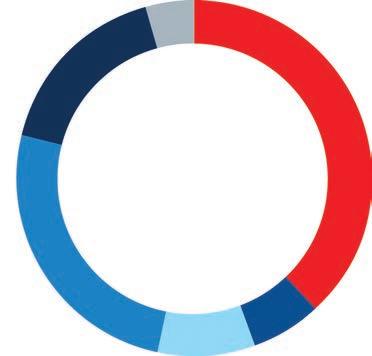
Maintenance of Equipment and Stores
17,794 (+4.98%)
Transportation (other than train & engine)
4,854 (+4.03%)
Source: Surface Transportation Board
TRAFFIC ORIGINATED CARLOADS
4 Railway Age // March
railwayage.com
2023
Intermodal MAJOR U.S. RAILROADS BY COMMODITY JAN. ’23JAN. ’22% CHANGE Trailers 55,11780,199-31.3% Containers 864,811 921,172 -6.1% TOTAL UNITS 919,9281,001,371 -8.1% CANADIAN RAILROADS Trailers 1 0 Containers 237,329247,983-4.3% TOTAL UNITS 237,330247,983-4.3% COMBINED U.S./CANADA RR Trailers 55,11880,199-31.3% Containers 1,102,140 1,169,155 -5.7% TOTAL COMBINED UNITS 1,157,258 1,249,354 -7.4% FOUR WEEKS ENDING JANUARY 28,
Source: Rail Time Indicators, Association of American Railroads
2023
TOTAL
EMPLOYEES: 119,245 % CHANGE FROM JANUARY 2022: +6.27%
MAJOR U.S. RAILROADS BY COMMODITY JAN. ’23JAN. ’22% CHANGE Grain 96,92394,5672.5% Farm Products excl. Grain 3,2682,88513.3% Grain Mill Products 37,60437,1571.2% Food Products 25,79024,4065.7% Chemicals 121,756137,397-11.4% Petroleum & Petroleum Products42,57037,90912.3% Coal 270,383258,4304.6% Primary Forest Products 4,3384,433-2.1% Lumber & Wood Products 11,463 13,402 -14.5% Pulp & Paper Products 20,54721,784-5.7% Metallic Ores 20,92119,4667.5% Coke 13,031 12,725 2.4% Primary Metal Products 33,72534,807 -3.1% Iron & Steel Scrap 16,36415,8513.2% Motor Vehicles & Parts 53,22246,92913.4% Crushed Stone, Sand & Gravel 79,66564,97122.6% Nonmetallic Minerals 11,98713,421 -10.7% Stone, Clay & Glass Products 26,15627,641-5.4% Waste & Nonferrous Scrap 14,25513,6874.1% All Other Carloads 19,72822,001-10.3% TOTAL U.S. CARLOADS 923,696 903,869 2.2% CANADIAN RAILROADS TOTAL CANADIAN CARLOADS 320,549 271,95817.9% COMBINED U.S./CANADA RR 1,244,245 1,175,827 5.8%
FOUR WEEKS ENDING JANUARY 28, 2023
TOTAL U.S./Canadian CARLOADS, JANUARY 2023 VS. JANUARY 2022

1,244,2451,175,827

Short Line And Regional Traffic Index
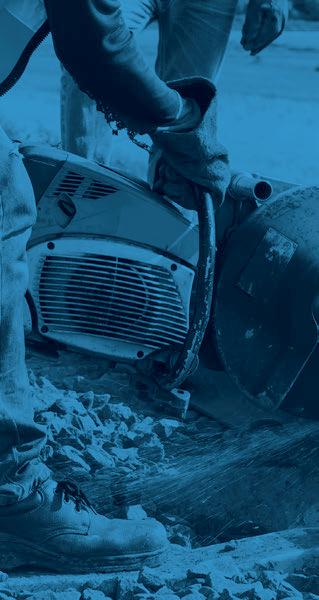
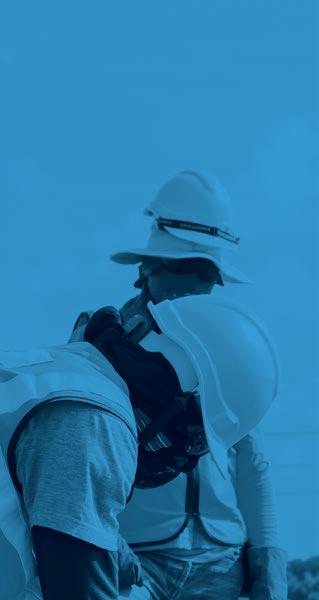
TOTAL U.S. Carloads and intermodal units, 2014-2023 (in millions, year-to-date through JANUARY 2023, SIX-WEEK MOVING AVERAGE)
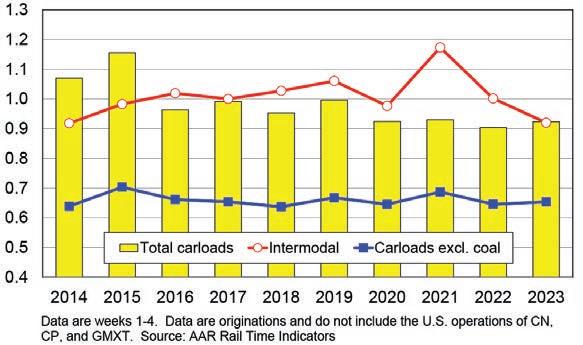
March 2023 // Railway Age 5 railwayage.com
JANUARY 2023 JANUARY 2022 Copyright © 2023 All rights reserved.
CARLOADS BY COMMODITY ORIGINATED JAN. ’23 ORIGINATED JAN. ’22 % CHANGE Chemicals 58,621 49,61718.1% Coal 21,744 14,76147.3% Crushed Stone, Sand & Gravel 23,932 17,90833.6% Food & Kindred Products 12,660 10,84416.7% Grain 31,417 30,822 1.9% Grain Mill Products 9,050 7,95513.8% Lumber & Wood Products 9,195 8,450 8.8% Metallic Ores 2,815 2,919 -3.6% Metals & Products 20,622 16,11228.0% Motor Vehicles & Equipment 9,832 8,14020.8% Nonmetallic Minerals 2,953 2,24031.8% Petroleum Products 2,428 1,92626.1% Pulp, Paper & Allied Products 18,929 18,481 2.4% Stone, Clay & Glass Products 13,703 10,99924.6% Trailers / Containers 38,089 41,358-7.9% Waste & Scrap Materials 12,490 10,43219.7% All Other Carloads 71,221 62,646 13.7% AILWAY GE Visit http: //bi t.ly/rai l jobs To place a job posting, contact: Jerome Marullo 732-887-5562 jmarullo@sbpub.com ARE YOU A RAILROAD OR SUPPLIER SEARCHING FOR JOB CANDIDATES? RA_JobBoard_1/3Vertical.indd 1 7/27/21 3:02 PM
Fritz Stepping Down as UP Chief Executive

JUST WHEN YOU THOUGHT THINGS WERE GETTING REALLY INTERESTING IN THE RAILROAD INDUSTRY, along comes another hedge fund trying to grab hold of a Class I, turn it upside down and shake it violently, hoping current leadership falls out.
This latest Wall Street-induced drama has strong shades of hedge fund TCI’s cancelled bid to take over CN in 2021 and replace thenCEO JJ Ruest with former CN and Union Pacific COO Jim Vena, 63, during the Canadian Pacific vs. CN battle to acquire Kansas City Southern (which CN lost). This time it’s Soroban Capital Partners, which in a 43-page presentation to UP’s Board of Directors, said Vena should replace Chairman, President and CEO Lance Fritz immediately. UP countered by revealing an “active leadership succession planning process” that has been under way since March 2022.
This battle, however, is a bit different than the CN saga. Soroban said, at least for now, it’s not looking for a proxy fight. It merely wants to replace Fritz with Vena.
“Following discussions between the Board and Mr. Fritz regarding the path for identifying Union Pacific’s next CEO, in March 2022 the Board engaged a leading outside consultant and subsequently formed a task force of directors composed of each of the Board committee chairs in November 2022,” UP said in a Feb. 26 announcement. “The Board is seeking a CEO with a strong track record of success and expertise across safety,
operational excellence, enhancing and driving customer service, innovation, employee culture, and sustainability. The Board is focusing the process on highly qualified candidates both within the industry and adjacent industries to identify a CEO capable of leading the company for a long-term tenure. The Board expects to name a successor who will assume the position in 2023.”
UP added it “has considered shareholder input and will continue to do so. The Board has been actively engaging with Soroban Capital Partners since 2017. In recent conversations, Soroban indicated it intended to move discussions to a public level. The Board decided it is in the best interests of all shareholders to provide a public update on its ongoing succession process and expected timing.”
In “moving discussions to a public level,” Soroban, which holds an approximate $1.6 billion stake in UP, pulled no punches excoriating Fritz and portraying Vena as a savior who will deliver “roughly $18 EPS and a $400 stock price by 2025” at UP. Under Fritz, a 22-year UP veteran who assumed the CEO post in 2015, “UP has repeatedly and significantly failed to reach its potential,” Soroban said.
Borrowing from TCI’s now-closed CN playbook, Soroban said UP “has the best rail franchise in North America. Despite this, under current leadership, UP has been the worst–performing Class I railroad, ranking the worst in every key railroad operating
metric: safety, volume growth, revenue growth, cost management, EBIT growth and total shareholder return. Key constituents have understandably lost confidence in Lance Fritz’s ability to lead the company. Shareholder returns have been the worst in the industry.”
There’s much more: “Employees are disgruntled: Among all S&P 500 companies, UP is rated by employees as the worst place to work and has the lowest employee CEO approval rating (ranked 500th out of 500 in both). The company is not delivering on its commitment to customers, and the Surface Transportation Board has singled out UP as providing the worst service among the Class I railroads. The U.S. economy needs an efficient rail network to flourish, as railroads are the lifeblood of the U.S. economy. UP, one of the largest and most interconnected transportation assets, has the most inefficient rail network, which has exacerbated the U.S. supply chain crisis. The environment is negatively impacted, as UP is not fulfilling its potential as a decarbonization enabler. Lance Fritz has continually failed to meet the annual incentive compensation targets set by the Board. Simply put, UP is not reaching its potential as North America’s best Class I railroad. Management’s poor track record results in the company not reaching its full earnings power and trading at a meaningful discount to its Canadian railroad peers and other high-quality industrial companies, thus significantly impairing shareholder value creation.”
It appears that UP is trying to call Soroban’s bluff, just like CN did—successfully—with TCI, eventually installing Tracy Robinson as CEO. “The Board is grateful to Lance for his unwavering leadership, dedication and oversight in driving our company forward over the past eight years as CEO,” said Michael McCarthy, Lead Independent Director of the Board. “Lance created an environment that has allowed Union Pacific to make a measurable impact with our customers, communities and employees alike. He has capably led our company during a time of significant challenge and change, positioning Union Pacific to deliver long-term sustainable value for shareholders and customers. We are immensely grateful to have Lance’s continuing leadership and support and know he will ensure a smooth transition.”
6 Railway Age // March 2023 railwayage.com Industry Outlook
– William C. Vantuono Union Pacific
Lance Fritz, UP
SEPTA: New Alstom LRVs
Southeastern Pennsylvania Transportation Authority (SEPTA) last month awarded a contract to Alstom Transportation, Inc., for 130 new Citadis™ light rail vehicles, with an option for up to 30 more. The base order is valued at approximately $714 million. The move—part of SEPTA’s Trolley Modernization program—will replace the Authority’s existing fleet, which has served riders since the 1980s. The contract follows the Request for Proposals (RFP) release in May 2022. The new LRVs will be longer and have higher capacity to move more riders, according to SEPTA, which noted that they will feature low floors and ramps; wider pathways; audio and visual messaging systems; and designated open space for wheelchairs, walkers, strollers and bicycles. Deliveries are expected to begin in 2027 and wrap up by the end of 2030.
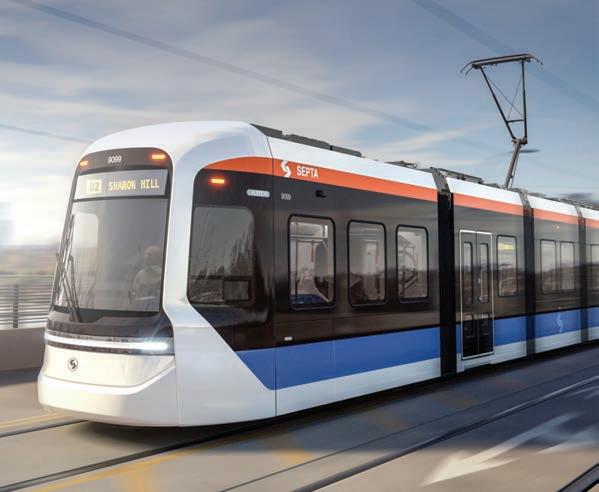
WORLDWIDE
Zurich, Switzerland-based ABB has reached an agreement to sell its Power Conversion division to ACBEL POLYTECH INC. , a designer and manufacturer of switching power supplies, for $505 million in cash. The transaction is subject to regulatory approvals and is expected to be completed in second-half 2023, the company said. ABB said it acquired the Power Conversion division, formerly LINEAGE POWER, as part of the GE INDUSTRIAL SOLUTIONS acquisition in 2018, and the division is not core to ABB. It generated revenues of roughly $440 million and income from operations of approximately $50 million in 2022, “with a clear focus on the North American market,” according to ABB. Upon closing the transaction with AcBel Polytech Inc., ABB said it expects to record “a small non-operational book gain in income from operations on the sale.”
NORTH AMERICA
Chattanooga, Tenn.-based BOHR ELECTRONICS is supplying CSX with fully furnished electrical cabinets—AC and HVC cabinet shells with new and remanufactured components—for its GP40-3 locomotive rebuild program. “We’re excited that we can again partner with CSX to support this overhaul,” said Bohr Electronics CEO Dan Marks, who last fall took over leadership of the ALDERMAN ENTERPRISES company, which manufactures and remanufactures electrical and electro-mechanical locomotive parts and components. “These Bohr-reengineered electrical cabinets will offer CSX reliable motive power for years to come.” In a related development, Bohr Electronics in April 2022 purchased K&L ELECTRONICS, a locomotive electrical component repairer and supplier based in Searcy, Ark.
The CANADIAN GOVERNMENT has issued an RFQ (Request for Qualifications) for the High Frequency Rail (HFR) project for the Québec City-Trois-Rivières-Montréal-Ottawa-Peterborough-Toronto corridor. “The purpose of the RFQ is to identify and qualify up to three top candidates who will be invited to participate in the Request
for Proposals (RFP) process, anticipated to begin in summer 2023,” Canada’s TRANSPORTATION SAFETY BOARD (TSB) said. “The procurement process will help select a private developer partner to work in collaboration with VIA HFR, the newly created subsidiary of VIA Rail, to design and develop the HFR project.” The RFQ, the next step following the Request for Expressions of Interest that opened in March 2022, launches the formal procurement process. It includes, according to TSB: “the context and features of the HFR project (e.g., current challenges in the corridor, purpose of the project, and objectives); the procurement process, including the evaluation criteria regarding how proposals will be evaluated, security requirements for candidates, funding support for proposal development during the RFP process, and key principles of the commercial agreement for the execution phase; the key players in the project (e.g., VIA HFR, private developer partner, VIA Rail, Government of Canada) and how they will work together; and project outcomes that the private developer partner will be expected to meet or exceed (e.g., shorter journey times, more frequent departures, more reliable service, etc.).”
March 2023 // Railway Age 7 railwayage.com MARKET Alstom
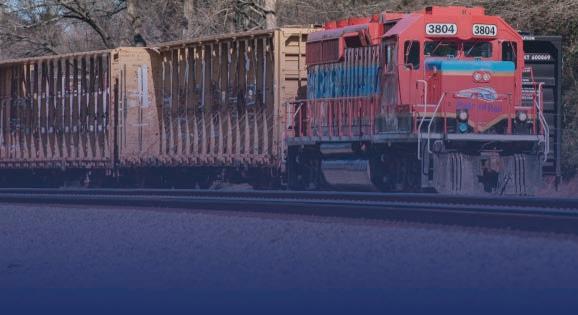

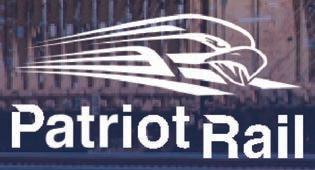



ContactPatriotRail | | MultipleinterchangeswithClassIrailroads Closeproximitytocustomers 24/7CustomerService 1.855.955.RAIL(7245) PATRIOTISABEST-IN-CLASS,premiershortlinerailoperatorpartneringwithcustomerstomeet theirtransportandbusinessneedsthroughflexible,customized,andsolution-drivenstrategies. Offeringreliablerail,storage,transloading,andotherancillaryserviceexpertisebuiltonthenonnegotiablecorevalueof safety,Patriotisaone-stoplogisticsstrategicadvisor,supporting customerswithcapitalandoperationalplanning,costreduction,anddedicatedserviceexcellence. Principalshippersanchoringeachline Locatednearmajorhighwaystoefficiently servetransloadingmarkets patriotrail.com MCVR GCW FSR RNA MSCI MSO NDW GS GET Patriot RailHQ YOURPREMIERRAILPARTNER RailLocations RailServices DSRR VRRC ISW EWR KTR KJRY DTR PRY WBRY |
NAPOLEON, DEFIANCE & WESTERN RAILROAD
Railway Age’s 2023 Short Line of the Year is the Napoleon, De ance & Western (NDW), a railroad that has gone from “worst to rst” with character and grit, nearly $13 million in recent public and private investment, and now with a bright business outlook.
“On behalf of the Patriot Rail team, we deeply appreciate this recognition across all short lines in the United States,” Patriot Rail President and CEO John E. Fenton said. “Not long ago, the NDW faced bleak abandonment, but with the strong support of so many stakeholders building on the nancial
commitment of the Ohio Rail Development Commission (ORDC) and the Federal Railroad Administration (FRA), we have revitalized this railroad. e new NDW and the bene ts it will deliver to customers and communities in Ohio exempli es what can be accomplished everywhere with dedicated partnership and public/private investment in short line railroads.”
NDW traces its roots back to the Wabash Railroad, established in 1855 to ful ll the vision of Indiana and Ohio business leaders to form an unbroken railway connecting Toledo, Ohio, with the Mississippi River. e Wabash served an important role during the
Civil War hauling troops, food and supplies, and subsequently survived the Great Depression and both World Wars. Known as the “Heart of America,” it served as a key economic driver for the Midwest.
Later in the 20th century, divestment, abandonments and deferred maintenance devastated the line, leading to the unfortunate distinction as the “Worst Railroad in America.”
“ e exceptionally degraded tie conditions and worn rail resulted in trains moving at a walking speed and o en derailing three times on a single run,” according to Patriot Rail Vice President Robert Turnauckas.

March 2023 // Railway Age 9 railwayage.com
Short Line of the Year
&
Napoleon, Defiance
Western
Short Line of the Year
Today, NDW’s 58.2 miles of right-ofway runs from Woodburn, Ind., to Liberty Center, Ohio, interchanging with Norfolk Southern at Woodburn and CSX at Deance, Ohio. It handles primarily aggregates, chemicals, food products, plastics, lumber, pulpwood and particleboard.
In September 2022, NDW became part of Jacksonville, Fla.-based Patriot Rail Company, a er Patriot acquired short line holding company Pioneer Lines.

NDW’s prior owners forged partnerships with multiple stakeholders and especially the ORDC, enabling multiple grants to put the short line on a path to restoration and further investment. More than $9.5 million in public and private grant investment— including a 2020 Consolidated Rail Infrastructure and Safety Improvements (CRISI) award of $4.1 million from the FRA— covered the replacement of 29,000 ties and 13 miles of rail on the 29-mile Woodburnto-De ance alignment.
“ is award from Railway Age underscores the power of partnerships,” ORDC Executive Director Matthew Dietrich said. “With NDW’s vision and willingness to commit the necessary resources to make critical infrastructure improvements, we established a win-win successful partnership for the bene t of the railroad, their customers and employees, our communities, and the state. is is a well-deserved honor, and we look forward to continuing the partnership into the future to rebuild the NDW’s entire line.”
e now-completed CRISI grant and other investment enabled upgrading NDW’s Woodburn-De ance segment from FRA excepted track to Class 1 safety status, allowing the railroad to operate longer trains at two-to-three times previous speeds to better serve customers. NDW, once a contender for the highest derailment rate of any rail line in the U.S., has achieved zero reportable derailments and zero reportable incidents on the rehabilitated alignment since the completion of the project in July 2022.
With an improved railroad, NDW revamped its marketing strategy to grow current customer carloads and attract new business. NDW forti ed strategic relationships with state and local economic development agencies and started new conversations with current customers to rebuild con dence in the line.
“ e NDW means a lot to Campbell’s Soup,” said Gavin Serrao, Regional Logistics Manager for Campbell’s Soup Napoleon. “ e CRISI project completed last year meant a lot to us in terms of having e cient and timely deliveries of our cars and it also opened up a lot more future opportunities for growth.”
An improved online presence and a media blitz at each milestone of the reconstruction helped to create excitement about the railroad, according to NDW. Strategic engagement plans began to draw new business to the line, while
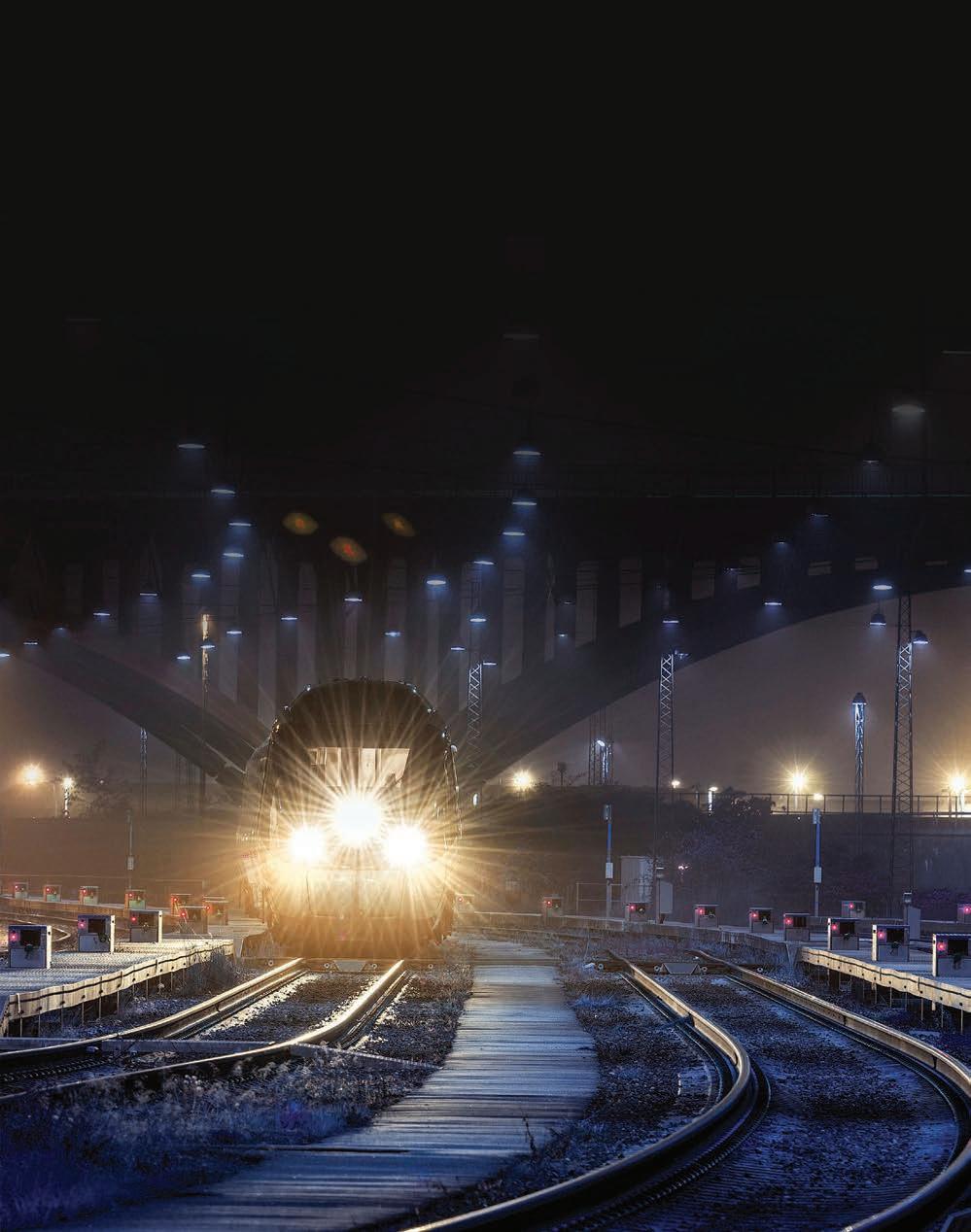
jobs in the community.”
“NDW’s commitment to helping customers meet their needs and investment in revitalizing the rail services illustrates their dedication to transforming the railroad industry,” TKI Executive Vice President Russell Sides said. “We are proud to partner with the NDW and Patriot Rail as we work together to safely and e ciently deliver essential nutrients to farmers, and we look forward to our continued partnership.”
TKI and APG investments, coupled with renewed line con dence, are expected to drive an 18% year-over-year increase in NDW carloads in 2023.
“ ere’s still work to be done,” Fenton said. “ e rst CRISI award was a great outcome, and we found an amazing partner with the ORDC. Together, we look to nish the job and improve the remainder of the line.”
ORDC’s current pending CRISI request with NDW would bring the De ance-toNapoleon segment up to FRA Class 1 track status, elevating safety, e ciency and capacity.
town halls ampli ed NDW’s commitment to the community and highlighted services the railroad could o er to local businesses. “All of these e orts showed immediate results,” Turnauckas noted. “Last year, Tessenderlo Kerley, Inc. (TKI) broke ground on a new multimillion-dollar fertilizer plant, and APackaging Group (APG) announced plans to construct a $49 million, 800,000 square-foot facility along NDW; both are slated to create more than 150
“Short line railroads such as the NDW help drive the economy in every part of America, creating jobs, protecting the environment, improving safety, and reducing the burden of heavy freight on highways,” Fenton added. “At Patriot Rail, we will continue to leverage the deep rail expertise of our team to provide outstanding service to our customers. e entire short line rail sector looks forward to the opportunity to build more choice, resiliency, and sustainability for rail shippers in states across the nation through the same kind of dedicated public-private investment partnership that made the NDW Woodburn-to-De ance transformation such a success.”
10 Railway Age // March 2023 railwayage.com
NDW achieved zero FRA-reportable derailments and incidents on its rehabilitated right-of-way.
LET RAILHEAD DATA GUIDE YOUR WAY





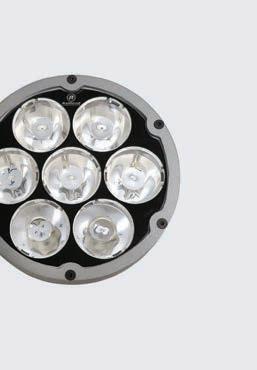





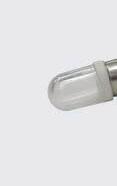






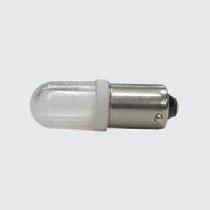


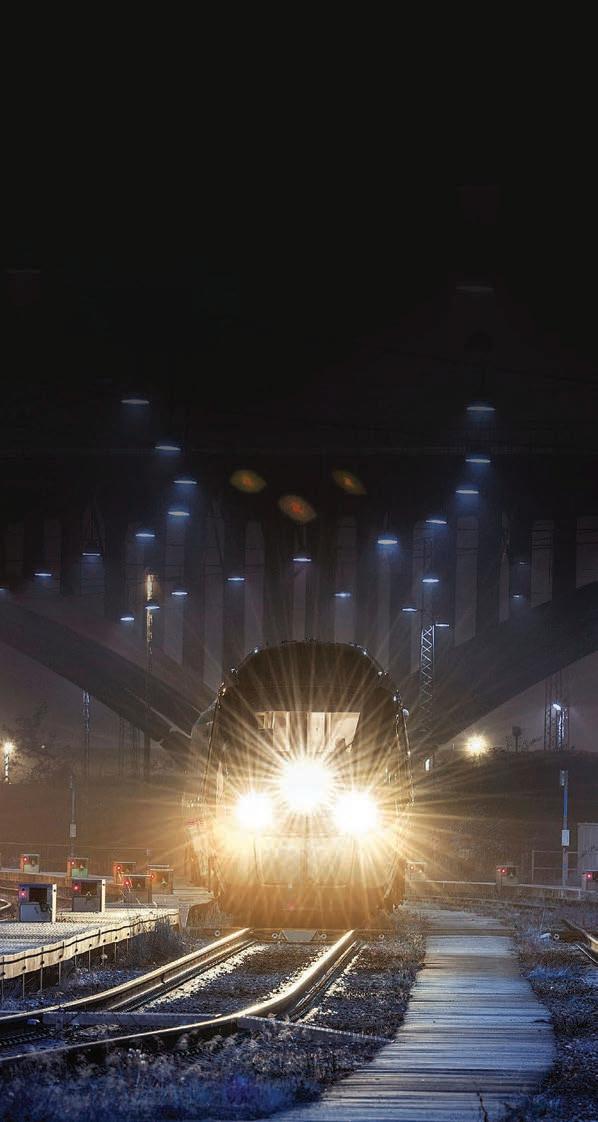
Railhead’s Fleet Wide Tracking software and video solution easily integrates and synchronizes with other on-board systems to aggregate data in an easy-to-use back office. Whether the goal is to capture fuel usage, gather event recorder data or capture video, Railhead can help your railroad improve safety and save money with our scalable and modular approach.
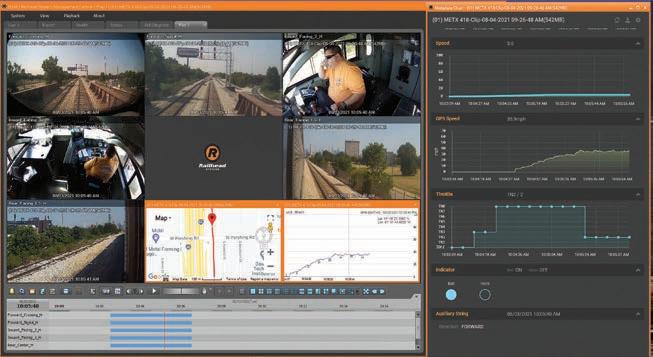
DRIVE EFFICIENCY
TECHNOLOGY RH-UG6W-75DC KE-6VGLED Locomotive Control Stand Light LED Headlight & Ditch Light LET RAILHEAD LIGHT YOUR WAY LOCOMOTIVE LED LIGHTS KE-NBLL Locomotive Number Board LED Locomotive LED KE-MCC 30 Watt Bayonet LED Replacement for Cab Light 800.235.1782 www.railheadcorp.com sales @railheadcorp.com TO LEARN MORE
WITH
Sustainable solutions to power your railway




EMD® Joule GT38H Hybrid
EMD Joule SD40JR Battery Electric
Progress Rail provides industry-leading exibility for use of bio and renewable diesel. The family of EMD® Joule Battery-Electric locomotives is the broadest available and comes as newly constructed locomotives or as modernizations for your existing eet. We offer battery capacities from 2.4 up to 14.5 MWh (the most available in the industry) all tailored to meet your railway’s operation. And hybrid battery-electric / diesel con gurations equipped with EMD or Cat® engines are just around the corner.

When it comes to sustainable solutions, we’ve got you covered

230008
We keep you rolling.



EMD Joule GT38JC Battery Electric
ARCELORMITTAL INFRASTRUCTURE CANADA RAILWAY
The ArcelorMittal Infrastructure Canada (ArcelorMittal) Railway in northern Quebec has earned Railway Age’s 2023 Regional Railroad of the Year award. Launched in 1960 and owned by global steelmaker ArcelorMittal, it is an independent system that operates 260 miles of single track. The railroad links the Mont Wright iron ore mine to PortCartier with a branch to the Fire Lake iron ore mine, and includes 20 bridges and five tunnels following rock slopes
and rivers. Some 50% of the main line is curved, with a maximum curvature of seven degrees. The maximum loaded grade is 0.40% while the maximum empty grade is 1.34%. Its busiest section tops 85 million gross tons.
Each year, ArcelorMittal Railway hauls approximately 26 million tons of iron ore concentrate and 15 million tons of raw ore as well as supplies for the mine and timber for a third-party sawmill. For several years, a combination of long (210-car) and short (160-car) trains were used, but since 2022, only long trains are


used. Consequently, six 210-car trains now leave every 1-1⁄2 days for the northern mining complex to haul back iron ore concentrate. Each carries 27,000 tons, for an average ratio of 9,000 tons per locomotive (two at the head end and one at the rear).

ArcelorMittal Railway runs 1,260 railcars out of a fleet of 1,323—whose average age is more than 40 years—with an availability of 95% and utilization of 94%. ECP braking is used on its railcars and distributed power on consists.
The availability of its fleet of 37

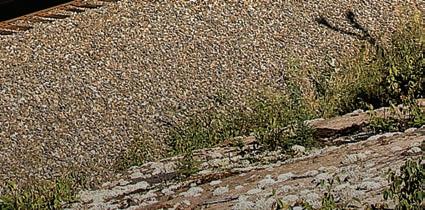
14 Railway Age // March 2023 railwayage.com
©ArcelorMittal Infrastructure Canada
locomotives has also increased by 10% in the last year, thanks to a focus on reliability and a robust maintenance program, ArcelorMittal says.
The railroad’s rolling stock shops perform all services, including wheel reprofiling. Average wheelset life is 750,000 miles, it reports, with some reaching more than 1 million miles.
Despite a challenging environment, the railroad’s overall track condition “is considered excellent by various internal and external audits,” according to ArcelorMittal. “A very limited number of slow

orders enables a constant and optimized cycle time.”
The railroad’s maintenance-of-way program includes what it describes as “intensive” rail grinding and lubrication as well as annual replacement of more than 2,400 tons of rail and 25,000 ties in a tight window—mostly during the summer before the freezing season.
ArcelorMittal says it promotes “a culture based on empowerment and increased risk assessment from frontline workers, who use various prevention tools to reduce exposure to risk, such as pre-work analysis, equipment inspection forms, clear operational procedures, and post-trauma matrixes.”
“We are deeply honored to receive this award, which highlights the outstanding work of our teams to operate a worldclass railway,” says Michael LaBrie, General Manager of ArcelorMittal Infrastructure Canada. “Above all, we must emphasize a remarkable performance in health and safety to protect our workers, which has translated into zero lost-time injury since January 2021. We are all very proud to see our efforts recognized by the major players in the North American rail industry.”
Increased technology integration for its railroad is at the heart of ArcelorMittal’s vision for the future, the company
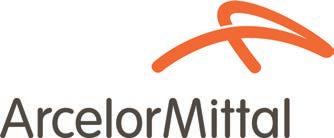
says. The railroad is currently collaborating with the RAIL Center of Excellence at Cégep de Sept-Îles, a technical college in Quebec, to develop a predictive-maintenance database for its rail infrastructure. ArcelorMittal uses a hi-rail vehicle to inspect track twice weekly. Outfitted with Pavemetrics’ automated technology, millions of high-resolution, threedimensional images of the rail and its components are sent to the database. The college analyzes the data and produces a report that railroad employees can view on a dashboard. GPS positioning shows where defects are located, allowing employees to predict component lifespan and to intervene in a targeted manner, boosting safety and reliability.
Additionally, ArcelorMittal recently bought from Railhead Corp. a new remote monitoring and 4K video recording system for its railroad, providing real-time monitoring and access to locomotive data.

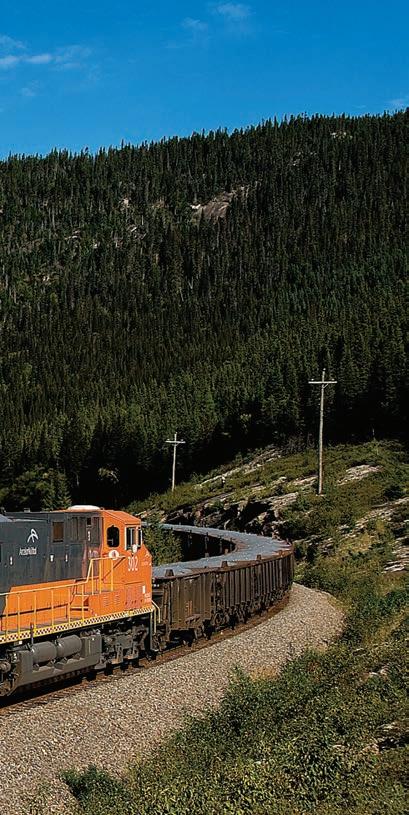
March 2023 // Railway Age 15 railwayage.com Regional of the Year
ABERDEEN CAROLINA & WESTERN RAILWAY

Railway Age in 2023 recognizes Aberdeen Carolina & Western Railway (ACWR) with a Short Line Honorable Mention. Since its purchase by Robert Menzies in 1987, ACWR has grown from 34 miles of track, with one locomotive and two customers, to 150 miles of track today, with 36 locomotives and more than 20 customers that manufacture or distribute such commodities as plastics, poultry, dimensional lumber, wood chips, aggregate, brick, butane, ethanol and propane. 2022 served as a springboard to further growth for the central North Carolina short line.
ACWR completed the acquisition of Norfolk Southern’s Piedmont Division, which had been under a lease-purchase option by the short line since 1989. e 104-mile line between Gulf and Charlotte, N.C. consolidated ACWR’s holdings along with its Sandhills line, which connects in Star, N.C., and runs through Pinehurst to Aberdeen, where ACWR interchanges with CSX.

Also in 2022, the short line invested $10 million on multiple track expansion and improvement projects and saw rail tra c increase 7% (approximately 500 carloads) from 2021. It attributed the success to:
• Tripling the size of its Midland, N.C. Downtown transload site. Heni Transportation operates it, transloading chemicals.
• Construction and August launch of the Midland Logistics Park. is 70-acre development includes three additional properties for rail customers, ranging from four to 15 acres, and is anchored by ACWR’s Midland Transload Yard, which can accommodate 200 railcars for transload, storage, distribution of raw materials, and nished goods, with space and equipment to handle many bulk transload commodities as well as truck self-transload operations. It is equipped with a central scale house for tenant use. Several major plastic distributors have begun operations, consolidating their Charlotte operations in Midland.
e project was a collaborative e ort of ACWR, its customers, and the North Carolina Department of Transportation (NCDOT) Rail Division, which provided several grants.
• Strong shipments from existing customers and addition of multiple new ones. Among the new: Charlotte Pipe and Foundry, which announced in 2020 a move from downtown Charlotte to a new $325 million plant on 428 acres in Oakboro, N.C. ACWR’s maintenanceof-way and construction crews supported building the plant’s rail infrastructure. Once operations begin this year, it is projected to add 3,000 new carloads, both inbound and outbound rail tra c, per year to ACWR tra c.
ACWR is now at work on six additional projects: two are passing sidings to


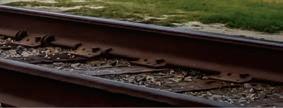

accommodate unit train tra c to improve the overall uidity of the line, and four involve ACWR-owned properties, totaling 350 acres.
e short line is preparing four properties for rail-served development through partnerships with six county economic development directors and the North Carolina Railroad, which is providing “site readiness” grants. Additionally, using a $27 million CRISI grant awarded by FRA in 2020, ACWR will begin work this year on track upgrades and infrastructure improvements, allowing for increased speed, capacity and safety.
Rounding out 2022, ACWR unveiled corporate train F-unit locomotives purchased from NS (pictured above), which feature a dynamic new paint scheme. Lionel has replicated these locomotives and several ACWR corporate railcars for model train enthusiasts and the public.
“Years from now, we will look back on 2022 and remember this as the year we built the foundation for our next generation of growth,” ACWR Director of Business Development Paul Hoben said.
16 Railway Age // March 2023 railwayage.com
Chris Aumen
NEXT-GEN MOTIVE POWER


Transitioning from steam to diesel took more than 20 years. Moving to zero emissions will probably take much longer.
BY WILLIAM C. VANTUONO, EDITOR-IN-CHIEF

Be it battery-electric, hybrid, biofuel, hydrogen fuel cells, or improvements to the tried-andtrue diesel-electric, the motive power market is glowing with clean, green technologies. e most widely used terms are “decarbonization” and “zero emissions.”
“Railroads are working diligently to develop lower and ultimately zero-emission technologies that deliver an even more sustainable future,” the Association of American Railroads notes. “Railroads are taking active steps to further reduce emissions associated with current locomotive technology and move toward lower and zero-emission technologies that are still in research, development and demonstration phases. Numerous railroads have active demonstration programs for alternative fuel locomotives that hold great promise as tomorrow’s lower or even zero-emission solutions.”
All of this will take time—lots of it. e railroad industry has been around for nearly 200 years (167 of them documented in the pages, print or electronic, of Railway Age).
e diesel-electric locomotive, which will remain the industry’s primary source of motive power for many years to come, rst
appeared in 1920. Will railroad historians in the 22nd century consider 2023 (or thereabouts) a milestone year, the beginning of a major move away from the diesel-electric? Or will another 10 to 20 years of development and testing, followed by 10 to 20 transitional years, push back that date in history?
In this article, three professional engineers from HDR o er their perspective (p. 19). Elsewhere in this issue (p. 41), veteran railroad locomotive specialist and Railway Age Contributing Editor Mike Iden o ers his views (including the bene ts of electrication), based on decades of experience.
We’ve also talked with Progress Rail, Wabtec and Cummins about the evolving market for alternative propulsion.
PROGRESS RAIL



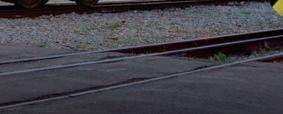
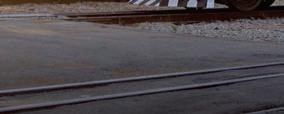

Progress Rail, a Caterpillar company, is embracing all forms of alternative propulsion technologies. e brand that got its start as Electro-Motive Corporation in 1922 and as EMD (Electro-Motive Division of General Motors), jump-started dieselization in 1941 with the FT. Today, Progress Rail sees an evolving market for its EMD® product line, including battery-electric, hybrid and HFC (hydrogen fuel cell) propulsion, as well as
diesel-electric locomotives fueled with biodiesel blends, renewable diesel, a hydrogen/ diesel blend, or even straight hydrogen. e possibilities are vast, and there is no “one size ts all” solution.
“We are proactively developing cutting edge solutions—focusing on our customers’ interests and their ability to obtain funding for additional investments,” says Senior Vice President of International Sales, Technology & Marketing Paul Denton. “ ere are several options along the path of emissions reduction that are emissions-friendly and do not require railroads to replace their investment in diesel engines.”
e crown jewel of Progress Rail’s alternative propulsion initiatives is aptly named the EMD® Joule. Available in ve con gurations, new or repowered (“R” nomenclature)—SD70J (6 axles, 8.0 MWh maximum battery capacity); SD70J-BB (8 axles, 14.5 MWh); SD40JR (6 axles, 4.0 MWh); GT38JB (4 axles, 4.0 MWh); GT38JC (6 axles, 4.0 MWh)—these units all feature regenerative braking for battery recharging (see chart, p. 18, for additional technical speci cations). Customers can specify what they desire in MWh, up to the maximum rating. e modular EMD® Joule Charging Station
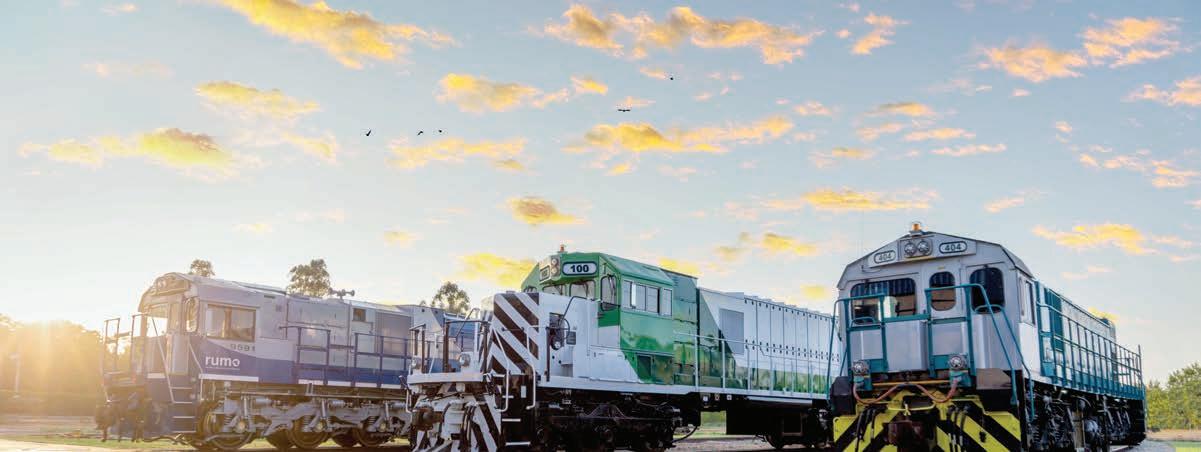
March 2023 // Railway Age 17 railwayage.com
Progress Rail
Left to right: Progress Rail EMD® GT38H hybrid, SD40JR Joule battery-electric, and GT38JC Joule.
provides stationary charging in 700- and 1,400-kW con gurations.
In Southern California, BNSF will be taking delivery next year of up to four SD70Js with charging stations for continuous operation. eir 8 MWh of storage capacity will make them “the most powerful battery-electric locomotives in North America.” BNSF’s acquisition is funded in part by CARB (California Air Resources Board) and EPA grant funding.

At 14.5 MWh, the SD70J-BB o ers the largest known battery capacity in the industry. BHP Western Australia Iron Ore will be testing two beginning early next year. e test will include regenerative braking (also called “energy capture”) charging using the rail network’s natural topography to reduce overall power demand. On the downhill run to BHP’s Port Hedland export facility from the mine in the Pilbara, the locomotives will capture energy from regenerative braking and use it to help power empty trains back to the mine. FMG/FFI (Fortescue Metals Group) will take delivery this year of two units for its Australian iron ore mining operations, which are currently under manufacture at the Progress Rail facility in Sete Lagoas, Brazil.
Brazil’s Vale S.A., a metallurgical and mining rm, was among Progress Rail’s initial partners for its rst battery-electric locomotive. “In conjunction with Caterpillar, our engineering teams designed a locomotive for that application,” says Senior Vice President of Engineering Mike Ramm.
“ at project, which resulted in the GT38J, a meter-gauge/low clearance version of the SD40JR, started our journey into batteryelectric,” he adds.
e newest iteration of the Joule line is a standard-gauge unit for Paci c Harbor Line, currently testing at MxV Rail in Pueblo, Colo. “Battery locomotives are ideal for certain railway applications,” notes Ramm. “Yard service is a perfect example, which is why PHL expressed interest to acquire the SD40JR for its operations.”
Progress Rail selected LiFePO4 (lithium iron phosphate) batteries. “When you look at battery locomotives in the industry, much of it comes down to battery chemistry and how it is being used,” says Ramm. “Do you want faster discharging/charging for highly cyclic applications, or something that is more stable? Batteries have a nite life, like in cell phones. When you repeatedly charge and discharge them, battery life goes down, which is also true for locomotives.”
Hybrid propulsion, which uses a combination of diesel engines and battery, is another solution from Progress Rail. Brazilian logistics/transportation rm Rumo Logística will take delivery early this year of two EMD® GT38H intermediate-power locomotives, the rst hybrid locomotives in revenue freight service. ese use modular architecture to accommodate various energy sources, retain the capability of their diesel counterparts, and are capable of both regenerative and external battery charging. “We see hybrid locomotives
as one of the bridge technologies to helping customers conserve fuel and reduce emissions,” says Ramm.
For longer-distance line-haul, high-power applications, HFC shows promise, provided its limitations can be managed. “A hydrogen fuel cell vehicle is, at its core, an electric vehicle with electric traction motors and a battery system,” explains Director of Advanced Energy Michael Cleveland. “ e battery system is recharged or supplemented by the fuel cell, which takes in hydrogen from onboard storage and extracts oxygen out of the air. It is analogous to a battery. One of the limitations of fuel cells is they do not perform well with load uctuations. A freight locomotive can go from Notch 8 to idle in a couple of minutes, for example. e way to mitigate that is to couple the fuel cell with a battery system that can manage load uctuations.”
“We are taking what we are learning with batteries and incorporating it with fuel cells. Hydrogen contains about 20% of the energy by volume of diesel fuel, so an external hydrogen tank, a tender, will be needed to support longhaul operations, which is essential to the Class I’s,” notes Cleveland. “Hydrogen has some challenges, but the fact that the only ‘exhaust’ is water makes it an attractive option.”
In December 2021, BNSF, Chevron U.S.A. Inc., and Progress Rail entered a memorandum of understanding (MOU) to demonstrate an HFC locomotive. e goal is “to con rm the feasibility and performance of hydrogen fuel for use as a viable alternative to traditional fuels for line-haul rail,” Progress Rail said. “Hydrogen has the potential to play a signi cant role as a lower-carbon alternative to diesel fuel for transportation, with hydrogen fuel cells becoming a means to reduce emissions.”
“As a division of Caterpillar, we are deeply involved in the energy transition across our entire business. Our investments in technology—from hydrogen, to battery, to electric, and even hybrid locomotives—are being jointly developed with our parent company,” comments Denton. “When we couple our powertrain innovations to our existing technology stack for fuel savings, such as Talos energy management and our Nitro Suite of yard and network optimization decision support tools, we contribute signi cantly to our customers’ ability to operate more eciently and safely, while helping them achieve their ESG goals.” (Continued on p. 21.)
18 Railway Age // March 2023 railwayage.com
FOCUS – MECHANICAL
TECH
RAIL FLEET DECARBONIZATION OPPORTUNITY: WHAT DOES IT MEAN FOR YOU?
BY MARCIN TARASZKIEWICZ,
It’s an exciting time for rail fleets and operations. Society’s decarbonization efforts around the globe have created impetus in the rail industry to further reduce its carbon footprint. Technology is improving to make zero emissions a realistic goal. Yet, there is no one-size-fits-all answer to transitioning rail operations to achieve net zero emissions.
Passenger and freight railroads have different mixes of diesel vs. electric locomotives and infrastructure. Different parts of the country have various enabling electric power infrastructure and each rail organization has a unique state of readiness for change. Despite the challenges, now is the time to start planning for the future of rail decarbonization in your fleets.
WHY ZERO EMISSIONS?
The awareness of human impact on the earth’s environment is at an all-time high. There is considerable pressure in all sectors to minimize or fully eliminate greenhouse gas emissions. Though rail is a cleaner mode of transportation than traditional trucking, freight and passenger railroads are not immune from scrutiny of their efforts to reduce or eliminate greenhouse gas emissions.
There are four main reasons why railroads should seriously consider converting their rail fleets to zero-emissions equipment:
•Societal Shift: There has been a push for zero-emissions across transportation and other industries, including rail. Investors, clients and the general public are pushing to accelerate the pace of this change.
•Perception: Although rail produces only 2% of U.S. greenhouse gas emissions, all transportation modes risk being perceived as a “dirty” option so long as carbon-based fuels are widely used.
• Mandates: Several U.S. states have already implemented or are considering zero-emissions mandates or targets for all land transportation, including railroads. This will force rail operators to plan for decarbonization of their equipment fleets.
• Equity: Communities near maintenance facilities, rail yards and the rightof-way are disproportionally affected by emissions from locomotives. Reducing and eliminating emissions will not only aid in reducing greenhouse gases but also will improve local air quality and health in these communities.
RAIL DECARBONIZATION TECHNOLOGIES
There are several approaches to decarbonizing rail fleet operations. One of the oldest means of powering rail vehicles without tailpipe emissions is external power via overhead catenary. This form of power delivery is mature and well understood, but it carries several significant disadvantages that make this a less desirable choice for many rail operations.
Newer technologies, such as batteries and hydrogen fuel cells, offer the promise of emissions-free on-board power with no additional infrastructure requirement along the right-of-way. However, neither of these technologies is yet fully mature, and both currently have limitations that would preclude their use in some applications.
Many long haul or freight operators are looking to interim technologies, such as hybridization, alternative fuels or a combination to reduce emissions until zeroemissions technologies can fully replace current combustion power plants.
Using battery-electric locomotives in freight rail yards and ports is a good example of an interim technology. While battery-electric locomotives fall short on range for heavy long-haul freight, they can reduce emissions in urban areas where many such rail yards exist.
There are many factors that affect the feasibility of each technology—from operating requirements such as speed and payload capacity to environmental conditions including temperature and topography. The local availability of energy sources, either electrical power or hydrogen, can also be a deciding factor in the selection of an appropriate source of power.
When considering the benefits and drawbacks, sometimes the best solution is a combination of two or more technolo-
gies, depending on the existing conditions, terrain and other factors.
An example of a successful selection of zero-emissions technology is San Bernardino County Transportation Authority’s Zero Emissions Multiple Unit train, or ZEMU for short. This is a trainset design for commuter train service in the Los Angeles area, the first of its kind in North America to be a hydrogen-battery hybrid vehicle and zero emissions.

While battery power was initially considered the preferred technology for this train, operation simulations showed that this was not an ideal choice for this train primarily due to service range requirements for this vehicle. After an analysis of the service requirements against the capabilities of existing zero-emissions technologies, it was decided that a hybrid system consisting of both batteries and hydrogen fuel cells was the optimal approach to meeting service requirements.
Key Considerations: Supporting Infrastructure and Utilities: Of course, moving from diesel to any other fuel source has ramifications beyond simply purchasing a different locomotive. Planning must consider the supporting infrastructure, facilities and maintenance practices, as well as recharging or refueling strategies and cost modeling for electricity rates.
Infrastructure Considerations: Integrating new technologies into a fleet will likely require existing facilities to be modified— or new facilities built—to support the new fueling or charging requirements. Charge or fueling times (or down time), routes, charging and fueling infrastructure and
TECH FOCUS – MECHANICAL March 2023 // Railway Age 19 railwayage.com
P.E., WILL KIRBY, P.E., AND CHRIS RAND, P.E., HDR
operations should be modeled and understood with new technologies. For battery-powered trains, it’s not a 1:1 conversion. Charging takes more time than refueling, so organizations often need to purchase more electric vehicles than their combustion fuel counterparts. With hydrogen-powered trains, safety considerations for fueling infrastructure will dictate allocation of space adjacent to the right-of-way that ensures safety while meeting fueling requirements.
Staff Considerations: It’s best to involve staff early in the process so they understand the technology and provide feedback about how changes can be supported in maintenance and operations. Staff can help evaluate how new tasks can be made easier, more productive and safer for the organization, assess configuration of equipment, and facilitate the transition to new operations.
Energy Sourcing Considerations: Operating electric locomotives requires significantly more electricity than a diesel fleet. This means that planners should coordinate very early with the local utility, and possibly the applicable regional transmission organization (or similar), to ensure that the facility can access the required amount of power without disrupting the regional grid.
A thorough study and modeling process of a charging strategy should be conducted to determine the load that will be required from the grid. It should also consider the use of off-peak charging and facility
optimization when possible. If the utility is not able to provide the necessary quantity of power without significant infrastructure upgrades, the rail organization can explore installing its own energy generation. Recent legislation has extended tax credits for renewable generation, making this an attractive option for many.
For hydrogen-powered vehicles, the availability of nearby hydrogen production sources is vital. In some areas, hydrogen is already or will soon be produced on a scale that will ensure an abundant and easily obtainable supply. However, many areas still do not have local hydrogen production facilities. Since land transport is currently the main means for transporting hydrogen from its production source to the end user, this might not be a practical, reliable or cost-effective option for many rail operations at this point. Trucking emissions could also offset the benefits of eliminating emissions from the rail equipment.
TIPS FOR PLANNING SUCCESS

Rail organizations envisioning a decarbonized future can set themselves up for success with a robust planning process. Best practices include:
Perform service simulations to confirm viability: Implementing new technologies always comes with some risk. It’s important to select the right technology to meet operating service goals. There are a lot of factors that influence the energy requirements, and the best way to determine those requirements is to perform simulations via modeling. The results will help you
select the right propulsion technology for your operation.
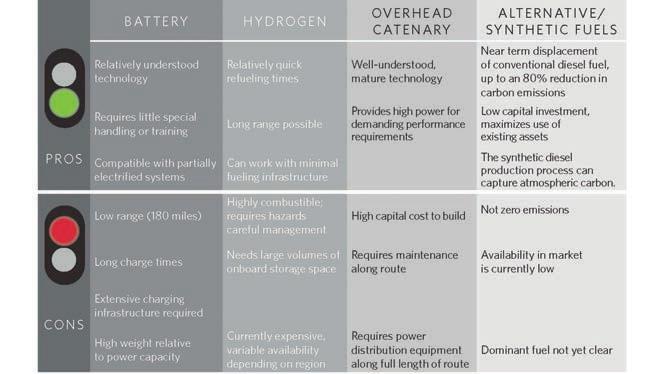
Engage stakeholders to identify issues: Main stakeholders include regulators, utilities, first responders and the public along the right-of-way. A constant dialog with regulators is critical to communicate expectations and requirements, particularly for safety, to avoid surprises and ensure a timely deployment of new technology trains into revenue service. First responders need to understand the key features of the technology that impact how they handle the equipment in an emergency. The general public should understand that the technology is safe for people living along the right-of-way and appreciate the community benefits of decarbonization.
Involve staff: Staff will need new procedures to support different technologies as well as training for operations and maintenance. New technology equipment requires new processes and new skills. Early engagement and sufficient training time is key for true buy-in and workforce success.
MOVING INTO THE FUTURE
The rail industry has an opportunity to accelerate its decarbonization efforts. The key to capitalizing on this opportunity is effective planning and preparation so that the right technology is selected for the job. In the U.S., there is now funding available to help rail organizations transition to zero-emissions technology.
Plans built by looking at current zeroand low-emission technology opportunities, forecasting what the future will look like, understanding gaps, and then creating a customized strategy will set up railroads to implement a successful fleet decarbonization shift.
Marcin Taraszkiewicz, P.E., is HDR’s rail and transit vehicle technology lead. Will Kirby, P.E., is a transportation sustainability leader at HDR. Chris Rand, P.E., is a railroad facilities program manager at HDR.


20 Railway Age // March 2023 railwayage.com
TECH FOCUS – MECHANICAL
WABTEC


“We’re trying to create options for our customers,” says Wabtec Executive Vice President and Chief Technology O cer Eric Gebhardt. “We’re looking at biofuels and renewable fuels. We have our FLXdrive battery locomotive, and also hydrogen. On top of that, we’re driving more e ciency through diesel engine modi cations—5% lower fuel consumption, 5% less carbon, etc.”
Wabtec currently has more than 40 locomotives operating with various blends of fuels, for example, 20% biodiesel and 80% renewable diesel. What’s the di erence between biodiesel and renewable diesel? “Biodiesel is close to diesel, but with more waxes and para ns and other elements,” Gebhardt explains. “It’s chemically di erent. Renewable diesel is hydrogenated, so it’s a pure form of the diesel molecule. In fact, it’s actually a little too pure, so it requires additives to improve viscosity. We’ve approved up to 5% biodiesel and up to 30% renewable diesel for our locomotives, and we’re trying to get to 20% biodiesel and up to 100%
renewable diesel. Both types come from the same feedstocks.”
FAME (Fatty Acid Methyl Ester) is the generic chemical term for biodiesel derived from renewable sources. It is used to extend or replace mineral diesel and gas oil used to fuel on- and o -road vehicles and static engines. FAME consists of acids created during the transesteri cation of vegetable oils and animal fats to create biodiesel. ese high molecular weight oils and fats react with short chain alcohol in the presence of a catalyst, usually potassium hydroxide, to produce lower molecular weight esters.
“We need to understand what engine parts would have to be changed out burning these di erent types of fuels—things like hoses and seals,” explains Gebhardt. “We want to understand the deterioration factors, the impact on fuel injection systems, for example, to stay within current emissions compliance standards. Fuel injectors have very precise passages. We need to make sure we can reach the NOx and particulate matter requirements. We’re working with our customers through
eld tests, inspecting these units to make sure we know what the maintenance intervals need to be. We’re less concerned about the metals (internals). We don’t think any of those would be a large concern, with the right lubricity (the measure of friction reduction) and viscosity (the measure of a uid’s resistance to ow) additives. We’re paying close attention to how elastomers and hoses, the rubber components, will interact. We have a program with the Class I’s, and we don’t see any reasons why we won’t be successful with this. Longer term, it’s going to be important for our customers to understand the availability and cost of these fuels. Some parts of the U.S. have signi cant subsidies—California, for example. e price points might vary in di erent parts of the U.S.”
e FLXdrive program is progressing to the next level. e 2.4 MWH “version 1.0” successfully tested with BNSF between Barstow to Stockton, Calif., registering an 11% fuel savings operating in a consist with two dieselelectrics, vs. a three-unit diesel-electric. “We now have two new iterations,” says Gebhardt.
TECH FOCUS – MECHANICAL March 2023 // Railway Age 21 railwayage.com
(Continued from p. 18.)
TECH FOCUS – MECHANICAL
“ e rst is what we call the FLXdrive 2.0, with 7 MWh, the rst two of which are shipping at the end of this year to Australia for a trial with BHP Western Australia Iron Ore (in the same trial as Progress Rail’s SD70J-BB).” is will be followed by the FLXdrive 2.5,
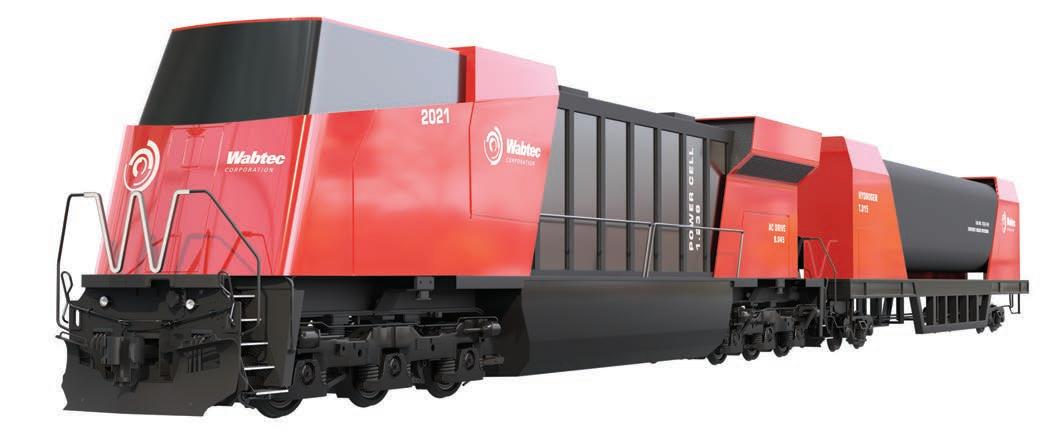
which replaces the NMC (nickel-manganesecobalt) batteries with GM’s Ultium NCMA (nickel-cobalt-manganese-aluminum) technology manufactured by Ultium Cells LLC, a joint venture of GM and LG Energy Solution. “We’re utilizing the Ultium designed for
the Hummer truck,” says Gebhardt. “We’ll ruggedize it. e batteries have individual cells; a module consists of a stack of cells. Several modules create a pack. One weighs more than a ton, but they have a lot of energy capacity. We’ll take the Hummer pack and
CLASSMASTER™
The Hump Yard ProcessControl System in 22 classification yards across the US and Canada featuring:

• AutomaticCalibration
• Graphic Playback
• Realtime Hump List Display
• Pinpuller Scoreboard Display
• Automatic Report Generation
• Loggers –Daily, Event and I/O
• Electronic Track Blocking
• AEI Integration and List Verification
• Remote Diagnostics
•
ROUTEMASTER™
The NX Control System in 12 locationsproviding Entrance–Exit andTrain Control Operation for Receiving,Pullback and Departure Yards featuring:
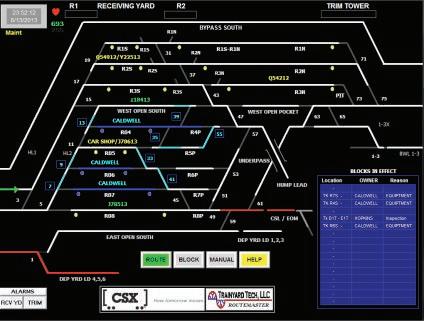
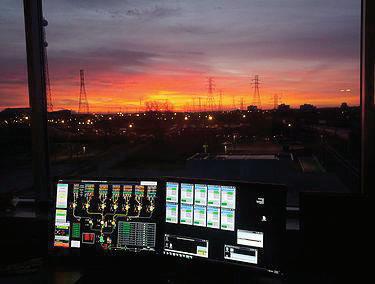
• NX Route Control – Receiving and Pullout Yards
• 4G Wireless Control
• Track Circuit-Less Shove Operation
• Realtime status of all yard devices
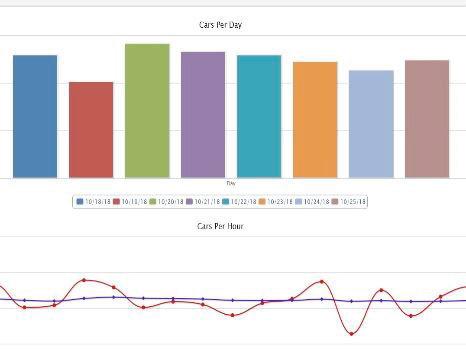
• Logger –Daily,Event and I/O
• Individual Switch Control
• State-of-the-art Lightning Protection
• Graphic Playback
INNOVATIONS
, switch and track occupancy detection using wheel detectors. Provides data essential for maintaining a High Performance yard. sophisticated reporting tool to simplify troubleshooting, analyze yard. Reviewing Up-to -the-minute historical performance.
22 Railway Age // March 2023 railwayage.com
Wabtec
Wabtec Hydro Locomotive concept with hydrogen fuel tender.
stack 42 inside the locomotive, and that gets us to 8-plus MWh.”

“It’s not how much power you have when you start or end the route,” says Gebhardt. “It’s the fact that you’re regenerating the electricity. ere are parts of the route that have high standard deviation, in terms of grade. You can generate a lot of energy with a train that might have 10,000, 20,000 or 30,000 trailing tons. If you think about the 2.4 MWh hour version that one saves about 11%, with an 8 MWh unit we could save 20% or 30% on fuel usage, depending on track standard deviation.”
Wabtec’s venture into hydrogen includes HFC as well as burning hydrogen inside an internal combustion engine. e company is working with GM to utilize its Hydrotec fuel cell technology in a hybrid unit, with batteries supplying traction power. e fuel cells would be trickle charging the batteries. “ e game-changing part of fuel cells is e ciency,” says Gebhardt. “We’ll be working toward 65% e ciency, compared to 40%-42% with an internal combustion engine. Fuel

cells have that signi cant advantage, which should be achievable over the next decade or so. We have to make sure that we understand how to provide enough fuel for those fuel cells. Right now, the energy density, volumetric energy, of hydrogen is low. If we’re going to o er a main line solution, it will have a tender car. Our locomotives carry about 5,000 gallons of diesel. One kilogram of hydrogen is equivalent to one gallon of diesel, roughly, in energy content (expressed as DGE, diesel gallon-equivalent). To get that same amount would require a tender car with about 7,000 kilograms of hydrogen. at amount provides more range than 5,000 gallons of diesel. Because of the volume, we’ll need a tender. But we are operating with LNG tenders in Florida and Mexico, so we understand how to work with them, and with liquid and gaseous fuels.”



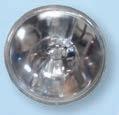




Burning hydrogen in an internal combustion engine will be similar to LNG. “We’re working with Argon and Oak Ridge National Labs on this as part of a Department of Energy grant,” explains Gebhardt. “We’re




































looking at di erent con gurations to see how much of a blend of hydrogen with diesel for energy content we can get to. Our goal is to get into the 90%-plus range, to stay with compression ignition, avoiding spark plugs. Part of that has to do with what our customers are looking for. Spark ignition has shorter maintenance intervals. Compression ignition is more robust, with longer maintenance intervals. Spark ignition with hydrogen or LNG is maybe an easier solution, but it does require more maintenance.”


CUMMINS




Among the world’s largest diesel engine manufacturers, Cummins has established a major presence in the North American diesel-electric locomotive market in partnership with Siemens, whose Charger series of passenger locomotives utilize the Cummins Tier 4 QSK95 high-speed engine. Smaller variants of the QSK series are used in DMUs and freight switcher locomotives. Longterm, the company’s o cial decarbonization strategy is called Destination Zero, “which

TECH FOCUS – MECHANICAL March 2023 // Railway Age 23 railwayage.com
www. PowerRail.com Phone: 570-883-7005 Email: Sales@ePowerRail.com Proudly Celebrating 20 Years of Keeping Locomotives Running! Come see us at the 2023 ASLRRA Conference & Expo! Booth 530
TECH FOCUS – MECHANICAL
is about achieving net-zero emissions by reducing greenhouse gas (GHG) emissions and supporting customer transitions to decarbonized power,” says Innovation Lead, Industrial Markets Brian Olson.
Cummins’ alternative fuel initiatives took ight a er it purchased, for $290 million, Canada-based Hydrogenics in 2019. e company intends to become a major player in HFC, battery-hybrid and “fuel-agnostic” (hydrogen, natural gas, diesel and biofuels including HVO) heavyequipment engine technology.

“We’ve looked across our rail engine portfolio, and we think there will be unique adoption times for alternative fuels and di erent types of propulsion, whether it’s full electrication, fuel cells, dual-fuel engines, hydrogen fuel combustion or a diesel alternative equivalent,” says Freight Rail Business Manager Tyler Hodge. “Each market is going to have a di erent adoption curve associated, based largely on the infrastructure to support it, as well as the maturity and energy density of the technology. With respect to rail in general,
we still see a long runway for the internal combustion engine, or ICE—a nickname that has become quite popular.”
“Even broader than rail, we’re seeing di erent markets adopt at di erent rates,” adds Olson. “For example, the passenger car market is adopting at a certain rate vs. some of our industrial markets. Shorter, captive systems like transit routes are going to adopt technologies faster because the infrastructure challenges are easier to overcome, whether it’s battery charging or fuel cells, or even installing overhead catenary lines. In rail and some of the other industrial markets, the longer routes, especially in areas with low population, may not make sense to build out the infrastructure, and we see that evolving slower.
“Our near-term focus is making sure that products can meet the railroads’ decarbonization goals. at includes alternative fuels like HVO (hydrogenated vegetable oils, used to make renewable diesel). We recently completed a multi-year test with 100% HVO on the QSK95—a big breakthrough. We plan

The Bi-directional “Gate Gard” from Western-Cullen-Hayes, Inc



•Economical
•Easy-install,low maintenance

•Accomodates Arms to 40’ Long
to roll that out on the rest of our high-horsepower engines in the rail market.
“We’re currently testing higher biodiesel blends of up to 20% on our T4 products. at seems to be where the industry is moving. Next is a B20 blend, maybe part HVO/part diesel. We’re investing today in our current products to understand the life cycle and maintenance implications. We want to make sure that, with the repower trend in the freight market, whether it’s line haul locomotives or switchers, and the regulatory pressures that are coming from states like California, we have products that are easy to change out. It will take years for the rail infrastructure to meet the needs of hydrogen or methanol or battery, because the network is vast and disparate.”
“To replace all diesel locomotives between now and 2050, you’d really have to start tomorrow, based on their life cycle,” says Olson. “ is is why we are investing in technologies and solutions that can allow customers to buy our QSK95 today, but still have a path to a carbonneutral fuel in the future.”
-directional allows for o
The Bi-directional “Gate Gard” with Swing Away Adaper allows for a gate arm to pivot ineither direction when struck by a vehicle, returningthe gate arm to its position without the damaging rebound other spring loaded adaptersgenerate. Permits the gate armto be replaced orrepaired parallel to the road, keeping maintainers safely out of traffic.
adapters generate. r repaired ermits arm to

24 Railway Age // March 2023 railwayage.com
WESTERN-CULLEN-HAYES, INC. 2700 W. 36th Place • Chicago, IL 60632 (773) 254-9600 • Fax (773) 254-1110 Web Site: www.wch.com E-mail:wch@wch.com Engineering News: The Weekly RT&S Email Newsletter SUBSCRIBE AT: www.rtands.com/engineeringnews Get The Inside Scoop ON AND OFF THE TRACK
Freight Rail’s Digital Future Is Just Around the Bend


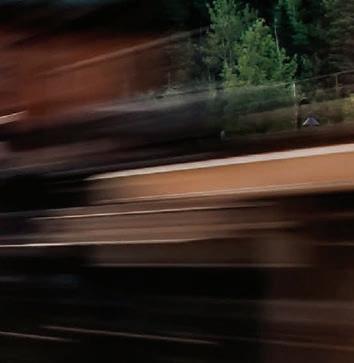

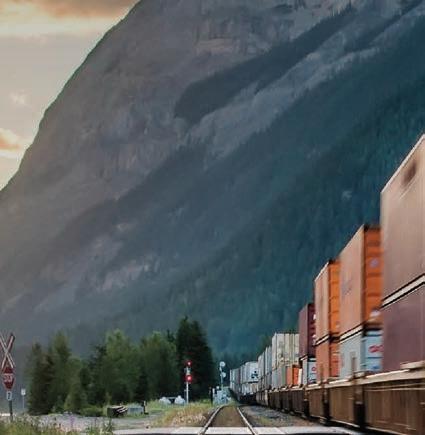

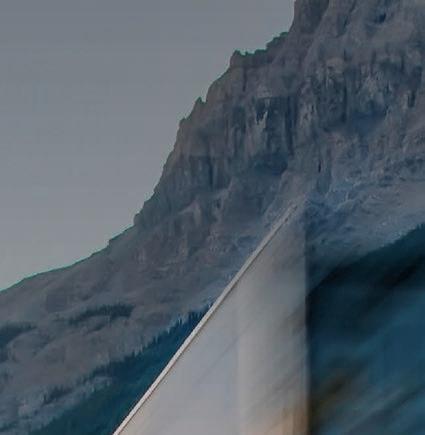
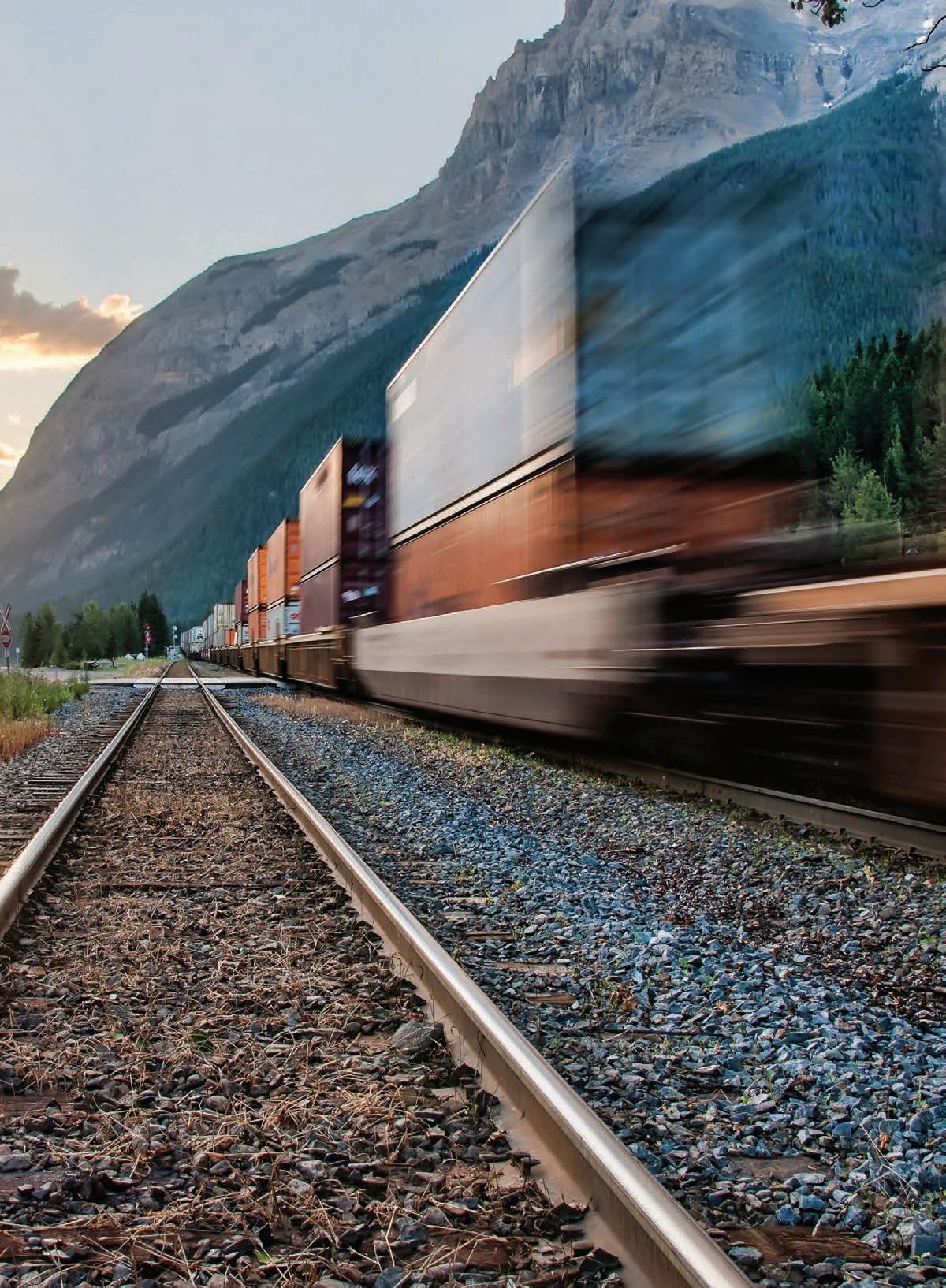
January 2023

 By David Schaar,
By David Schaar,
 Andrey Timofeev, Pallavi Kansal, Luke H. Young, and Grant Zeller
Andrey Timofeev, Pallavi Kansal, Luke H. Young, and Grant Zeller
Boston Consulting Group partners with leaders in business and society to tackle their most important challenges and capture their greatest opportunities. BCG was the pioneer in business strategy when it was founded in 1963. Today, we work closely with clients to embrace a transformational approach aimed at benefiting all stakeholders—empowering organizations to grow, build sustainable competitive advantage, and drive positive societal impact.
Our diverse, global teams bring deep industry and functional expertise and a range of perspectives that question the status quo and spark change. BCG delivers solutions through leading-edge management consulting, technology and design, and corporate and digital ventures. We work in a uniquely collaborative model across the firm and throughout all levels of the client organization, fueled by the goal of helping our clients thrive and enabling them to make the world a better place.
TrinityRail is an industry leader in providing railcar-based supply chain solutions to shippers and railroads in North America. With our breadth of over 700 customers and depth of products and services across the railcar life cycle, Trinity’s trusted experts deliver innovation that optimizes freight shippers’ supply chains. Our awardwinning new products and services continue to enhance customers’ businesses with lower costs, greater consistency, and simplicity.

Freight Rail’s Digital Future Is Just Around the Bend
Digital transformation is poised to promote a new era of growth in North American rail freight transport. The adoption of advanced tracking devices—known as telematics—has the potential to produce vast amounts of data on railcar location, condition, and health. Applying this data to improve the customer experience will help the rail industry grow its freight volumes after a decade-long decline in market share.
Leading industry stakeholders have formed a coalition, called RailPulse, to provide the shared infrastructure needed to capture, disseminate, and analyze data from telematics sensors. Application-layer developers will be able to tap into RailPulse’s data lake to provide shippers, railcar owners, and railroad operators with real-time visibility and insights to optimize their operations. Data-driven applications will augment the existing efficiency, sustainability, and safety benefits of rail shipping.
But realizing the full potential of telematics will require participation from across the industry. Shippers should explore the economic benefits of rail transport enhanced by data-driven visibility and insights. Railcar owners, railroads, hardware vendors, and application developers should collaborate to implement rail’s digital enhancements and create value. And all stakeholders can take steps to communicate the carbon-reduction benefits of shifting freight volumes from trucking to rail.
Freight Rail Is Losing Market Share, Despite Advantages
The rail industry’s struggles to maintain service levels as the US emerges from the pandemic have only aggravated the challenges that have suppressed its share of the landfreight market over the past decade or so. From 2011 through 2020, rail transport’s share of that market shrank from 51% to 37%, mainly owing to a sharp decline in coal shipments. In that same decade, truck transport’s market share grew from 49% to 63%. (See Exhibit 1.)
Exhibit 1 - In Freight Transport, Rail Is Losing Share to Trucking
Sources: US Bureau ofTransportation Statistics; US Energy Information Administration.
Note: Excludes freight transport by pipeline (18% of total in 2020), waterways (8%), and air (<1%). Because of rounding, percentages for a given year may not total 100.
US ton-miles of land freight carried (%) 29 28 28 30 30 30 28 29 28 28 22 20 18 19 17 14 13 13 12 9 49 52 54 51 53 57 59 58 59 63 2020 20112012 2019 2015 2013 Truck 2018 2017 2014 2016 Rail (coal shipments) Rail (excluding coal shipments)
This trend underscores a more basic problem: many shippers view rail as simply too hard to use compared with trucking. A key advantage of truck transport is the ability to provide end-to-end shipping, limiting the need to coordinate first- and last-mile handoffs. The trucking industry has increased this advantage by adopting untethered GPS tracking technology for trailers and containers, giving shippers real-time visibility into the location of shipments.
To close the performance gap and promote volume growth, the rail industry will need to relieve pain points experienced by participants across the value chain. (See Exhibit 2.)
Shippers. In an age of nonstop, digitally enabled interconnectedness, rail transport often remains an analog experience for shippers. Supply chain managers may have limited, if any, visibility of the geographic location of their materials. The problem lies, to some extent, with the shortcomings of the Automatic Equipment Identification (AEI) tracking infrastructure used by North American railroads. There is considerable variation in the spacing of AEI readers across lines and regions. In some areas, the distance between readers is 50 miles or less, while in others they are hundreds of miles apart. Moreover, the system does not provide real-time location status—when railcars pass a reader, several hours elapse before updates appear in the system. Some areas lack tracking infrastructure altogether. At interchange points, particularly when cargo is moving from main lines to short lines, shippers typically lose the ability to track location.
The challenges arising from antiquated technology and fragmented data sources mean that supply chain managers must rely on estimated times of arrival (ETAs) based on data that is hours, or perhaps days, old. This makes it hard for supply chain managers to optimally coordinate lastmile logistics, which in turn undermines other efforts to achieve operational efficiency—such as scheduling production shifts according to when incoming raw materials are expected to arrive.
Railroads and Terminal Operators. Railyards and terminals are chokepoints in the rail network because managers lack real-time visibility of their inbound pipeline. This prevents them from using advanced planning to gain efficiency. Moreover, modal transitions are inherently unwieldy to manage—myriad shipments arrive from multiple directions and might be outbound via a truck, ship, or another train. The sheer complexity drives a significant gap in reliability. The planned movements of railcars might be delayed or eventually postponed, leaving them unprocessed in the yard overnight or perhaps for days, depending on several factors including frequency of service. Shippers know that railcars with their freight are heading towards them, but are unclear on how many will arrive and on what day.
Exhibit 2 - Current Pain Points Across the Rail Value Chain
Shippers
• Unexpected delays
• Lack of accurate tracking
• Unreliable ETAs
• Uncertain payload conditions
• Inaccurate dwell-time reporting
• Slow railcar use cycles
• Inability to synchronize the supply chain
Source: BCG research.
Note: ETAs = estimated times of arrival.
Railroads and terminals
• Lack of real-time visibility to inbound pipeline at loading and unloading points
• Slow handoffs
• Congested railyards and tracks
• High cost of trackside infrastructure
Railcar owners
• Delayed maintenance and safety-issue reporting
• Reactive fleet management
• Lack of targeted maintenance
• Extended car-cycle times and slack capacity due to uncertainty and delays
Railcar Owners. Railcar owners—whether shippers, railcar lessors, railcar pool operators, or railroads—find it difficult to manage their fleets. Limited data on railcar utilization, location, and availability prevent greater precision in forward-looking fleet management. To absorb variances without sacrificing operations, owners must maintain significant slack capacity. And despite trackside infrastructure intended to sense potential maintenance issues, such problems can go unnoticed until they fully manifest, leading to unplanned downtime and costlier repairs. Even worse, potentially dangerous car conditions— such as excess pressure or temperature—may go undetected until accidents happen.
These pain points undermine what could otherwise be a desirable mode of freight transport. In fact, rail transport has several advantages that make it well suited to helping shippers meet the challenges of today’s economy:
• Efficiency. With extensive networks and trains that can carry the equivalent of hundreds of tractor-trailers, railroads can transport vast quantities of materials and products efficiently and economically. The significant cost savings give shippers opportunities to reduce the margin pressure caused by rising commodity prices and inflation. Depending on distance, payload, and cargo, the cost of rail transport can be 20% to 40% less than truck transport, according to the Journal of Commerce.
• Sustainability. The carbon footprint of rail shipments is 75% lower than that of truck shipments, according to academic and industry studies.1
• Safety. Compared with trucking, freight rail transport is safer for society. Studies by the Texas A&M Transportation Institute have found that rail-related fatalities are almost five times lower per ton-mile transported, while the injury rate is twelve times lower. In addition, rail transport’s lower pollution rates make it better for public health.
Shifting freight volumes from trucking to rail could also benefit society by reducing road congestion and wear and tear on highway infrastructure—thereby decreasing government spending on maintenance.
The Opportunities: Transparency and Optimization
The rail industry is on the verge of a digital revolution that has the potential to fundamentally transform rail freight transport through unprecedented data-driven transparency and optimization. In doing so, it can solve the pain points that have impeded growth and enable more shippers to capture the advantages of rail transport.
The revolution begins with tracking technology. The technology required to implement telematics tracking devices for railcars is either available today or being tested in advanced pilot programs. These devices will soon be widely deployed to transmit critical data on railcar location, condition, and health to shippers, railroad operators, and railcar owners. (See the sidebar “Railcar Sensors Are Already Available, and Many More Are Coming.”) With the right infrastructure, analytics, and interfaces in place, these parties can use the data to optimize their operations. And society will benefit from a greener mix of freight transport and improved safety. (See Exhibit 3.)
Location. Telematics devices that use GPS technology are currently available to transmit real-time information on train location. The information is more accurate and more frequently updated than that provided by trackside infrastructure. Once all fleets are equipped with these devices, coverage will be truly end-to-end— extending beyond the main rail lines to regional lines and yards where trains await processing.
With full deployment, shippers will gain greater transparency and far more accurate ETAs. They can apply the information to improve shipment management and operations, reduce cycle times, and synchronize their supply chains from end to end.
1.
Public: 2001–2019, 2022;
Texas A&M Transportation Institute, A Modal Comparison of Domestic Freight Transportation Effects on the General
Association of American Railroads, Freight Railroads & Climate Change Policies, 2021.
hibit ata rives enefits cross the ail reight cosystem
Location Condition Health
Shippers, forwarders
• Improved ETAs
• Greater predictability
• Peace of mind
• Assurance of required payload conditions (for example, refrigeration)
• Capacity utilization data
• Greater safety and reliability from improved car-maintenance outcomes
Carriers, operators Railcar owners Broader society
• Improved planning (for example, inbound queue)
• aster hando s
• Reduced congestion
• mproved eet management and planning
• Less slack capacity required Greener freight mix
• reaking traditional tradeo s that favor truck transport
• Growing rail’s share of freight transport
Source: BCG research.
Note: ETAs = estimated times of arrival.
• Assurance of required payload conditions throughout processing
• Greater reliability
• Improved failure prediction
• Reduced need for trackside infrastructure
• otification of any incorrect or potentially dangerous conditions (for example, handbrake on)
• ore efficient maintenance
• Targeted maintenance
• Improved failure prediction
• Higher utilization
Fewer adverse incidents
• Constant monitoring of volatile or dangerous payloads
• Predictive maintenance prevents equipment failures that could cause derailments
For railroads and operators of railyards, terminals, ports, and other modal hando points, widespread adoption of telematics will allow for advanced visibility of the inbound pipeline as well as live in-yard location tracking. perators can apply this visibility to optimize or even automate pipeline planning and receive A -generated recommendations for sequential car movements. Digital twins—digital visualizations of highly complex operations—will facilitate these e orts.
Railcar owners will gain a far more accurate and up-to-date view of their eet. hey can apply this visibility to improve eet management and, in time, may be able to reduce the need for slack capacity.
Condition. Other telematics hardware will transmit data regarding the condition of a railcar to stakeholders. This can assure a shipper that its payload has not been accessed via an open hatch by unauthorized parties, and that it is being kept at the re uired temperature or pressure if it is refrigerated or volatile. ondition data will enable auto-
mated corrective actions and dispatching of emergency personnel fire, police, or medical as the situation warrants. As more sensors become available to provide data from additional sources, companies will undertake even more valuable optimization e orts, such as improving car capacity utilization.
Health. Using telematics to report on railcar health is particularly valuable to railcar owners, who currently may only be able to perform occasional detailed checks on their e uipment. Sensors will provide real-time visibility of damaged parts. Railcar owners will apply condition data to automatically schedule maintenance, including prioritization based on urgency. hey will use machine learning to sense possible failures before they happen. his enables far more efficient, targeted, and predictive maintenance while improving reliability and dramatically reducing maintenance costs. lass railroads also benefit, as they will no longer need to maintain trackside infrastructure for sensing maintenance issues and will gain more detailed visibility.
Railcar Sensors Are Already Available, and Many More Are Coming
oday, railcars can be e uipped with telematics devices that provide data on location, impact detection, and external temperature. n both the near and longer term, many other devices, some of which are in the piloting stage, will
become available, o ering unprecedented real-time visibility and transparency to shippers’ supply chains and railcar owners’ assets.
Current and Future Telematic Data from Railcar Sensors
Near term
• Real-time location
Longer term
• Track-level location precision
• Proximity to other objects
Railcar sensors
Location Condition
• Impact detected
• External temperature

• Car empty or loaded
• Door/hatch open or closed
Health
Sources: RailPulse; BCG research.

• andbrake on or o
• In-car temperature, moisture, pressure, and light



• Refrigerator-car health and fuel level
• Liner health
• oad shifting or sloshing
• Weight of cargo
• Car capacity level
• Wheels and bearings: temperature
• Couplers: wear, forces between cars, and release
• Brakes: reservoir, line, and hose pressure
• Stability: hunting, pitch, yaw, and slack
The Key Enablers: A Shared Data Ecosystem and Application Layer
Today, the transformative benefits of data collected by telematics devices are largely theoretical. To make them a reality, rail freight industry stakeholders must act collectively. Otherwise, industry participants could end up using dozens of incompatible sensors, each with its own data currency and standards, none of which can communicate with each other or a common data repository. Moreover, to go beyond mere visibility and capture the full benefits of optimization, the industry needs application layers that tap into a common data repository to provide customers with analytics and a visualization platform.
A Secure, Cross-Compatible Ecosystem
The industry needs to create a secure, cross-compatible ecosystem to prevent the proliferation of different standards that would hamper the digitization of rail and ultimately harm the industry. The RailPulse coalition of railcar owners (including lessors, shippers owning their own fleets, and Class I and short-line railroads) seeks to provide this ecosystem. The coalition’s objective is to set standards for telematics—including hardware, compatibility, and other specifications—and to identify technology vendors. It will also provide infrastructure to collect, harmonize, aggregate, and store railcar data.
As David Shannon, RailPulse’s general manager, explains: “Very simply, telematics technology is coming whether RailPulse exists or not. Without RailPulse, it will come in many different ways, with owners and operators each doing their own thing. Instead of the industry working together with a shared data set, its actors will be using the technology as a weapon against each other. We want this technology to be used collaboratively to benefit the entire industry.”
Current members of RailPulse are GATX, Genesee & Wyoming, The Greenbrier Companies, Norfolk Southern, Railroad Development Corporation, TrinityRail, Union Pacific, and Watco. TrinityRail CEO Jean Savage emphasizes that the coalition’s central focus is to seek products and services to improve the customer experience. “Our guiding question is, ‘What can we take to our customers to make their lives easier and better?’,” Savage says. “This customer-centric approach has started to reach all ecosystem members.”
Crucially, the coalition will make key data visible across industry participants. An initiative by TrinityRail has demonstrated the benefits of cross-party visibility even before the rollout of cutting-edge telematics. Traditionally, each railroad has provided ETAs to customers using AEI data solely from its own infrastructure. To gain a cross-industry perspective, Trinity developed an ETA prediction model that draws upon AEI data from all railroads. Trinity found that its model based on cross-industry data reduced the difference between predicted and actual ETAs by 25%, on average. The huge improvements in ETA accuracy from visibility across companies are promising and foreshadow the expected dramatic improvements from an upgrade to telematics.
Building on the industry’s existing capabilities is a key component of RailPulse’s strategy. Earlier this year, RailPulse announced a partnership with Railinc, a subsidiary of the Association of American Railroads that offers a variety of products and services to simplify administrative tasks. The RailPulse ecosystem will benefit from Railinc’s experience processing and safeguarding vast amounts of data and interacting with rail industry participants. Among its services, Railinc provides location data sourced primarily from the Car Location Message (CLM) system. Using GPS and telematics infrastructure will allow RailPulse to improve upon the offering associated with legacy data sources, such as the AEI and CLM systems, by providing real-time location updates, including from railyards and shippers.
As RailPulse evolves, it will establish the integrated ecosystem of technology necessary to provide key benefits across the value chain—including transforming how different parts of the value chain interact with one another. By aligning on standards for future technology and data, RailPulse will enable the adoption of telematics that can provide a far wider breadth of data at a much more granular level than legacy sources currently offer. The ultimate outcome will be a fully end-to-end solution that simplifies rail shipping.
A Transformative Application Layer
Collecting data and ensuring its compatibility across stakeholders is only the beginning. To create value for rail customers, stakeholders need to apply the data effectively. This requires an application layer that utilizes techniques such as machine learning and predictive analytics to help companies improve operations and reduce costs. (See the sidebar “Telematics Applications in Action.”)
The base data is bound to be commoditized as market entrants access the data lake provided by RailPulse. That means the real value-creation potential will come from the application layer, where analytics and software are the differentiators for customers. Because the application layer will be the new customer interface, it must meet a high standard; indeed, given the potential for cost savings and reduced carbon emissions from shifting more land freight to rail transport, the application layer will be the hub for value creation in the industry.
RailPulse will soon be giving application-layer developers access to its data lake so they can provide real-time, endto-end location, condition, and health data to shippers, railyard managers, and railcar owners. RailPulse will also enable other providers of real-time visibility and analytics to participate in the ecosystem. (All parties, of course, will require appropriate authorization from individual car owners to access their data.) Expect traditional providers of rail-tracking data—such as RSI Logistics, Quality Logistics, and IntelliTrans—to tap into the new telemetry data and expand their offerings to build on their existing customer bases. “RailPulse can be the single source of truth for railcars in the industry by merging the new telemetry data with existing types of railroad data,” explains Shannon.
New applications that leverage real-time, end-to-end location and related information are coming to market. We spoke with shippers using the Trinsight logistics platform, a platform launched by TrinityRail that combines traditional industry location information with newly available advanced datasets. These discussions provide insights into the transformative potential of such applications, of which Trinsight will be just one of many available to shippers.
(See the sidebar “Voice of the Shipper.”)
Overcoming the Barriers to Digital Adoption
Better mobile connectivity, a new customer-centric mindset, and collaboration among participants are overcoming the traditional barriers to digital adoption in the rail industry.
Better Connectivity. The continued 5G rollout across North America is improving mobile connectivity. This is making it possible, and increasingly affordable, for sensors, railcars, and control centers to communicate seamlessly even across remote stretches of the railroad network.
Customer-Centric Mindset. Over the past two decades, the North American rail industry has emphasized innovating to improve operational efficiency. That focus made sense for railroads, which until a decade ago were maintaining freight share. It also worked for key customers, such as shippers of lower-value bulk commodities on main lines (for example, the coal industry), for which operational efficiency was a more pressing need than railcar-level visibility. For other customers, minimal visibility needs were already being met—for instance, unit-train shippers were satisfied with tracking locomotives and intermodal shippers could track their containers. Meanwhile, shippers that demanded better visibility could meet their needs by using truck transport with its more mature digital applications (albeit at a premium price).
In recent years, however, the customer base has shifted toward shippers with higher-value goods, more complex supply chains, just-in-time delivery requirements, smaller payloads, and/or railcar fleets dispersed over main and regional lines. These shippers have greater needs and expectations for the customer experience with respect to visibility and reliability.
After recent supply-chain disruptions and a year of particularly low service levels in North America, rail industry executives understand that they must adopt a more customer-centric mindset to grow volume. They recognize that digitization will be essential to improving the customer experience and achieving growth aspirations.
Collaboration Among Industry Participants. The new emphasis on digitizing to improve the customer experience is reflected in the growing number of Class I and short-line railroads participating in RailPulse. The collaboration will help the industry overcome technological barriers and demonstrate a return on investment.
Telematics Applications in Action
Several examples illustrate the use cases enabled by an application layer:
Fleet Management Dashboard
Problem: The coordinator of a paper company’s railcar fleet spends three hours a day searching multiple railroad websites to determine the current location of the railcars.
Solution: A telematics-enabled dashboard shows the location of the railcars. The dashboard auto-refreshes every five minutes to provide updated information and facilitate planning. The fleet coordinator can redirect his time from gathering data to solving problems.
Tamper-Detection Sensors
Problem: A food processing company’s head of security, primarily concerned with safety and chain of custody, needs to review online data to spot-check car movements and investigate incidents.
Solution: GPS and tamper-detecting sensors send automated alerts if railcar doors are open inappropriately and provide proof of incident-free delivery.
Self-Service ETA Dashboard
Problem: A customer representative at a large chemicals company spends most of his workday fielding questions from customers about the ETAs of rail shipments.
Solution: A dashboard designed for recipients is a self-service tool for checking ETAs. The ETA estimates are provided by artificial intelligence and refresh automatically.
Temperature Sensors
Problem: The manager’s team at a receiving terminal for refined fuels needs to heat railcars so the fuel reaches the optimal viscosity for unloading. However, the team must avoid overheating the cars and damaging their lining.
Solution: Temperature sensors can measure the fuel’s temperature so the heating process can be performed efficiently and safely. The data also provides evidence to refute any claims that the product or railcar has been damaged.
Data Consolidation Platform
Problem: A logistics broker must go to the websites of multiple third-party logistics companies and GPS providers to access location information and ETA estimates.
Solution: A next-generation telematics application consolidates all data sources in one platform for ease of use and accessibility.
Voice of the Shipper
What do rail freight shippers want and expect from the application of telematics? Two industry leaders shared their insights with us:
The Mosaic Company
The Mosaic Company—the largest US producer of potash and phosphate fertilizer—makes considerable use of rail freight and manages its own rail yards. The company’s railyard management system entailed a significant amount of manual data entry relating to railcars’ availability, cleaning status, and inspection status. The company also manually tracked the number of “bad order” cars—that is, those awaiting or undergoing repairs. Staying current required constant input from crews around the yard.
“We didn’t have the complete visibility to aid in executing our daily plan,” said David Kirkpatrick, the company’s senior manager of rail transportation. “We hoped that telematics would allow us not only to eliminate manual data entry but also improve a variety of yard-management metrics.”
The company used the Trinsight logistics platform to implement a digital replica of its railyard. This digital twin enables yard managers to keep closer track of every car’s status and location and optimize operations.
“Since implementing the digital twin solution, we can see that the velocity of cars is improving,” says Kirkpatrick. Beyond moving cars around the yard faster, Mosaic also saw improvements in several other performance measures, including reductions to the bad-order count and a decrease in dwell time.
Western Canadian Shippers’ Coalition
The Western Canadian Shippers’ Coalition (WCSC) is an industry group whose constituents collectively ship billions of dollars’ worth of cargo domestically and internationally. As the organization’s president and CEO, David Montpetit is deeply familiar with the status and potential of digitization in freight rail transport, as well as shippers’ pain points and expectations.
“Digitalization within the rail sector is still in its infancy,” he says. WCSC is among the early adopters. It has partnered with TrinityRail to stand-up performance dashboards that industry constituents can apply to make informed supply chain decisions and identify areas of opportunity.
According to Montpetit, the first pain point that can be solved by digitization is a lack of information. Shippers that have GPS capabilities and automated alerts enabled by geofencing now have their own robust, real-time data and no longer must manually piece together location data from multiple sources. “Given the scope of the benefits, digitization is a huge priority for my organization,” he says.
Visibility is only the beginning. Montpetit sees a future in which shippers’ data systems fully integrate dynamic ETA data enabled by telematics. “Telematics is the ‘missing link’ that connects supply chain, production, and shipping models so that rail freight can move smoothly.”
The potential climate benefits add to the urgency. “Shippers are under a lot of pressure to reduce their carbon footprint,” Montpetit says. By implementing digital solutions to improve the customer experience, railroads could make it more feasible for shippers to gain the environmental benefits of rail transport versus other modes, such as trucking.
For these reasons, among many others, Montpetit’s industry constituents are pressing for service improvements. “There has to be a greater sense of urgency across the board to broadly roll out the benefits of telematics for shippers.”
By developing shared standards and serving as a clearinghouse for data and permissions, RailPulse is providing a universal plug-and-play architecture for rail users and vendors. Additionally, it is utilizing an initial set of pilots, vendor vetting, and bulk purchasing to ump start the use of sensors while keeping costs low and promoting supplier competition.
Early trials and proof-of-concept pilots are demonstrating the return on investment in telematics and laying the groundwork for wider adoption, atter learning curves, and greater demand from shippers. As adoption increases, companies will capture benefits that re uire critical mass such as improving the management of railcar eets or pools or eliminating the burden of having trackside maintenance infrastructure—allowing them to create additional value. (See Exhibit .)
he result will be a virtuous cycle. ontinued adoption by users with the greatest need and sophistication will increase incentives for technology providers to o er the application layer that transforms data into insights for optimizing operations. In turn, as greater scale increases the value of benefits, other industry participants will be motivated to invest in digitization.
Accelerating Adoption Across the Value Chain
By preparing for this digital revolution, shippers and other rail industry stakeholders can accelerate adoption and enhance the value created.
Shippers. Current rail customers should continue to press railroads to give them better visibility and insights. his could include, for example, access to RailPulse equipment and the necessary analytics platforms. Shippers not currently using rail transport should reconsider using rail to capture the benefits of safety, efficiency, and sustainability as enhanced by telematics.
Exhibit 4 - The Stages of Telematics Adoption
Increasingadoption
Next 10–15 years: full system
Regions
• Visibility to shippers of key shipments
• Assurance of proper payload conditions
• Maintenance data for specific cars
Source: BCG research.
• ull eet management (for example, availability and slack capacity)
• Integration with shipper or owner supply-chain systems
• Automated and intelligent maintenance regimes for eet owners
Railcar pools
• Yard management tools
• Predictive maintenance for managed cars
• Onsite safety and security
• Full next-generation maintenance regimes for railcar pooling companies
• Improved management of pooled resources
• enefits across discrete pools (for example, temperature for refrigerator-car pools)
• Removal of trackside infrastructure (such as for maintenance) in regions where telematics are adopted
• Implementation of auto-refresh digital twin systems in regional railyards
• Removal of trackside infrastructure in all regions
• Optimization of network operations
• Establishing prerequisites for full system automation
Examples of benefits
Today: individual cars
Discrete fleets
Discrete sites
To prepare for discussions with railroads, shippers should explore the potential economic benefits of digitization for their own business, including the return on investment. Shippers can already access some digital insights, most notably real-time location data, from some railcars and suppliers. n the coming years, however, shippers will benefit from the technology and data standards set by RailPulse, including an expanded suite of sensor data (such as for monitoring on-board payload conditions and railcar health) across railcars participating in the coalition. y understanding the business benefits, shippers can also gain confidence to lease or own their railcars.
To realize value from rail’s digital innovation, shippers must raise the sophistication of their supply chain function. his includes installing tech-forward solutions (such as an adaptable enterprise resource planning system), hiring sta with skills to use digital applications, and retraining current sta . hey also need to decide on their preferences for communication and data sharing (one-way versus two-way). As an alternative to maintaining in-house capabilities to use digital innovations, shippers could consider working with third-party logistics providers that have the re uired capabilities.
Railcar Owners, Lessors, and Class I Railroads. For these companies, accelerating adoption is crucial to growing freight volumes and winning back market share from truck transport. Actions include deeply understanding the benefits of telematics and collaborating with industry players to develop standards, applications, and interfaces (such as through participation in Rail ulse). o demonstrate the benefits to shippers, the rollout of telematics should begin with high-value cars (for example, refrigerated cars carrying perishable goods), discrete eets where utilization can be improved, or specialized eets where condition and or health visibility is critical.
Hardware Vendors. Providers of sensor hardware should continue innovating and can be assured that Rail ulse supports an open source platform to accommodate new
sensor and communications solutions. This digital revolution is still in its infancy and the potential exists for new types of sensors that can solve key pain points in railroad operations.
pplication ayer e elopers Potential developers of the application layer include not only software companies but also railroads, railcar lessors and manufacturers, and third-party logistics providers seeking a new revenue stream. They will play a key role in ensuring that industry participants can extract value from the vast amount of data that becomes available instead of being overwhelmed by the abundance. o enable this, developers need a deep understanding of operators’ and shippers’ pain points. The applications designed to address customer needs should use cutting-edge analytics, such as machine learning, to maximize sophistication and value creation.
All Stakeholders. inally, when weighing the benefits of telematics, all stakeholders should consider that shifting freight volumes from trucking to railroads can improve safety and reduce carbon emissions. Shippers must be able to measure the reduction in their carbon footprint, identify the potential for further improvements, and share this information with their shareholders, customers, and the public. o accomplish this, shippers will need to build new or additional analytics capabilities and, potentially, implement a new approach to data management. To facilitate sustainability analysis and reporting, other rail industry participants must be able to furnish the re uired data with the appropriate granularity, frequency, and accuracy.
The stars are aligned for the rail freight industry to reclaim market share. he benefits of rail transport are especially valuable for shippers today, while imminent digital innovations promise to ease longstanding pain points for all stakeholders. Railcar owners, railroads, and other industry participants have abundant incentives to join forces to accelerate the adoption of these innovations. Simply put, now is the time to bring more freight volumes o the asphalt and back onto the rails.
About the Authors

Acknowledgment of TrinityRail
BCG prepared this publication in collaboration with TrinityRail. The authors thank the company’s leaders for contributing insights into the rail industry and telematics technology, facilitating discussions with their customers and the leaders of the RailPulse coalition, and providing data for analysis.




For Further Contact
If you would like to discuss this report, please contact the authors.
David Schaar is a managing director and partner in the Philadelphia office of Boston Consulting Group. You may contact him at schaar.david@bcg.com
Pallavi Kansal is a managing director and partner in BCG’s Atlanta office. You may contact her at kansal.pallavi@bcg.com.
Grant Zeller is a consultant in BCG’s Philadelphia office. You may contact him at zeller.grant@bcg.com.
Andrey Timofeev is a managing director and senior partner in the firm’s Chicago office. You may contact him at timofeev.andrey@bcg.com
Luke H. Young is a principal in the firm’s Boston office. You may contact him at young.luke@bcg.com
Boston Consulting Group partners with leaders in business and society to tackle their most important challenges and capture their greatest opportunities. BCG was the pioneer in business strategy when it was founded in 1963. Today, we help clients with total transformation—inspiring complex change, enabling organizations to grow, building competitive advantage, and driving bottom-line impact.
To succeed, organizations must blend digital and human capabilities. Our diverse, global teams bring deep industry and functional expertise and a range of perspectives to spark change. BCG delivers solutions through leading-edge management consulting along with technology and design, corporate and digital ventures— and business purpose. We work in a uniquely collaborative model across the firm and throughout all levels of the client organization, generating results that allow our clients to thrive.
Uciam volora ditatur? Axim voloreribus moluptati autet hario qui a nust faciis reperro vitatia dipsandelia sit laborum, quassitio. Itas volutem es nulles ut faccus perchiliati doluptatur. Estiunt. Et eium inum et dolum et et eos ex eum harchic teceserrum natem in ra nis quia disimi, omnia veror molorer ionsed quia ese veliquiatius sundae poreium et et illesci atibeatur aut que consequia autas sum fugit qui aut excepudit, omnia voloratur? Explige ndeliaectur magnam, que expedignist ex et voluptaquam, offici bernam atqui dem vel ius nus.
Nem faccaborest hillamendia doluptae conseruptate inim volesequid molum quam, conseque consedipit hillabo. Imaio evelenditium haribus, con reictur autemost, vendam am ellania estrundem corepuda derrore mporrumquat.
For information or permission to reprint, please contact BCG at permissions@bcg.com.
To find the latest BCG content and register to receive e-alerts on this topic or others, please visit bcg.com. Follow Boston Consulting Group on Facebook and Twitter.
© Boston Consulting Group 2022. All rights reserved. 1/23
Add Co-Sponsor logo here
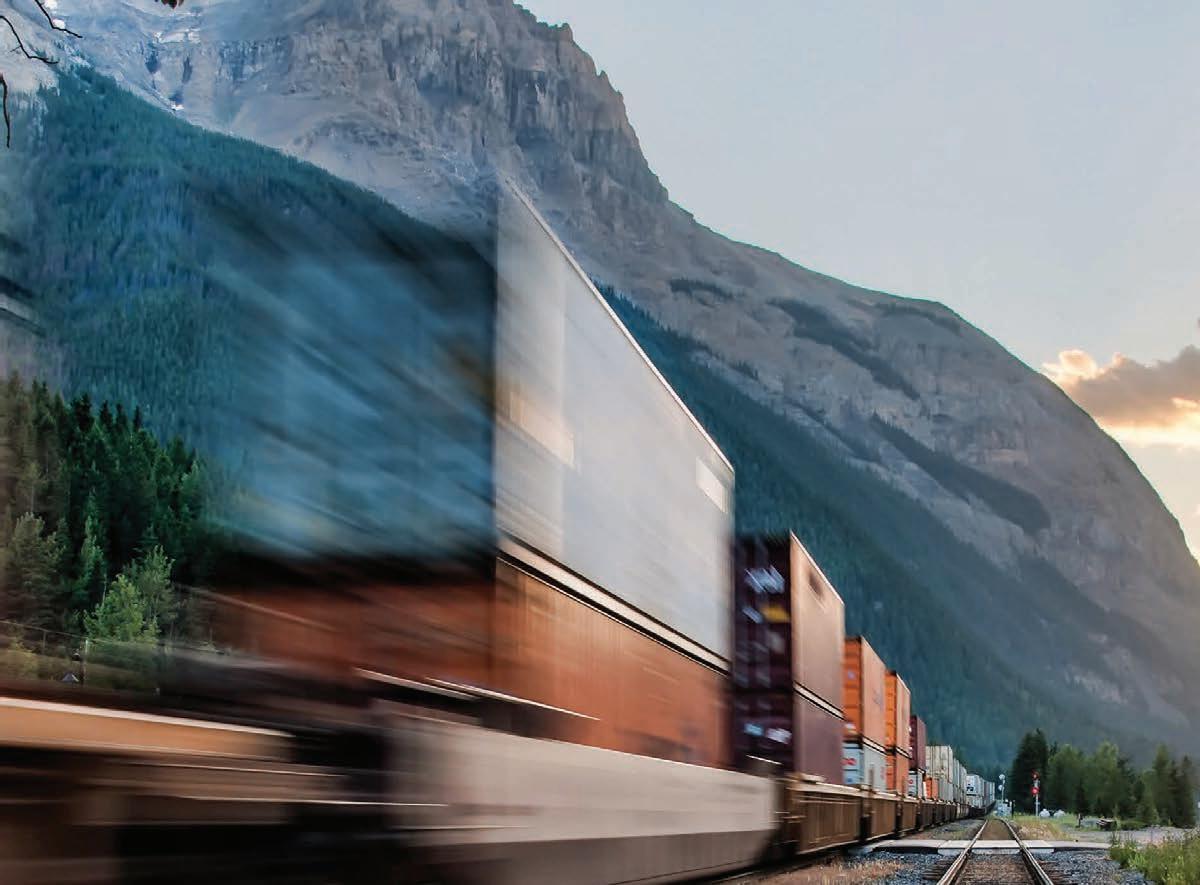
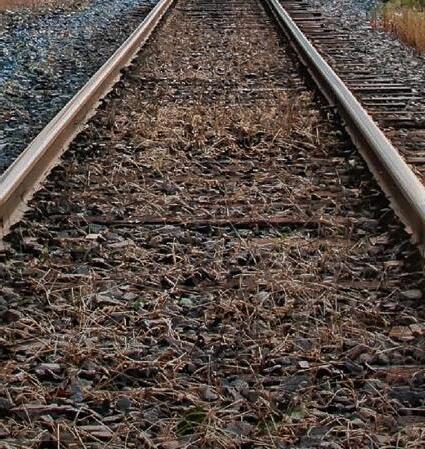


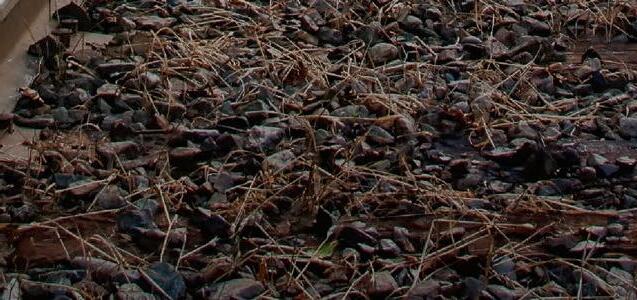
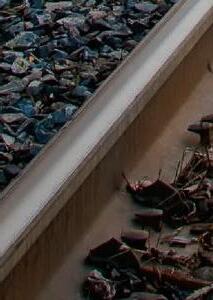


FOLLOW THE MEGAWATT-HOURS HYDROGEN FUEL CELLS, BATTERIES AND ELECTRIC PROPULSION
A discussion of propulsion options for freight rail is offered by seasoned locomotive mechanical engineer Michael Iden, a former mechanical department officer with Union Pacific, offering insight from his years of practical experience with new technologies and research and development.
BY MICHAEL IDEN, P.E., CONTRIBUTING EDITOR
As the railroad industry moves toward decarbonized propulsion, it’s critical that we start looking analytically at each technology and supporting infrastructure, and begin developing the comparative economics. We’re talking, in this article, about hydrogen fuel cells and propulsion batteries (plus one very mature technology that continues to be “written o ,” and a unique variant).



Managing technology is never easy, and new technologies always introduce a sometimes unclear mix of bene ts and risks. Borrowing an adage from carpentry: “measure (at least) twice and cut only once.”
Our industry has been dieselized for 63 years (Class I steam died May 7, 1960), having
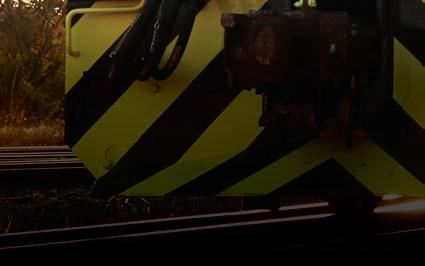
evolved from the steam-to-diesel transition (1940-1960) plus a previous decade-plus of research, trial and error. Coal as locomotive fuel was o en 10% of all carloads. e infrastructure was massive and labor-intensive. A single steam locomotive could consume 90,000 gallons of water between New York City and Chicago. e transition to diesel was a classic example of disruptive industrial innovation with positive and negative impacts on railroads, employees, stockholders, suppliers and communities.
Railroads did become more productive; today, they produce 63% more work (gross ton-miles, GTMs) annually using only 1/9th the equivalent energy as they did in 1945, steam’s peak.
Upfront disclosure: As a trained professional
engineer, I believe there will be valid applications for both hydrogen fuel-cell and batteryelectric locomotives, but neither is a “one size ts all ‘silver bullet’ solution.” Also, I’m not giving up on diesel engines, as they could be hybridized by adding propulsion batteries (a separate discussion for another time).
is is very clear: Decarbonized grid electricity will increasingly be our primary energy source. Clean renewable electricity (some call it a trillion-dollar national investment) will manufacture hydrogen and recharge batteries. But it can also power electri cation of selective heavy-density routes. We cannot dismiss any option without a factual assessment. e business cases for hydrogen and batteries should be prepared and compared to the case for electri cation (along with a business case for
March 2023 // Railway Age 41 railwayage.com
Progress Rail
TECH FOCUS – MECHANICAL
Progress Rail EMD® GT38JC Joule
a unique variant o ering faster cash payback).
Another reality: e “pull any train on any railroad” diesel locomotive will gradually be supplanted or possibly replaced, by new technologies. New-technology locomotives may not be common or interchangeable when introduced, and completing rail decarbonization will likely take 15-to-20 years (the 2050 target for net-zero carbon is only 26 years away!). Fuel cell and battery-electric locomotives will be “corridor and infrastructure limited” until thousands of such new units are in service, drawing attention again to infrastructure requirements and comparative energy e ciencies.
SELECTING PROPULSION TECHNOLOGIES: HOW MUCH TONNAGE MOVES WHERE?
Railroads should, in a serious and unbiased way, re-examine electri cation of the heaviestdensity trackage (7% to 10% of the 140,000 U.S. route-miles that handle about 30% of all GTMs). I’m not suggesting a “Switzerland approach” stringing catenary over all tracks (even in yards). e amount of transportation work (GTMs) drives the energy needed (energy is “the capacity to do work”).
Electrifying the smallest part of our network carrying the greatest tonnage will have a positive and ampli ed e ect on our competitive energy e ciency. e remaining network can be powered with hydrogen fuel cells and/or batteries (or enhanced diesel locomotives), with each technology achieving an optimum solution.
WHERE DO WE GET HYDROGEN?
Hydrogen must be manufactured, preferably using “clean renewable” (zero-carbon)
electricity to power a process called electrolysis. An “electrolyzer” uses electricity to disassociate or break apart water molecules (H2O) into H2 and O2, and then we need even more electrical energy to compress or liquefy (“cryogenically refrigerate”) the H2 to make a practical and transportable “energy carrier” for locomotives or H2 fuel tenders. Chemically, 2.4 U.S. gallons of deionized (not ordinary “tap”) water can be converted into 1 kilogram (kg, roughly 2.2 pounds) of hydrogen with an energy content roughly the same as 1 U.S. gallon of diesel fuel. But electrolysis also needs signi cant amounts of water for process cooling, as much as 15-to-25 U.S. gallons of water per kilogram of hydrogen. Plus (critical in comparing hydrogen fuel cells to selective electri cation) about 1.5 megawatt-hours of “input” electrical energy is needed to produce 1 megawatt-hour of energy stored in hydrogen.
e 67% grid-to-hydrogen energy e ciency is the inevitable result of “process ine ciencies” (33% of the input energy is “lost”).
Looking at a fuel cell-for-diesel replacement scenario, in 2019 BNSF reported pumping up to 300 million gallons of diesel fuel annually at Belen, N.Mex. (population 7,423). Assuming all diesels through Belen were replaced with fuel cell locomotives, the 300 million gallons of diesel would be replaced by 300 million kg of hydrogen. Making that much hydrogen will require 12-to-20 million gallons of water every day (4.4 billion to 7.3 billion gallons every year), equal to 18% of neighboring Albuquerque’s water demand for 563,000 people. Recall that the Santa Fe Railway rst dieselized across Arizona and New Mexico 1940-1942 to overcome the lack of “good” boiler water. And the southwestern U.S. is now in a monumental drought. Will there be enough water and
renewable electricity? “Maybe” is not a sucient answer for a major project.
Can hydrogen be a hybrid fuel? Yes, perhaps as a “dual fuel” alongside diesel in modi ed diesel engines, instead of being consumed by fuel cells, but not necessarily in all diesel engines.
GRID TO RAIL ENERGY EFFICIENCY: MEGAWATT-HOURS
“IN”, GTMS “OUT”
Figure 1 (opposite) shows the numbers. e calculations and assumptions are mine. I am de ning “energy e ciency” as the percentage of grid power (input energy) that reaches the rails as traction work (energy at the rails). I’m using 10 MWh at the rails for mathematical simplicity. (As reference, a 5,000-U.S.-gallon diesel fuel tank contains about 72 MWh of “usable” energy that can be delivered to the rails as traction work. And one MWh is the same as 1,341 hp applied for 1 hour.)
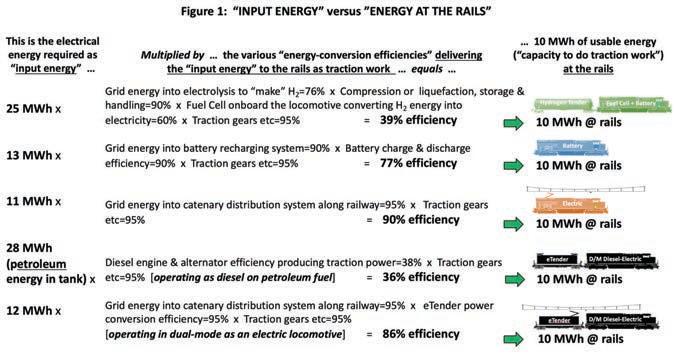
Conventional electric locomotives have the highest apparent grid-to-rails energy e ciency (90%), followed by battery-electric locomotives (77%) and then hydrogen fuel cell locomotives (39%). Electric locomotives on a heavy-density route have the greatest potential for regenerating and reusing dynamic braking energy, further improving their e ciency.
BATTERY LOCOMOTIVES FOR LONG HAUL?
Experimental battery-electric locomotives are advancing through early development stages. I’ve ridden on one, and the technology is impressive. ey will be limited by the amount of energy that can be stored onboard and unlikely to match the operating range of modern diesel locomotives (at least with the current battery technologies). Less operating range means more frequent stops to “refuel” (recharge). Yes, dynamic brake energy can be recovered, but it isn’t a universally determinable quantity. It will be dependent on route topography, and railroads o en limit the amount of dynamic braking for train handling safety.
at makes hydrogen fuel cell locomotives (with lower grid-to-rails energy e ciency) likely our best option for many—but not all— line-haul U.S. freight operations. As I stated earlier: “As a trained engineer, I believe there will be valid applications for both hydrogen-fuel cell and battery-electric locomotives, but neither is a ‘one size ts all “silver bullet” solution.’”
42 Railway Age // March 2023 railwayage.com
FOCUS – MECHANICAL
TECH
ET TU, FUEL CELLS?
Why is fuel cell technology for rail seemingly less energy e cient than battery? Fuel cells involve more “energy conversion e ciency losses.” Again, see Figure 1. But hydrogen fuel cells have greater operating range than batteries, so we trade o lower e ciency for longer operating range.
BACK TO THE STRAIGHT ELECTRIC OPTION
We need to electrify only the heaviest density main lines—11,900 route-miles or 19,000 track-miles (assuming 1.6 main tracks per route-mile) handling 30% of U.S. rail freight GTMs at the lowest energy cost. is points to several key corridors: Chicago to Ogden, Barstow, Bu alo and Pittsburgh, plus Vancouver-Calgary. e Powder River Basin would have been a natural candidate but is in decline.
e classic “arguments” against railroad electri cation include “excessive” capital investment. However, no hydrogen or battery charging infrastructure has been designed, and none built, for unknown dollars, so what constitutes “excessive”?
Remember the claimed intolerance for electric locomotives geographically tethered to catenary? Hydrogen fuel cell and battery locomotives will also be tethered to their own edgling infrastructures until both become jointly and universally adopted “everywhere.”
No form of energy will ever be risk-free. Example: Hydrogen prices nearly tripled in the summer of 2022 due to high electricity prices in Texas, combined with other technical challenges.
ELECTRIFICATION CAPEX IN PERSPECTIVE
Assume US$3.5 million per track-mile for freight-speed electri cation translates to $66.5 billion for electrifying 19,000 trackmiles. is is equivalent to funding only six Belen-size hydrogen production sites, plus a small eet of fuel cell locomotives and H2 tenders.
Fund it from either future rail earnings, energy savings or from one or more toll-based “pay as you go” funding projects by the feds or a new infrastructure bond program. Why not negotiate a second party building the catenary, selling power to the railroad and transmitting renewable electrical power along the right-of-way?
IN CONTRAST, SOME NUMBERS TO CONSIDER (AND DEBATE)
How much investment is needed for hydrogen infrastructure? e world’s largest renewable hydrogen plant is now being completed in China to produce “only” 20 million kg of hydrogen annually at a capex of about US$500 million (unadjusted for China’s labor and material costs). Scaling that example to a projected annual 300 million kg hydrogen demand at Belen gives us an equivalent capex of roughly US$7.5 billion, and we still need to add capex for large-volume H2 storage and transfer hardware for “refueling” and a eet of cryogenic liquid or high-pressure compressed H2 fuel tenders, in addition to hydrogen fuel cell locomotives. Round up to US$10 billion for the H2 plant and a “starter eet” of fuel cell locomotives and H2 tenders. Multiple that by multiple locations/corridors.
Pumping 300 million kg of hydrogen per year is equivalent to hydrogen refueling of 100 Toyota Mirai fuel cell cars every minute. ( e only world-class global entity in transferring large volumes of hydrogen is NASA.)
Railroads are unlikely to build massive hydrogen plants, but will ultimately pay for the electrical energy used in making hydrogen, impacting operating costs.
A UNIQUE SEGMENTED APPROACH TO ELECTRIFICATION
ere is a unique alternative to “conventional” electri cation, involving a concept I rst envisioned many years ago during my Class I career (and others have likely had similar thoughts). My LLC has been developing the concept since 2019, and since 2020 in cooperation with CAD Railway Industries from Montreal: “discontinuous electri cation” and
diesel-electric locomotives modi ed to accept “overhead power” through power connections from an “electric power tender” (an “eTender”). See Figure 2 (above).
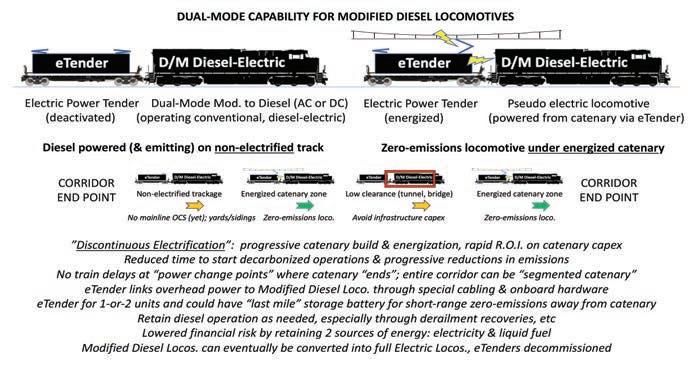
e “eTender” collects high-voltage power from the energized overhead catenary, conditions and passes it into a modi ed diesel locomotive, substituting for power from the diesel engine/traction alternator, enabling low- or zero-carbon operation. My LLC and CADRI have been discussing this concept with a major international heavy haul railroad seeking the optimum approach to rail decarbonization.
From an economic perspective, “discontinuous electri cation” and “eTender” technology will enable a heavy-density railroad to rapidly start “zero emissions” along a corridor as soon as fractional (even disconnected) segments of catenary are installed and energized (example: Willow Springs-Galesburg, then BarstowBelen), instead of waiting for the entire corridor to be electri ed (Corwith-Los Angeles).
e nancial risk of a single energy source, be it grid electricity, hydrogen or diesel, is reduced by enabling selective use of two forms of energy. e railroad gains “energy leverage” (unavailable for 63 years) and a faster return on invested capital.
BOTTOM LINE
All propulsion technology options, including infrastructure needs and grid-to-rails energy e ciency, must be thoroughly and professionally evaluated. And railroads need to be active in those discussions.
Remember the sage advice of late New York Yankee catcher Yogi Berra: “If you don’t know where you’re going, you’ll end up somewhere else.”
March 2023 // Railway Age 43 railwayage.com TECH FOCUS – MECHANICAL
Figure 2:
MAKING OR BREAKING SAFE TRAIN OPERATION

In-train forces—buff and draft— can literally make or break safe train operation if not properly controlled. Critical components—couplers, draft gears and end-of-car cushioning units—from such suppliers as Strato, Miner Enterprises, Amsted Rail and McConway & Torley must be capable of managing thousands of tons of force. Following is a roundup of offerings from these suppliers, as well as Railinc, which provides component tracking technology that enhances safe train operation.
STRATO

“A lot of our larger development efforts
right now are in end-of-car cushioning,” says Strato Chief Engineer and Manager Jonathan Sunde, who adds that the company’s Selective Cushioning Unit (SCU) has been in service for about five years in various degrees.



But new for Strato this year, Sunde says, is that the company has added its own in-house impact test capabilities whose primary initial purpose includes “continuous development and characterization testing on the company’s cushion unit line.”




“Moving all our efforts with individual unit testing, cycle testing, and proof loading and everything else we do in-house to perform full-scale impact

tests—which we did previously with third-party facilities like MxV Rail— re-ups our commitment to the product line and its continuous development, as well as to some new iterations we’re working on to improve retrofitting costs on different car types,” Sunde says. “In continuing these efforts, we’ve been chasing after the retrofit cost to make it a direct swap for existing units to really help what our customers are searching for. On the draft side, we have an established and mature product line, from yokes to coupler bodies and knuckles and all the jewelry that goes along with it.”
In addition to alternative draft
44 Railway Age // March 2023 railwayage.com
Critical components like couplers, draft gears and end-of-car cushioning units must be capable of managing thousands of tons of force. BY CAROLINA WORRELL, SENIOR EDITOR
Miner Enterprises
Installed in the railcar pocket, the Miner FCS® uses two draft gears in a specialized tandem arrangement.



Amsted Rail, the global leader in fully integrated freight car systems for the heavy haul rail market. MORE THAN PARTS. PERFORMANCE. amstedrail.com Amsted Rail is proud to be a co-host of the 20th International Wheelset Congress in Chicago from May 8-11, 2023! Learn more today at IWC2023.com.
Technology Focus – Mechanical
systems, Strato also offers a full portfolio of coupler and truck products. The coupler components have been at the forefront of the news recently, as they are subject to an ongoing International Trade Case (ITC).

“That case went through the ITC process, and in June of last year, it was ruled in a unanimous 5-0 vote in Strato’s (and anyone else operating in China) favor, saying there had been no dumping,” says Strato Vice President of Sales and Marketing Rocky Loessin. “What was interesting about that case is that there was a lot of very good data presented about our products and what we use, which is called
Bedloe technology, for our couplers and knuckles that help them last longer in the field.”
According to Strato, non-Bedloe coupler bodies, when compared to Bedloe coupler bodies, “failed approximately four times more often,” adding that “thanks to their superior durability, Bedloe Freight Rail Components (FRC) need to be replaced less often, leading to lower long-term operating costs.”
According to Loessin, another ITC case was recently filed by McConway & Torley and Amsted Rail’s United Steelworkers Local 1063 against all coupler imports from China and Mexico. This case is ongoing.
In addition to alternative draft systems, Strato also offers a full portfolio of coupler and truck products.

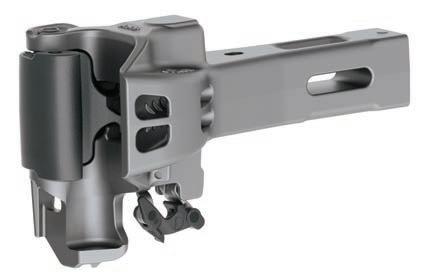
“We’ve stopped importing until the case is resolved,” says Loessin. “There are still a lot of questions about what the scope looks like and whether new car builds will be affected. But the real science, the real effort that goes into it is on the foundry and production sides, where our strengths lie. You can’t really do a whole lot for new divergent products because they must fit into the same stuff. So, our manufacturing method and longevity is where we feel we shine on those product lines.”
When asked if there is any other type of research and development the company is doing, Sunde says that Strato, which currently employs Strato, Inc.
46 Railway Age // March 2023 railwayage.com
a team of 14 engineers, “maintains a basis to grow through development, and is constantly reinvesting a portion of its sales back into development efforts to continue solving existing problems covered by existing product lines, and finding ways to expand upon its portfolio that centers around solving problems, not just making ‘me-too’ products.”
From a general market perspective, Strato says it looks like it’s going to be a good year for new car builds— somewhere between 40,000 and 50,000 new cars are going to be built in 2023. “That market continues to thrive on the new builds,” says Loessin, who adds that “there’s a lot of interest in getting out of the standard hydraulic cushioning units.”
“A lot of those builds are flipping over to alternative draft systems, including ours,” says Loessin. “There are still some hydraulic units that are getting placed mostly on boxcars at this point as we work through what pool requirements look like. But that’s a good market. We have a strong aftermarket drive on our SCU in the sense that our retrofit program is second to none in being able to keep a safety stock of inventory and ship within a day or two of getting an order. That’s important for shops. We’re seeing retrofits on center beams, coil cars, etc. And we see a pretty good market continuing for the next several years. Most of the railroads do not want hydraulic units on cars. They are bad for train handling. A lot of customers understand that hydraulic units are notoriously bad for maintenance costs. They fail often, so they don’t necessarily provide the impact protection they should. So, we continue to see market penetration for alternative draft systems in general and specifically what we can speak to is the Strato system.”
Regarding Strato’s Bedloe technology for couplers, the company says it’s going to be somewhat limited this year because of the ITC case, but adds that one way or the other, it will be back in the U.S. market.
“The data that came out in the first ITC case speaks for itself,” says

Technology Focus – Mechanical
Loessin. “Our superior technology has already proven itself and continues to benefit both the Class I railroads and private shippers. And, regardless of the ITC, we will continue to support our Canadian and Mexican partners.”
MINER ENTERPRISES
Often with hydraulic-based systems, energy is not efficiently managed. Short life cycles lead to costly maintenance; and assets are not sufficiently protected when broken knuckles, hose separations and lading shifts interrupt operations, says Miner Enterprises, which, with 127 years of experience in railcar equipment design, is “one of the industry’s top suppliers of draft gears, brake beams, gates, constant-contact side bearings and other high-performance components.”
The Miner FCS®, the company says, is designed to “raise the standard of protection currently being provided by traditional hydraulic cushioning devices.” Installed in the railcar pocket, each Miner FCS® uses two draft gears in a specialized tandem arrangement. “Utilizing Miner’s proven draft gear technology, Miner FCS® minimizes free movement caused by slack, which prevents premature wear, lowers maintenance costs and better-protects assets,” the company notes. “It also improves
operations by reducing service interruptions and providing the flexibility to safely operate longer trains.”
The Miner FCS® also mitigates run-in and run-out events by combining draft gear friction with Miner’s patented TecsPak spring material. This, Miner says, “leads to fewer lading shifts, broken knuckles and hose separations—root causes for undesired stoppages and costly delays often associated with hydraulic units.”
Miner notes that the FCS® “installs easily on refrigerated and standard boxcars, steel coil cars and flat cars, including center beam and general service flats.” The company has been collaborating with Class I railroads for several years in developing the Miner friction cushioning system. More than 4,000 Miner FCS®-equipped cars are in service, with a combined 100-plus million service miles.
AMSTED RAIL
Amsted Rail’s Active Draft Cushioning Units are designed “to maintain compression, providing optimal protection against both the draft and buff stresses railcars experience whenever the train stops or moves.”
Unlike a standard cushioning unit, which is metal-on-metal with a fully extended neutral position, the Active Draft Cushioning Unit has polymer
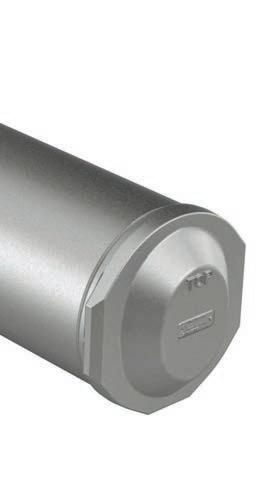
Amsted Rail’s Active Draft Cushioning Units are designed “to maintain compression, providing optimal protection against both the draft and buff stresses railcars experience whenever the train stops or moves.”

March 2023 // Railway Age 47 railwayage.com
Amsted Rail
Technology Focus – Mechanical
pads that stop the unit short, allowing for travel available in both the buff and draft directions, protecting the railcar and lading from both in-train shocks and yard impacts. This design, Amsted Rail says, “provides many benefits over other end-of-car cushioning options, including less stress on knuckles and less opportunity for undesired events, delivering the protection to ensure sensitive lading gets to its destination without incident.”
MCCONWAY & TORLEY
McConway & Torley, founded in 1869, describes itself as “the original designer of the first standard automatic coupler.” With locations in Pittsburgh and Kutztown, Pa., the company’s “continued craftsmanship has led to a product line that includes every Association of American Railroads (AAR) approved coupler, as well as custom coupler solutions, which are all proudly cast in the U.S.”
The company offers both freight and transit couplers. Freight transit couplers consist of the AAR standard E, E/F and F couplers, which are available with top and bottom shelves, as well as the bottom shelf E coupler.
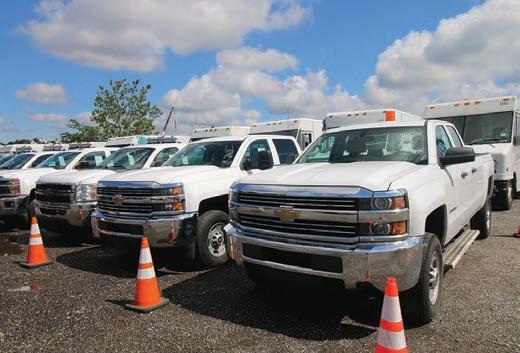

disengagement during train derailment, and thereby minimizing the potential for tank car shell puncture.”
All new and rebuilt freight cars must be equipped with couplers with a bottom shelf as a minimum requirement, according to McConway & Torley. The bottom shelf serves to “support a mating coupler suffering a pull-out from the car sill. This keeps it from falling to the roadbed and presenting a derailment hazard.” The shelf, the company says, also serves to “prevent vertical coupler disengagement during derailment, as related to the mating coupler.” The bottom shelf is effective when the 10-A contours of the mating couplers are within AARspecified condemning limits.
All hazardous material tank car couplers require top and bottom shelves. Their purpose, the company says, is to “prevent vertical coupler
McConway & Torley notes its H-Type “Tight-Lock” coupler constitutes the “standard coupler for North American passenger equipment. All-important engaging surfaces are machine finished to closely control dimensional

48 Railway Age // March 2023 railwayage.com
includes cushioning
PHILADELPHIA 800.969.6200 DENVER 800.713.2677 For More Information Visit: DANELLA.COM/JJ-KANE-AUCTION TRUCKS, BACKHOES, CRANES, AND MORE ONLINE STARTING JUNE 6 35TH ANNUAL AUCTION DANELLA.COM/RENTALS The live auction event will take place with with timed online bidding only. Bidding will be available through Proxibid starting on Wednesday, June 1, 2022. Lots will start closing on Tuesday, June 13, 2023 at 9:00 AM ET. NOTICE: Everything will be sold absolute to the highest bidder regardless of price. Everything will be sold "As-Is" and "Where-Is" with no warranties or guarantees expressed or implied.
Railinc’s Component Tracking program now
devices.
tolerances, resulting in secure positive locking, which eliminates any play, or slack, between mating surfaces.” The H-Type coupler body and components are supplied in either AAR M201 Grade E, or Grade C steel. The coupler lock is only supplied in Grade E.


Casting, machining and assembly of the H-Type are done in McConway & Torley’s AAR-approved Pittsburgh foundry. The in-house capabilities and expertise allow the company to have “the largest buy-America compliant coupler capacity in the world.” Purchase and acceptance of H Couplers is governed by the APTA-RP-M-003-98 Specification, which references the following AAR and FRA requirements:
• AAR M201 General for Steel Castings.
• AAR M211 Purchase and Acceptance of AAR Approved Couplers and Coupler Yokes for Freight Service.
• AAR M-1003 Specification for
Technology Focus – Mechanical
Quality Assurance.
• AAR M205 Yoke, Coupler–Test Requirements.
• FRA CFR Title 49 Part 238 Passenger Equipment Safety Standards.
RAILINC
Improved visibility for the location and condition of key railcar components has resulted from the Component Tracking program, administered by Railinc for all North American freight rail equipment, Railinc Product Manager Clayton Miller tells Railway Age.
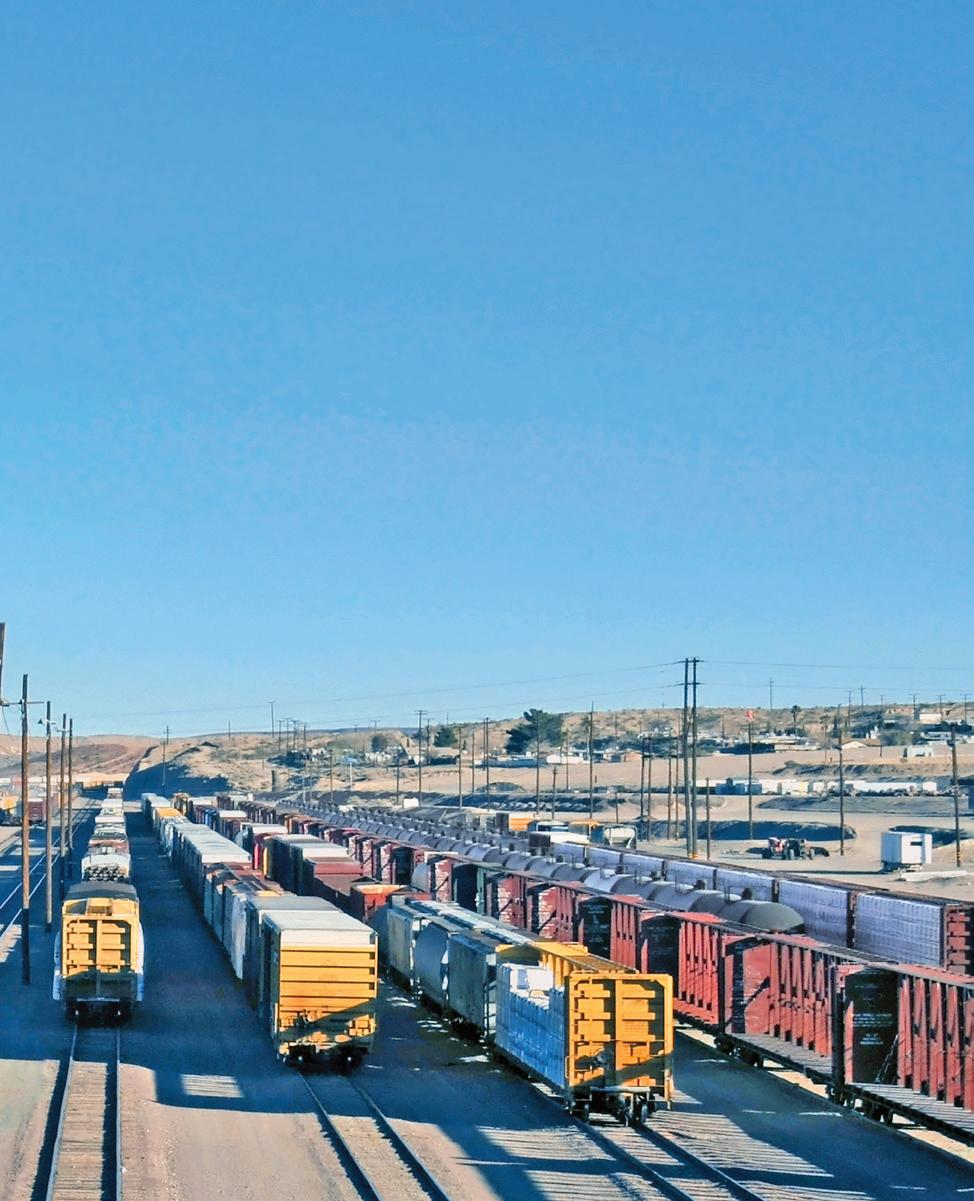
“Couplers have been included in Component Tracking for some time, and the program was opened to cushioning devices in 2021,” Miller says. “Cushioning devices help prevent hard coupling during switching for cars that carry particularly heavy or sensitive loads. To date, some two million couplers and 100,000 cushioning devices have been associated and
registered in the Component Tracking program. Other components in the program include slack adjusters, brake valve control systems, side frames, bolsters, wheelsets, side frames and pressure relief valves.
“In addition to improving the management and maintenance planning for railcar components, a significant benefit is that component recalls can be accomplished much more efficiently and quickly than was previously the case. Rather than having to pull many cars from service to find specific component types for a recall, only the cars that have the specific targeted components need be included in a recall.”
Including cushioning devices in the tracking program “will also help prevent damage to equipment and shipments by enabling car owners to schedule maintenance and repairs before equipment failures occur in the field,” Miller notes.
March 2023 // Railway Age 49 railwayage.com
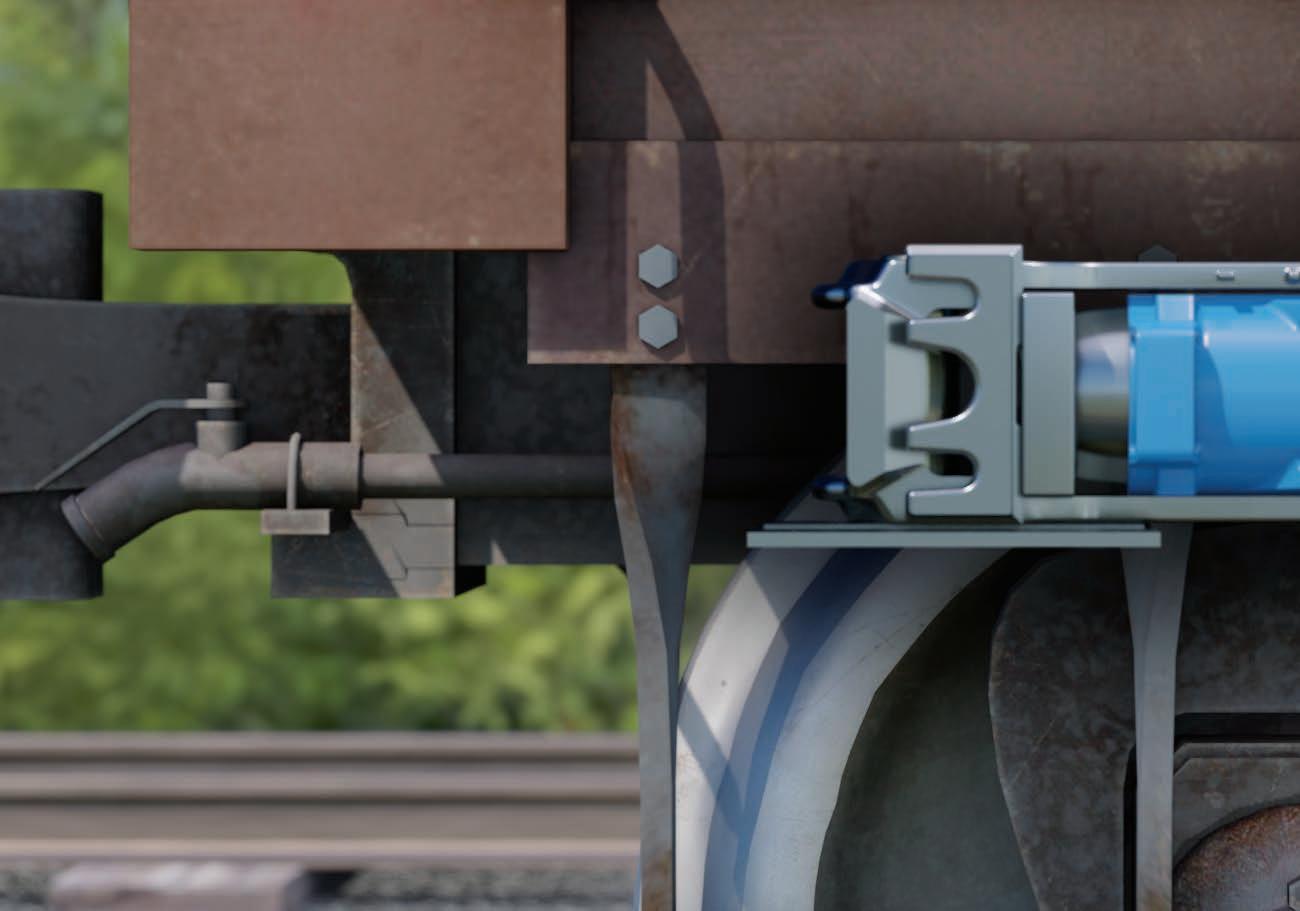

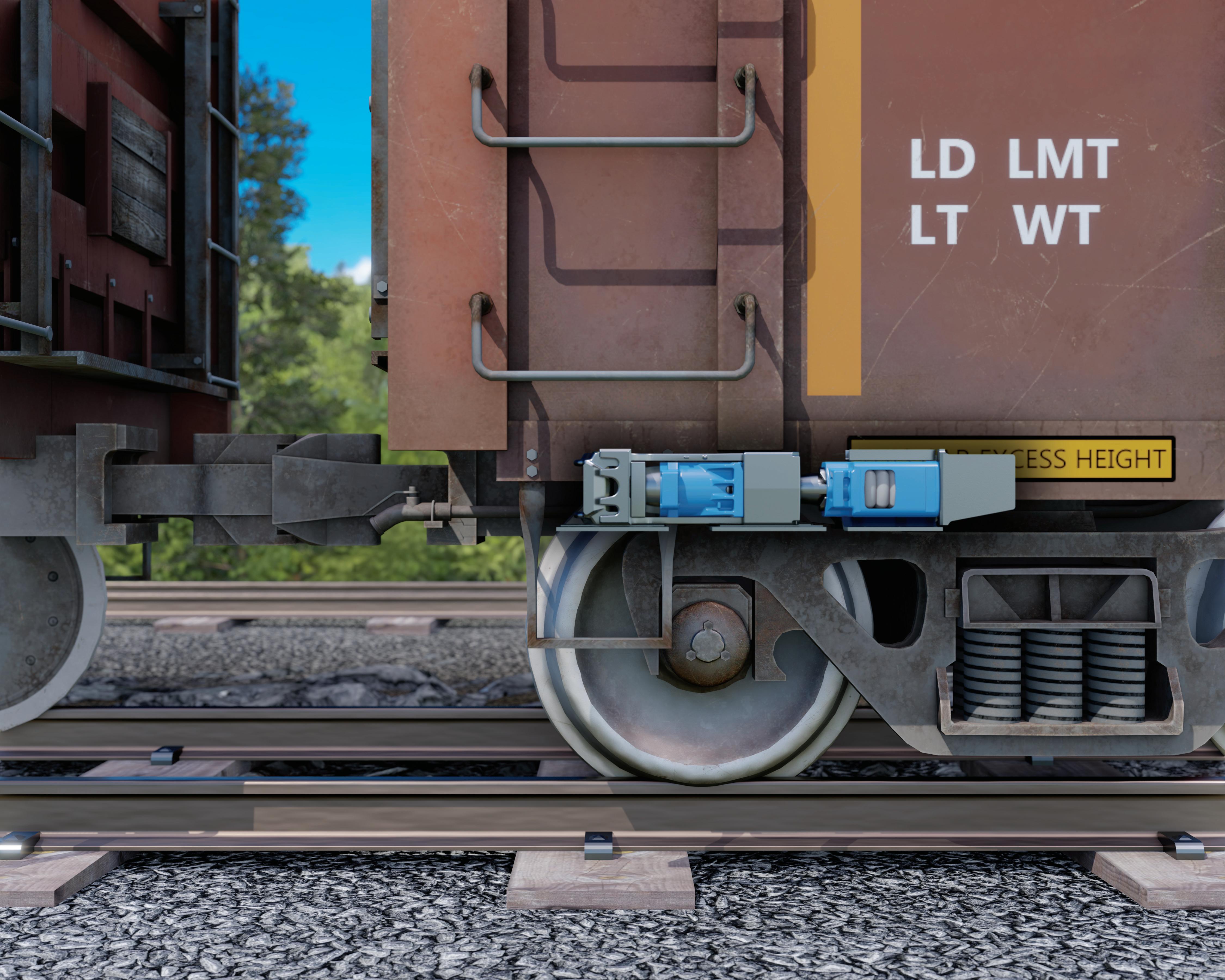
GROWING NETWORK A VARIED,
Rail transit in Northern California is on the rise.

Last month, we featured the rapidly growing rail scene in Southern California, centered on Los Angeles. It is truly a transit renaissance, as rail transit went from non-existent to almost
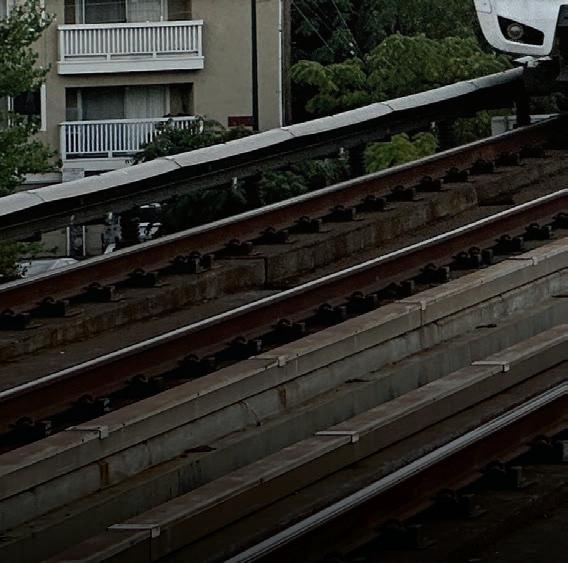 BY DAVID PETER ALAN, CONTRIBUTING EDITOR BART
BY DAVID PETER ALAN, CONTRIBUTING EDITOR BART
pervasive, and is still growing, over the short span of 33 years. at region and Northern California, centered on San Francisco, have historically been rivals in many ways, and they are culturally very di erent. Still, both regions have something important in
common: Rail transit is alive and well, and on the rise in both.
Unlike the southern part of the state, Northern California has always had some rail transit. e historic cable cars have provided a unique experience in San

52 Railway Age // March 2023 railwayage.com passenger rail focus
Francisco for nearly 150 years. e city is also only one of seven in the U.S. that never lost its streetcars, and they still run today.
“Commuter rail” was never a big player there—only one line, but it goes back to the time of the American Civil War.



PASSENGER RAIL FOCUS
historic streetcars and the unique cable cars. Bay Area Rapid Transit (BART) runs not only conventional subway/elevated cars, but also two other modes that have recently been added. ere are regional trains on Caltrain, and Sonoma-Marin Area Rail Transit (SMART) north of the Bay. ere is also light rail in San José, at the south end of Caltrain, and in the state capital of Sacramento. San Francisco also has ferries going across the Bay, as well as trolley buses (also known as “trackless trolleys” or “trolley coaches”) that have a double pole for contacting two overhead wires. e latter two modes do not run on rails, but they are unusual in the U.S., and add to the region’s variety of transit modes.
Before COVID-19 struck, Muni operated six light rail lines, two lines with historic streetcars, and three cable car lines, in addition to its buses. During the three years since the virus struck, we have reported to you about how rail transit in the U.S. and Canada, Amtrak, and VIA Rail in Canada have fared. Of all the cities with major transit systems, San Francisco (along with the rest of the Bay Area) was among the hardest hit. e historic streetcars and cable cars were out of service for a while, and several light rail lines were replaced by buses. e bus network shrank from 89 routes to 17, and some city locations were a mile from the nearest bus stop. e bus network is back to 47 routes (12 of which run through the night as “owl service”), and rail is coming back, too.
Today, rail transit in the region exhibits a greater variety of modes than anywhere else in the nation. e San Francisco Municipal Transportation Agency (Muni), which started as the San Francisco Municipal Railway in 1912, has modern light rail,
e hours of service and headways during the service day have not recovered to the pre-COVID levels of three years ago, but the cable car lines are back. Light rail is back on ve of the six lines (the J Church, K Ingleside, M Ocean View, N Judah, and T ird Street), but not on the L Taraval, where an improvement project is under way. Historic streetcars are back on Market Street (the F Line), but not the E Line along the Embarcadero. Most of the cars in service are Presidents’ Conference Committee (PCC) cars, a design popular from the 1930s through the early 1950s. Most of those cars previously saw service on SEPTA in Philadelphia or in the Twin Cities and later on New Jersey Transit in Newark. ey are painted in the colors of many systems, including several historic San Francisco liveries. ere are

March 2023 // Railway Age 53 railwayage.com
passenger rail focus
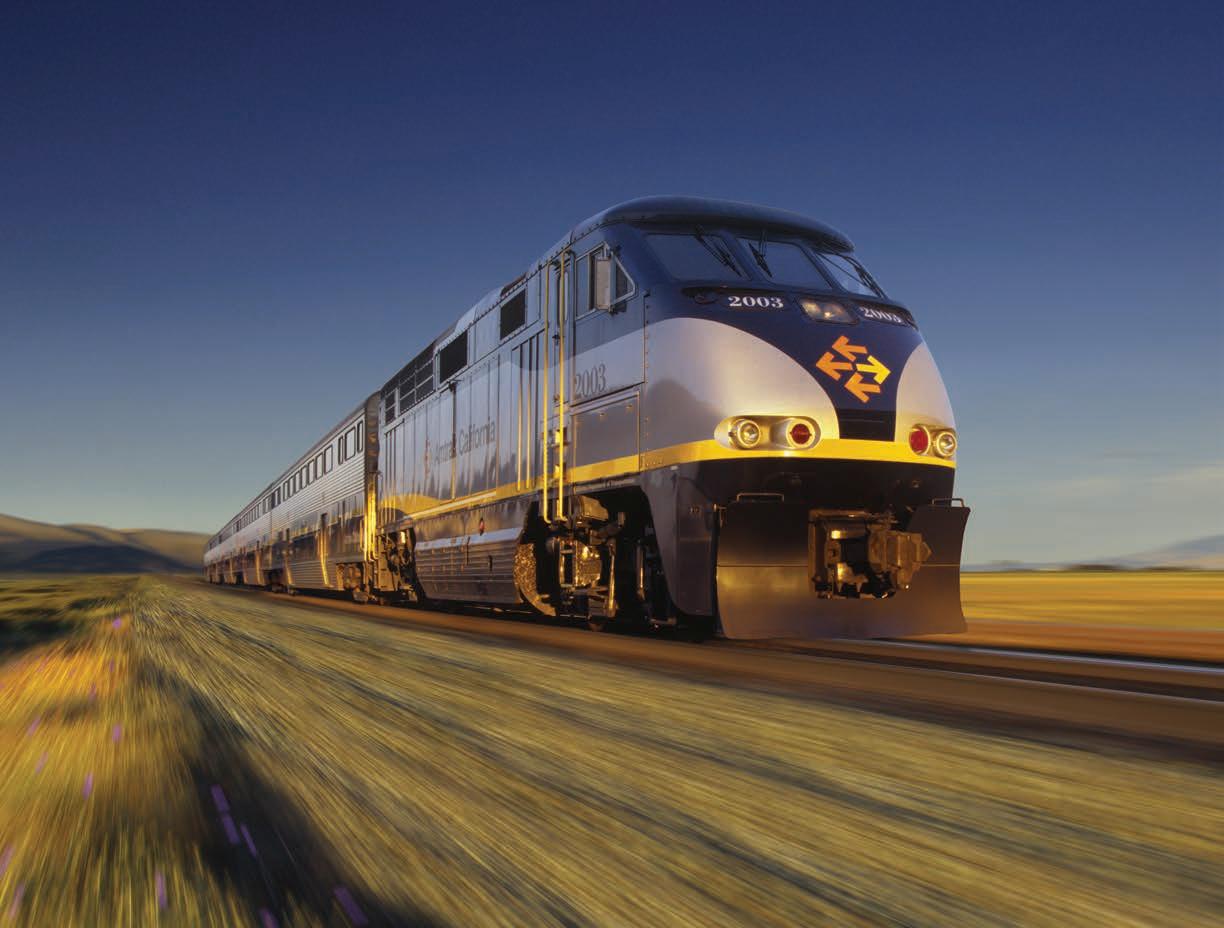
also several Peter Witt-style “Milano” cars, which originally ran in Milan, Italy, starting in the late 1920s. A few cars are even older and come from such cities as New Orleans, La.; Melbourne, Australia; and Blackpool, England, as well as San Francisco itself. e oldest is Car #1, which began service on the original Muni system, when it consolidated the existing private companies in 1912. According to Muni, only the PCC and Milano cars are running at the present time. Although public ownership of local transit systems is common today, San Francisco was a pioneer in implementing that model.
New York has its subways and “el” trains in the Outer Boroughs, Chicago has its own “L” lines, and San Francisco and the cities and towns in the East Bay have BART. BART opened for service in 1972. Like other systems from that era, Metrorail in the Washington, D.C., area and MARTA in Atlanta, Ga., trains stop frequently in and near downtown San Francisco and Oakland, while stops are further apart in
suburban towns. ere are ve lines that use di erent combinations of routes that radiate outward from the center of the system in San Francisco and Oakland.
Oakland has been considered San Francisco’s Brooklyn, with its diverse population, historic downtown (Old Oakland is a collection of o ce buildings from the late 19th century), and a Chinatown almost as lively as San Francisco’s. Further northwest are the towns of Berkeley, home of the University of California, and Richmond, with many reminders of World War II history and a new ferry line to San Francisco. e newest segment of BART is at the southeasterly end of the system, beyond Fremont to Milpitas and Berryessa.
ere are also plans to build a deep-tunnel extension further into San José. at city’s Valley Transit Authority (VTA) is building it for BART.
Much of BART looks like an elevated or surface railroad, but with broad gauge and third-rail power. ere are also underground sections in San Francisco and
Oakland, and under the Bay in between. It is notable that Market Street has rail transit running on three levels: historic streetcars on the surface, Muni light rail below it, and BART on a deeper level underground. It is also notable that BART has two other types of operation, in addition to the conventional “Metro” style. On the southeasterly part of the line, south of Oakland, there is a xedguideway shuttle between Coliseum Station and Oakland International Airport (OIA). BART calls it the Beige Line (the other lines are color-coded Red, Orange, Yellow, Blue and Green). It is cable-drawn, in a way, the descendant of the historic cable cars.
On the northeasterly line, there is a new extension called “e-BART” extending past Pittsburg/Bay Point, where the Yellow Line used to end. Now, there is a transfer platform further east, where a connection is available for a standard gauge diesel multiple-unit (DMU) that goes two stops further, to Antioch.
Heading south from San Francisco is Caltrain, a regional/commuter line, the
54 Railway Age // March 2023 railwayage.com
Capitol Corridor
only one in the region. e line stretches down the peninsula for 46.75 miles to San José, through such towns as San Mateo; Santa Clara; and Palo Alto, the home of Stanford University. A few commuter-peak trains continue further south to Gilroy, a town famous for growing garlic. e service began in 1863 under the San Francisco & San José Railroad, which became part of the Southern Paci c, and the route eventually settled into becoming the Peninsula Commuter service. It has experienced nancial troubles through the years, most notably when COVID-19 caused ridership to plummet. Ridership remains far below pre-COVID levels, but governmental bodies have kept service going.
e California Department of Transportation (Caltrans) became involved with the operation in the 1980s: subsidizing it, naming it Caltrain, and forming the Peninsula Corridor Joint Powers Board to manage it. In the wake of the dwindling ridership a er the virus struck, the counties along the line instituted a special tax to keep it going, a measure that received the two-thirds vote necessary in California. e line is now being electried between San Francisco and San José in conjunction with the California High-Speed Rail Authority (CHSRA) project. Local trains take approximately 1 hour and 45 minutes end to end and run hourly for most of the service day on weekends. On weekdays, there are also “limited” trains that skip some stops. During peak-commuting times, there are also “Baby Bullet” trains that make the trip between San Francisco and Diridon Station in San José in 65 minutes.
San José has light rail too. VTA operates the system, which consists of three lines, color-coded Green, Blue and Orange. Each line takes about one hour for a one-way trip, end to end. Service began at the end of 1987, and the system reached its current length of 42.2 miles in 2005. VTA connects with Caltrain in four places: Mountain View; Great America; Tamien Station (the terminal for most service); and Diridon Station, the main station in town, which also hosts the Altamont Corridor Express (ACE), and Amtrak’s Capitol Corridor line to Sacramento (which uses Union Paci c right-ofway) and Coast Starlight long-distance train.
VTA has seen some hard times, especially as Silicon Valley’s fortunes began to ebb. e system’s ridership is low, and it
no longer operates all night. A three-stop shuttle to Almaden was discontinued and replaced by a bus route in 2019. Sadly, a May 2021 mass shooting at the Guadalupe Yard took 10 lives. Still, VTA keeps going and does its part to provide mobility in the area.

e ACE is the smallest player in providing service in Northern California’s rail scene. It runs from Stockton (on Amtrak’s San Joaquin line) on Union Paci c rightof-way into San José four times on weekday mornings and back in the late a ernoon and early evening, living up to its former name, the Altamont Commuter Express. Service began in 1998 on Union Paci c’s former Southern Paci c and Western Paci c subdivisions through scenic Altamont Pass and Niles Canyon. It takes 2:12 to traverse the 86-mile route with 10 stations. ere was never service outside peak commuting periods, except for a mid-day train that ran from 2006 to 2009, and two Saturday round trips that started Sept. 7, 2019, but became casualties of reduced ridership a er the COVID-19 virus struck.
Amtrak’s Capitol Corridor connects BART, ACE, Caltrain and other Amtrak routes. It is operated by the Capitol Corridor Joint Powers Authority, in conjunction with Amtrak and Caltrans. It runs for 123 miles between Sacramento and San José, through Oakland and Amtrak’s main station at Emeryville. One round trip runs 35 miles further east to Auburn. e line began service in 1991, and runs with bi-level California Cars. Amtrak’s Coast Starlight runs
along the route, while the California Zephyr runs along part of it, east from Emeryville. Service was cut to ve round trips per day due to COVID-19, but is recovering. ere are plans to extend the line south to Salinas, a stop on the Starlight and home of famous writer John Steinbeck.
Sacramento, the terminal for most trains and the state capital, also has light rail.
e Sacramento Regional Transit District (SacRT) runs two full-service lines on a 42.9-mile system that started service in 1987. e Blue Line runs northeast and southeast of the city, looping through downtown, near the state capital. e Gold Line originates at Sacramento Valley Station, the headhouse for the main train station (although the tracks and platforms are now a sizable walk from there), eastward to historic Folsom. ere is also the Green Line, a weekday short line from 7th Street in the River District through downtown. ere have been plans to extend it to the airport, but the money has not become available.
ere is also a proposed line in the planning stage that would host commuter trains north of Sacramento. North Valley Rail, proposed by the Butte County Association of Governments, in conjunction with the San Joaquin Regional Rail Commission, would stop north of Natomas at Plumas Lake and Marysville/Yuba City. It would either continue to Gridley and Chico, or use an alternative route to Oroville. Plans call for two daily round trips in 2028, with two more in 2030.
March 2023 // Railway Age 55 railwayage.com
PASSENGER RAIL FOCUS
Muni
TIMEOUT FOR TECH
ANTHROPOMORPHIC MATERIALS CHARACTERISTICS
Stress, Strain, Strength, Fatigue, Toughness
By Gary T. Fry, Ph.D., P.E., Vice President, Fry Technical Services, Inc.
Welcome to “Timeout for Tech with Gary T. Fry, Ph.D., P.E.” Each month, we examine a technology topic that professionals in the railway industry have asked to learn more about. is month, our subject is properties of engineering materials.
Figure 1 (above) is a photograph of a portion of an 1895 bas-relief by Karl Bitters displayed in Philadelphia’s 30th Street Station: “ e Spirit of Transportation.” ere are several interesting connections between the work of artists and the work of engineers. For example, artists use materials to represent aspects of the human experience; engineers use the human experience to represent aspects of materials—stress, strain, strength, fatigue and toughness, to

name a few. I am o en asked about the engineering meanings of these terms.
Let’s start with stress and strain. Figure 2 (opposite, top) shows drawings of a beam that is supported by blocks at each end. In Figure 2-a, the beam is not loaded. In Figure 2-b, the beam bends under a load applied at its center, and its supports also deform. e bend in the beam and deformation of its supports are measurable on a global scale. Less obvious is what happens inside the materials used to make the beam and its supports—internal forces and internal deformations. One should imagine these two e ects occurring at the atomic scale; atomic lattices of materials deform as interatomic bonds work to resist these internal forces. is is generally where the engineering concepts of stress and strain apply—within materials at an in nitesimal scale. Consequently, stress and strain are
characteristics of materials—stress, strain, strength, fatigue and toughness.
(Courtesy of Gary T. Fry.)
termed di erential quantities.
Speci cally, stress is the term we use to describe the intensities of internal forces that are distributed throughout materials under load. Stress has units of pressure, for example pounds per square inch (psi). Strain is the term we use to describe the intensities of internal deformations that are distributed throughout materials under load. Strain is mathematically (but not conceptually) dimensionless with units of deformation over length, for example inches per inch (in./in.). e state of stress at a given point in a material is represented as a 3x3 symmetric matrix of values called a tensor.
e state of strain at a material point is also a 3x3 symmetric tensor. Stress and strain occur together and are related to one another through material-speci c functions called constitutive equations. (Hooke’s Law is an example of
56 Railway Age // March 2023 railwayage.com
Figure 1. From “The Spirit of Transportation,” an 1895 bas-relief by Karl Bitters displayed in Philadelphia’s 30th Street Station. In engineering, it is common to use terms associated with the human experience to describe
a simple constitutive equation, and its uniaxial expression is familiar to most engineers.)
We are now ready to introduce the concept of material strength. e strength of a material is usually de ned simply as the maximum stress that can be applied to the material before the material fails. erefore, strength has the same units as stress—for example, psi. To establish its strength, controlled tests are performed on samples of a material. Figure 3 (right) is a drawing of a standard “tensile test” specimen used to establish the strength of ductile metals.
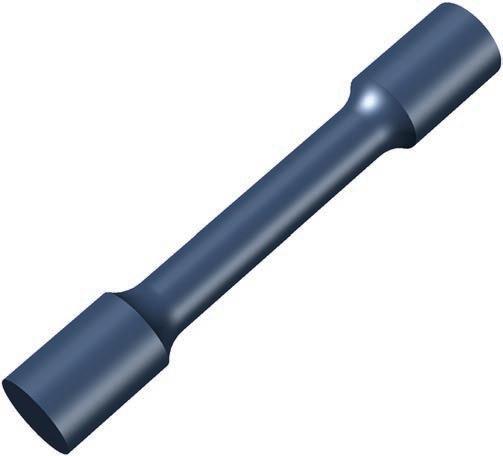
e specimen is usually ve inches long and half an inch in diameter along its midsection. In this test, the ends of the specimen are gripped and pulled by a machine until the specimen breaks in two. e load applied to the specimen and the elongation of the specimen are recorded continuously during the test. A er the test is complete, the load and elongation data sets are used to calculate the strength of the material.
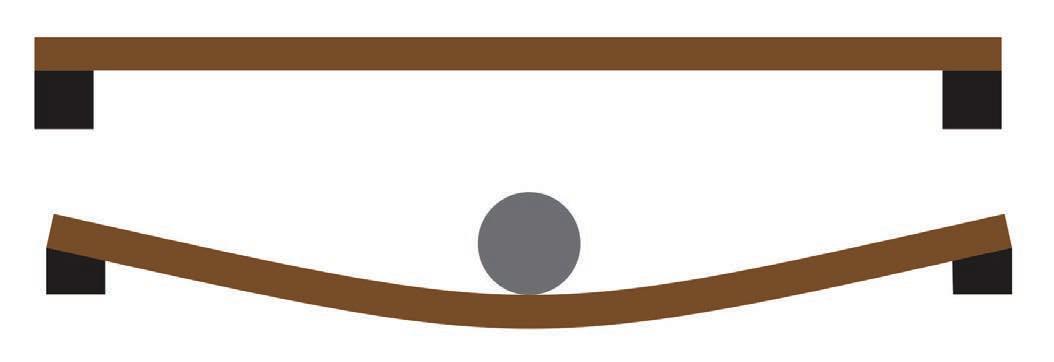
e concepts of stress and strength work hand in hand and are essential to ensuring the safety of our built environment. In designing and evaluating a component for safe use, engineers rely on calculations of stresses in the component and speci cations for the strengths of the materials that comprise the component.
e objective is for the strengths of the materials to exceed the stresses in the materials by reliably and statistically signi cant margins.
Here it is worth noting that given the fundamental concept of stress (and, by association, strength), it is only possible to determine stresses and strengths through calculations using mathematical models of materials and components. It is never possible to measure stresses in any material by any means either
directly or indirectly. During my early studies in solid mechanics, I was told quite emphatically by an eminent scholar that anyone who claims that stress can be measured “is at best ignorant but more likely incompetent and a threat to safety.”
Despite the facts of the situation, the internet is full of references to means of “measuring stress” in engineering materials. One must take care interpreting these claims. ere is a eld called experimental stress analysis, and I frequently evaluate components in service using its tenets. e work involves attaching sensors—o entimes strain gages—to existing components and subjecting them to loadings
consistent with their intended service. e data sets from the sensors feed into models of the components and their constituent materials.
Using those models, and data from the sensors, estimates for the component stresses can be calculated. All else being equal, however, di erent models can lead to substantially di erent calculated stresses, even when using the same sensor data as input. In situations involving high levels of stress, such as wheel/rail contact, the stress calculations can be very complex involving iterative nonlinear computer algorithms and multiscale material models.
In summary, stresses in materials can only
March 2023 // Railway Age 57 railwayage.com TIMEOUT FOR TECH
Figure 2. Drawing of a beam supported on blocks: (a) unloaded (top) and (B) loaded (bottom). (Courtesy of Gary T. Fry.)
Figure 3. Standard ASTM tensile strength specimen for ductile metals. (Courtesy of Gary T. Fry.)
be estimated using mathematical models, and the calculations may or may not incorporate sensor data from components under load. Regardless, the act of incorporating sensor data with a calculation of stress does not transform the result into a measurement of stress. Claiming otherwise is a misrepresentation with potential safety and/or economic implications.
Our next term is fatigue. Fatigue is de ned generally as the process that leads to the formation of cracks (or other defects) in sound material a er the application of many cycles of loading. When stresses at a certain magnitude or higher are applied to steel, natural atomicscale imperfections move, or glide, until they reach a surface—for example the peripheries of metallurgical discontinuities or of the members themselves. ere they cease movement, but the geometry of the atomic lattice has now changed permanently. Atomically sharp steps are formed at the free surfaces, and the process is not reversible. With the repeated application of stresses, such as wheels rolling over a rail, more dislocations move, and more sharp steps are formed. With the accumulation of more stress cycles, the iron crystals eventually separate at the steps forming fatigue cracks. As more stress cycles are applied, the fatigue cracks grow, potentially leading to complete fracture of a component.
Our last term is toughness. Toughness is a measure of a material’s resistance to allowing a crack to grow longer under the application of stress. It has units of energy per unit area of crack formed. All solid materials have toughness. e toughness of metals usually varies with temperature: generally lower at cold temperatures and
higher at warm temperatures. Figure 4 (above) is a photograph of a test specimen used to establish toughness values for steel. e specimen includes a sharp, machined notch. e test is conducted in two stages. First, the specimen is subjected to a cyclic load to initiate and grow a fatigue crack from the notch. en, the specimen is subjected to an increasing load until the specimen fractures. Several specimens from a given material are tested at di erent temperatures to establish the sensitivity of the material to cracks over its expected range of operating temperatures. Data sets recorded during each test are used to calculate a quantity called Fracture Toughness, which is directly related to Material Toughness but re ects the relationship among Material Toughness, applied stress and fatigue crack size.

In general, the larger the value of Fracture Toughness, the larger the fatigue crack that can be tolerated before triggering a fracture. Hence, higher fracture toughness gives us a better chance of detecting the crack before it causes failure. It is worth noting here that a crack tolerated on a warm summer day, when the Fracture Toughness is high, might well trigger a brittle fracture on a cold winter day, when the Fracture Toughness is low. e only di erence being the value of Fracture Toughness in the material; the crack size and stress level remain identical. Inspection protocols must take this temperature dependence into account to be fully e ective.
Stress, strain, strength, fatigue and toughness are familiar concepts in the daily lives of people all over the world. But these words take on special meaning as essential properties of structural materials. Each has a critical
in uence on the safety and reliability of every engineered system in our built environment.
Dr. Fry is the Vice President of Fry Technical Services, Inc. (https://www.frytechservices.com/). He has 30 years of experience in research and consulting on the fatigue and fracture behavior of structural metals and weldments. His research results have been incorporated into international codes of practice used in the design of structural components and systems including structural welds, railway and highway bridges, and high-rise commercial buildings in seismic risk zones. He has extensive experience performing in situ testing of railway bridges under live loading of trains, including highspeed passenger trains and heavy-axle-load freight trains. His research, publications, and consulting have advanced the state of the art in structural health monitoring and structural impairment detection.

58 Railway Age // March 2023 railwayage.com TIMEOUT FOR TECH
Figure 4. Standard ASTM fracture toughness specimen for metals. (Courtesy of Gary T. Fry.)
WHEEL/RAIL FRICTION RCFS TESTING
By Ananyo Banerjee, Ph.D., Principal Investigator; Yuqing Zeng, Principal Investigator; Daniel Thielemier, Senior Engineer; and Xinggao Shu, Principal Investigator, MxV Rail
MxV Rail (formerly TTCI) conducted a series of full-scale wheel/rail (W/R) rolling contact tests using its Rolling Contact Fatigue Simulator (RCFS)(1) to investigate the effects of lubricating media (water and solid lubricant) on rolling contact fatigue (RCF) and wear with controlled traction ratios.
The RCFS has the unique ability to perform lubrication studies with fullscale, W/R, rolling contact that permits the observation of surface damage along the entire surface of the rail head and a portion of the wheel tread surface. The simulator also allows the study of the use of lubricants in controlled amounts during actual W/R interaction, which is usually difficult to control precisely on
tracks in revenue service due to wayside lubricating systems.
In this study, the RCF tests were conducted using a wheelset with newly trued Class C wheels running on a 10-inch-long test zone on the top of the rails with a nominal 36,000 pounds-force (36 kips) vertical load and 15-mrad angle of attack (AOA), resulting in an approximate 18-kip lateral contact force under dry conditions.(2) Two sets of intermediate strength rails were used: new rails and rails with pre-existing RCF from an earlier test.
e 10-inch test zone was conditioned into two di erent levels of friction: a dry surface condition with no lubricant in the rst half of the rail and a wet surface condition with water applied between the center and the end of the rail (Figure 1, above).


During testing with a commercial solid lubricant, the dry, unlubricated contact zone had a traction ratio of 0.40 to 0.50, and the lubricated zone had a controlled traction ratio of about 0.20 to 0.25. e same wheelset was used for all tests, but rotated to expose an unworn portion of the tread for each additional test condition.
For the used rail with pre-existing cracks, the typical mean crack depth observed on the gage side of the rail in the solid lubricant zone was approximately one-third less than the mean crack depth on the same side of the rail in the dry, unlubricated contact zone. This trend showed opposite results from the tests using water lubrication where the cracks tended to be deeper and two to three times longer than the cracks in the dry contact zone.
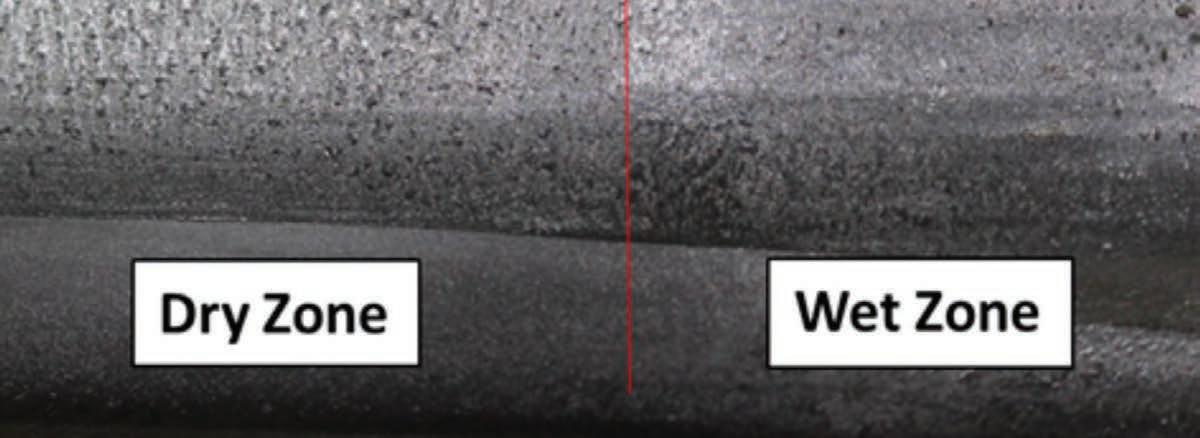
March 2023 // Railway Age 59 railwayage.com MxV Rail
MxV RAIL R&D
Figure 1. Dry and wet test zones with water applied on rail near the right side of the center.
In the two series of tests performed with either water or solid lubricant, it appeared that the solid lubricant may have helped slow down the crack growth in the used rail, while water accelerated the crack growth in the used rail. There was a difference between the two application mechanisms. For the tests done with water, the water was applied directly on half of the rail as shown in Figure 1 (p. 59). For the tests with solid lubricant, the lubricant was applied to the wheel tread above the dry section, as shown in Figure 2 (above).
In both cases where lubricant was used, the lubrication slowed the wear rate leading to more time for the surface

rail cracks to experience more wheel loads before wearing away. Due to the effect of water and solid lubricants, W/R wear decreased by 50% to 70% compared to dry contact conditions. Competing mechanisms of rail wear and fatigue crack growth, which are also influenced by a variety of factors including rail metallurgy and lubricant/crack interaction, can be observed from the wear analysis and estimation of crack lengths.
The underlying mechanisms of RCF initiation and propagation and the influence of lubricants on wear and crack growth need to be investigated further. This research was funded jointly by the
Federal Railroad Administration (FRA) and the Association of American Railroads (AAR) Strategic Research Initiatives (SRI) program.
REFERENCES
1. Cakdi, S. and H. Tournay, June 2017, “Modeling of Low Rail & Wheel Rolling Contact Stresses,” Technology Digest TD17-014, AAR/TTCI, Pueblo, Colo.
2. Banerjee A., Y. Zeng, D. Thielemier, U. Spangenburg, and X. Shu, April 2022, “Investigation of Wheel-Rail Rolling Contact Fatigue Using Lubricating Media,” Technology Digest TD22-001, AAR/TTCI, Pueblo, Colo.
60 Railway Age // March 2023 railwayage.com MxV RAIL R&D
Figure 2. RCF tests with solid lubricant applied on the wheel.
MxV Rail
RICHARD SHERMAN ASLRRA
HIGH PROFILE: Richard Sherman has joined the American Short Line and Regional Railroad Association (ASLRRA) as Assistant Vice President of Policy and Industry A airs. He will support the association’s e orts in a range of policy areas, with a particular focus on capital projects, infrastructure funding programs and agency procedures.
Sherman served previously at Blank Rome Government Relations and Chambers, Conlon & Hartwell, where he supported a range of transportation clients including ASLRRA. He has helped clients secure more than $200 million in grant funding over 19 separate awards in the rail, maritime and highway sectors; supported overseas railroad consultancy projects and performed work for national governments and multilateral non-governmental organizations; and led several U.S. Trade and Development Agency project preparation missions in the railway sector, including in North Africa, Central Asia and Latin America. Sherman also served with the U.S. Army in Iraq during Operation Iraqi Freedom.
CRAIG CIPRIANO STV
HIGH PROFILE: Craig Cipriano has joined STV as Senior Vice President and National Director of Zero Emissions Mobility. In this newly created role, he will advise STV clients on practical solutions and strategies to “deliver sustainable, equitable, carbon-free transportation systems,” the rm said.

Cipriano brings more than 33 years of experience planning and executing large-scale, multidimensional eet and infrastructure programs for public transit systems. Prior to joining STV, he served as President of New York MTA’s Bus Company, leading the nation’s largest bus transit agency through the pandemic and setting its strategy to a zero emissions eet by 2040. He also served as acting President of New York City Transit (NYCT), leading 50,000 employees at the largest public transportation agency in North America with an operating budget of $13 billion. Cipriano earned a Bachelor of Engineering degree in Mechanical Engineering from Stony Brook University and a Master of City and Regional Planning degree from Rutgers University.
“STV is proud to welcome a national thought leader of Cipriano’s caliber to lead the Zero Emissions Transformation national advisory practice within our Centers of Excellence,” said STV Executive Vice President Marcos Diaz Gonzalez. “Combining Cipriano’s vast and distinguished experience in eet operations with our industry-leading national practices will help advance our clients’ decarbonization and eet transformation goals through our strategic and equitable approach to zero emissions mobility.”

“Decarbonizing our transportation systems is a top societal challenge of our time,” said Cipriano. “I have seen both the technical complexity and organizational change management necessary to deliver an equitable, resilient, zero emissions fleet transformation, and I am eager to provide that perspective to STV’s deep bench of industry expertise.”
Wabtec Corp. last month named Pascal Schweitzer (selected by Railway Age readers as one of 10 Influential Leaders for 2022), Lilian Leroux and Alicia Hammersmith (a 2022 Railway Age Women in Rail honoree) to new senior leadership positions, effective April 3. Schweitzer will become President of Wabtec Transit, succeeding Lilian Leroux. He will be responsible for the strategy and execution of Wabtec’s portfolio of transit products and services. Currently, Schweitzer leads the Global Freight Services business. A native of France, he will be relocating to Paris. L eroux will transition into the role of Chief Strategy and Sustainability Officer, responsible for leading the company’s strategy, sustainability initiatives and business development efforts. A licia Hammersmith will become President of Global Freight Services, succeeding Schweitzer. She will oversee Wabtec’s services, upgrades and modernization programs. Previously, Hammersmith led operations for Wabtec North America and, currently serves as Vice President of Operations, Transit. “ These leadership moves are all part of our growth and ability to sustainably execute,” said Rafael Santana, Wabtec’s President and CEO, to whom each of the three executives will report. “They are evidence of our commitment to resiliency and continuous improvement. But mostly, they are proof that our shared relentless momentum will allow us to work together to change the world for the better.”
David Buccolo, former General Manager of the Central California Traction Company and Hazmat Instructor with the Short Line Safety Institute (SLSI) died Feb. 15 after a brief battle with cancer. Buccolo was an integral part of the SLSI, first serving as an assessor and later as a principal author of the grant proposal that helps fund SLSI’s hazardous materials (hazmat) training program, the American Short Line and Regional Railroad Association (ASLRRA) said. He was also a trainer in that program, and was responsible for moving the SLSI Safety Train to various events. Additionally, Buccolo served on ASLRRA’s Safety and Training Committee and was Committee Chair from 2000 to 2002.
March 2023 // Railway Age 61 railwayage.com PEOPLE







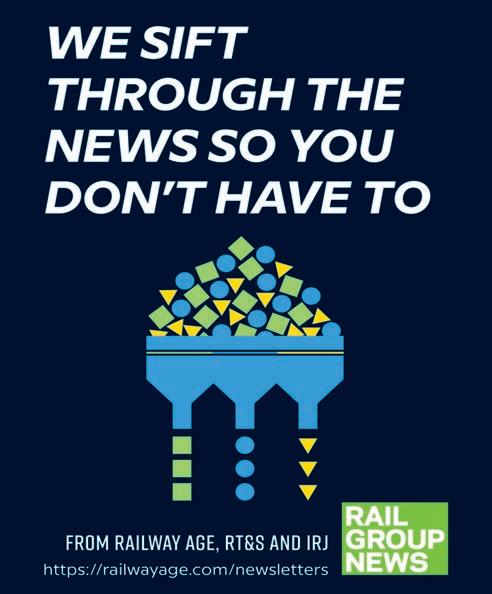



62 Railway Age // March 2023 railwayage.com RECRUITMENT Edna A Rice Executive Recruiters SPECIALISTS IN RAIL AND TRANSPORTATION RECRUITING SINCE 1988 713-667-0406 www.ednarice.com LEARN MORE Engineering News: The Weekly RT&S Email Newsletter SUBSCRIBE AT: www.rtands.com/engineeringnews Get The Inside Scoop ON AND OFF THE TRACK RTS_QuarterAd.indd 1 11/30/22 11:09 AM

March 2023 // Railway Age 63 railwayage.com Ad Index The Advertisers Index is an editorial feature maintained for the convenience of readers. It is not part of the advertiser contract and Railway Age assumes no responsibility for the correctness. COMPANY PHONE # URL/EMAIL ADDRESS PAGE #
IN GEAR
RAIL
NEWS RAIL GROUP NEWS brings you a daily round-up of news stories from Railway Age, RT&S, and IRJ. This email newsletter offers North American and global news and analysis of the freight and passenger markets. From developments in rail technology, operations, and strategic planning to legislative issues and engineering news, we’ve got you covered. ROUND-UP of NEWS R AILWA RAIL GROUP NEWS From Railway Age, RT&S and IRJ https://railwayage.com/newsletters RA_RailGroupNews_Third_InGear_2022.indd 1 1/26/22 1:25 PM 312-922-4516 212-461-5781 561-743- 7373 737-471-6466 630-232-3000 904-423-2540 570-883-7005 265-505-6402 708-844-5501 402-346-4300 732-317-5406 721-443-8881 800-631-4420 773-254-9600 630-679-9927 kskibinski@amstedrail.com James.Spencer@cit.com SBolte@danella.com Jenny.bowen@marmonrail.com sales@minerent.com info@patriotrail.com Sales@PowerRail.com info@progressrail.com msells@railheadcorp.com bbrundige@sb-reb.com korozco@stratoinc.com cynthia.ruddy@trainyardtech.com trinityrail.com jm@wch.com hannah.tadey@wi-tronix.com 45 C4 48 C2 50-51 8 23 12-13 11 3,C3 49 22 25-40 24 21 AMSTED RAIL GROUP CIT DANELLA RENTAL SYSTEMS MARMON RAIL LEASING/RAILSERVE MINER ENTERPRISES PATRIOT RAIL & PORTS POWERRAIL INC PROGRESS RAIL A CATERPILLAR CO RAILHEAD CORP RAILWA Y EDUCATIONAL BUREAU STRATO INC TRAINYARD TECH TRINITY RAIL WESTERN CULLEN HAYES WI-TRONIX LLC
STAY
WITH
GROUP
Financial Edge
Forget H.R. 25, the Fair Tax Act. 45G is What Counts
Oent imes, “Financial Edge” gets an earful from readers— sometimes congratulatory like a Home Depotesque slogan: “You nailed it.” Other times there’s criticism, like being too much in the railroads’ pockets in supporting the industry’s safety record
Recently, a reader asked (twice!) for a discussion of the potential impact of a tax bill, the Fair Tax Act, H.R. 25, on short line railroads, speci cally on Internal Revenue Code section 45G. H.R. 25 proposes a revision to the U.S. tax code that would eliminate all government tax credits, deductions and the IRS. Instead, tax collection would pivot to a consumption tax.
Consumption tax may seem enticing (not to mention regressive), but theory is o en poor in execution. e evidence is clear, as globally there is no consumption tax in use as a system satisfying the tax needs in any country. Value-added taxes (VAT) are the closest simulacrum.
But that is a digression.
Government is o en not about being sensible. Frequently, most of what counts as governing is pathetic pandering dressed up in what were once known as “Sunday Clothes.” e rail industry has been witness to di cult events in East Palestine, Ohio. It is tragic. However, anyone who has watched politicians grandstand about rail’s lack of commitment to safety has to be incensed watching the political ies feed on the manure pile that the hyperbole around that derailment has created.
Another digression.
In investigating the impact and value of 45G, there is no better resource than the American Short Line and Regional Railroad Association (ASLRRA), the go-to for all short line railroad questions. First o , let’s ensure there’s no confusion: ASLRRA con rmed and stated categorically there is no chance that H.R. 25 gets passed. “Financial Edge” unequivocally agrees that H.R. 25 will not be passed, and that as a piece of legislation, it is most useful as a door stop.
In discussions with ASLRRA, what did become clear is how important 45G has become to the U.S. rail system since its passage in 2004. ASLRRA President Chuck
Baker, a regular Railway Age columnist, noted the following:
“ e 45G tax credit for infrastructure rehabilitation and maintenance is an e ective and successful tool to help short lines serve thousands of agricultural, energy, and manufacturing customers throughout small town and rural America. 45G was extraordinarily popular with elected o cials of all stripes, and is widely seen as an unmitigated success story. It has been proven to work and remains of crucial importance to hundreds of short lines.”
The statistics (provided by ASLRRA from a Price Waterhouse 2018 study) of 45G improvements are phenomenal: More than a 50% reduction in short line railroad derailments; a 6,000% increase in railway tie acquisitions; a 63% reduction in capital cost; and a 47% increase in investments in infrastructure.
ASLRRA was instrumental in the passage of 45G and in making 45G a permanent part of the tax code in 2020.
But here is what makes 45G such an important part of maintaining capital investment in short line railroads: 45G allows for the tax credits generated by a short line railroad to be assigned/sold to a third party. is mix—providing the credit to the railroads and then allowing them to be monetized—turns an attractive concession into a nancial tool of perpetual motion that generates continued investment in short line railroads.
Barbara Wilson, a former short line railroad CEO whose railroads effectively used 45G, provided more clarity. “A critical clause in the 45G tax credit is the credit transferability provision,” she said. “Many short line railroads are structured as pass-through tax entities and/or do not have enough taxable income to utilize the credit. All short lines can transfer (sell) the tax credit to a railroad customer or railroad vendor. This enables short lines to utilize the credit to fund important track improvements.”
Wilson further noted that some states have coat-tailed similar 45G style provisions in their own tax code: “Several states have structured tax credit programs for their short line railroads. In 2021, I
worked, on behalf of the eight owners of short line railroads operating 2,040 track-miles in Florida, with Michelson & Company’s Ryan Piddle to pass the Florida Short Line Modernization Tax Credit. We spent signi cant time educating the legislature on the importance of the tax credit transferability provision.”
So as big government moves to get in the way of railroad safety in the wake of the derailment in East Palestine, it helps to be reminded that government can do good. Even in spite of e orts to the contrary (e.g., H.R. 25), something well done can continue to provide bene ts. Hold onto that over the coming months.
Got questions? Set them free at dnahass@ rail n.com.
DAVID NAHASS President Railroad Financial Corp.


64 Railway Age // March 2023 railwayage.com
“Government is often not about being sensible. most of what counts as governing is pathetic pandering dressed up in what were once known as ‘Sunday Clothes.’”
We’re current, are you? FRA
Department Regulations
FRA News:
There are no new proposals or final rules to report for this issue. Be sure to check back next month to see if there are any changes to FRA regulations.
Part 213: Track Safety Standards
49 Part 213, Subparts A-F. Classes of Track 1 through 5: Applies to track required to support passenger and freight equipment at lower speed ranges. Includes Defect Codes and Appendices A, B, and C to Part 213. Softcover. Spiral bound. Updated 1-6-23.
BKTSSAF Track Safety Standards $11.95

Order 50 or more and pay only $10.75 each
Part 214: Railroad Workplace Safety
The FRA’s Railroad Workplace Safety standards address roadway workers and their work environments. Subparts A-General, B-Bridge Worker Safety Standards, C-Roadway Worker Protection, D-On-Track Roadway Maintenance, and Defect Codes for Part 214. Spiral bound. Updated 1-6-23
BKWRK Railroad Workplace Safety $11.50

Order 50 or more and pay only $10.35 each
Part 232: Brake System Safety Standards

49 CFR 232. Regulations and general requirements for all train brake systems, inspection and testing, periodic maintenance and training requirements, and end-of-train devices for Class I, II, and III railroads. Plus the introduction of new brake system technology. Softcover. 155 pages. Updated 12-11-20
BKBSS
Brake System Safety Standards $17.50



Order 25 or more and pay only $15.75 each
Part 228: Passenger Train Employee Hours of Service; Recordkeeping and Reporting; Sleeping Quarters
49 CFR 228 for records, recordkeeping, and reporting of hours of duty of a railroad employee. Also covers the construction of employee sleeping quarters and health requirements for camp cars. Softcover. Spiral bound. Updated 1-6-23

BKHS
of
of RR Employees $13.50 Order 50 or more and pay only $12.15 each
50 or Each more BKSEP 209 1-6-23 RR Safety Enforcement Procedures & 32.0028.80 211 3-1-21 Rules of Practice BKTSSAF 213 1-6-23 Track Safety Standards (Subpart A-F) 11.9510.75 BKTSSG 213 1-6-23 Track Safety Standards (Subpart G) 12.5011.25 BKWRK 214 1-6-23 RR Workplace Safety 11.5010.35 BKFSS 215 1-6-23 RR Freight Car Safety Standards 9.508.50 BKROR 217 1-6-23 RR Operating Rules and Practices 11.5010.35 218 1-6-23 BKRRC 220 1-6-23 RR Communications 7.756.95 BKHORN 222 1-6-23 Use of Locomotive Horns 15.7514.15 BKHS 228 1-6-23 Hours of Service 13.50 12.15 BKLSS 229 1-6-23 Locomotive Safety Standards 13.5012.15 BKSLI 230 1-6-23 Steam Locomotive Inspection 27.95 25.15 BKSAS 231 1-6-23 RR Safety Appliance Standards 11.5010.35 BKBRIDGE 237 1-6-23 Bridge Safety Standards 8.958.00 BKLER 240 1-6-23 Qualification and Certification 14.9513.45 of Locomotive Engineers BKCONDC 242 1-6-23 Conductor Certification 13.5012.15 Each more BKBSS 232 12-11-20 Brake System Safety Standards 17.5015.75 Item Code FRA Part # Each BKCAD 40 4-23-19 Drug and Alcohol Regulations in 39.95 35.95 219 1-6-23 the Workplace BKSTC233 1-6-23 Signal and TrainControl Systems 22.95 20.65 234 1-6-23 235 1-6-23 236 1-6-23 BKPSS238 1-6-23 Passenger Safety Standards 26.95 24.25 239 1-6-23 BKINFRA18 Track and Rail and Infrastructure Integrity 39.95 35.95 Compliance Manual - Volume II, Track Safety Standards - Part 213 BKTM Technical Manual for Signal and Train 51.95 46.76 Control Rules. - Includes Part 233, 234, 235, 236 *Prices subject to change. Revision dates subject to change in accordance with laws published by the FRA. 3/23 800-228-9670 www.transalert.com Add Shipping & Handling if your merchandise subtotal is: UP TO $10.00 $6.10 $11.00 10.01 - 25.00 10.5018.25 25.01 - 50.00 14.3023.85 50.01 - 75.00 16.0529.75 Orders over $75, call for shipping U.S.A. CAN U.S.A. CAN 18.25 23.85 29.75 The Railway Educational Bureau 1809 Capitol Ave., Omaha NE, 68102 I (800) 228-9670 I (402) 346-4300 www.RailwayEducationalBureau.com
Regulations Current FRA Regulations Updates from the Federal Register may be supplied in supplement form. Update effective 25 or Combined FRA Regulations 25 or more Update effective Compliance Manuals FRA Part # Mechanical
A combined reprint of the Federal Regulations that apply specifically to the Mechanical Department. Spiral bound. PartTitle 210 Railroad Noise Emission Compliance Regulations Updated 4-15-19. 215 Freight Car Safety Standards Updated 1-6-23 216 Emergency Order Procedures: Railroad Track, Locomotive and Equipment Updated 1-6-23 217 Railroad Operating Rules Updated 1-6-23 218 Railroad Operating Practices - Blue Flag Rule Updated 1-6-23 221 Rear End Marking Device-passenger, commuter/freight trains Updated 1-6-23 223 Safety Glazing Standards Updated 1-6-23 224 Reflectorization of RailFreight Rolling Stock Updated 1-6-23 225 Railroad Accidents/Incidents Updated 1-6-23 229 Locomotive Safety Standards Updated 1-6-23 231 Safety Appliance Standards Updated 1-6-23 232 Brake System Safety Standards Updated 1-6-23 BKMFR Mech. Dept. Regs. $34.50 Order 25 or more and pay only $31.00 each Now
Includes Part 224
Hours
Service
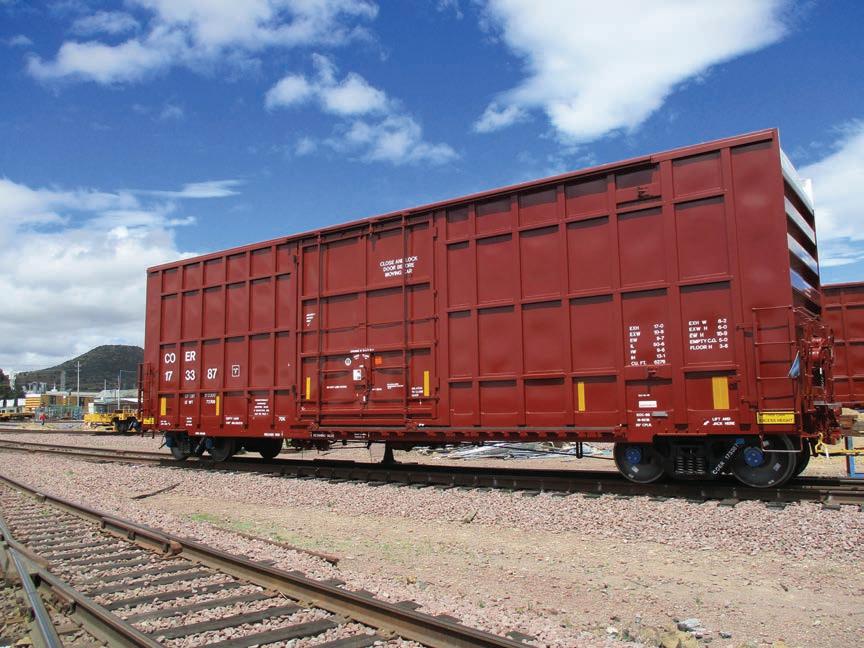
A lease type that’s tailored to your rail activities.
business is unique. That’s why we offer per diem leases tailored to your rail transportation needs. With access to our extensive railcar fleet, you can find solutions to scale your business for market demand – and new opportunities.
started today at citrail.com ©2023 First-Citizens Bank & Trust Company. All rights reserved. CIT and the CIT logo are registered trademarks of First-Citizens Bank & Trust Company. MM#12708
Each
Get










 Marmon On-Site Services Companies
Marmon On-Site Services Companies














 by Frederick J. Aubertin
by Frederick J. Aubertin





































































































































 By David Schaar,
By David Schaar,
 Andrey Timofeev, Pallavi Kansal, Luke H. Young, and Grant Zeller
Andrey Timofeev, Pallavi Kansal, Luke H. Young, and Grant Zeller



















































 BY DAVID PETER ALAN, CONTRIBUTING EDITOR BART
BY DAVID PETER ALAN, CONTRIBUTING EDITOR BART





































